
Issue 7 June 2018 ROAD - RAIL - AIRPORT - PORT - URBAN - UTILITY MICHAEL MCCORMACK DECONSTRUCTS THE FEDERAL BUDGET THE LOGISTICS HUB at the centre of Inland Rail The new SUSTAINABILITY BENCHMARK WHAT DO WE WANT? Skilled workers WHEN DO WE WANT THEM? Yesterday
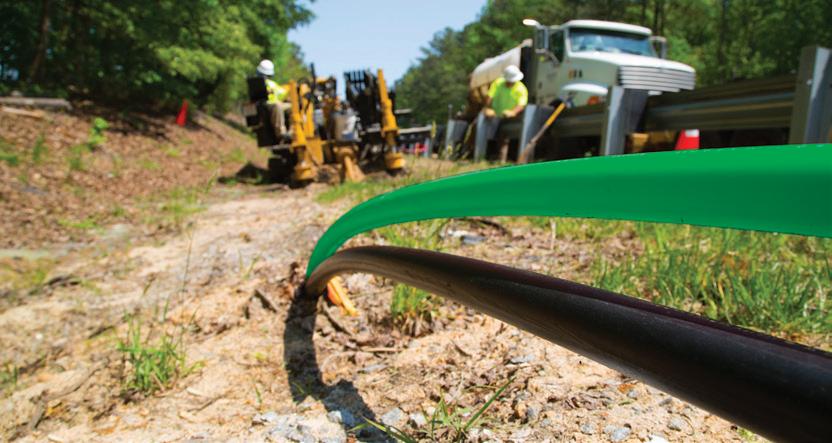

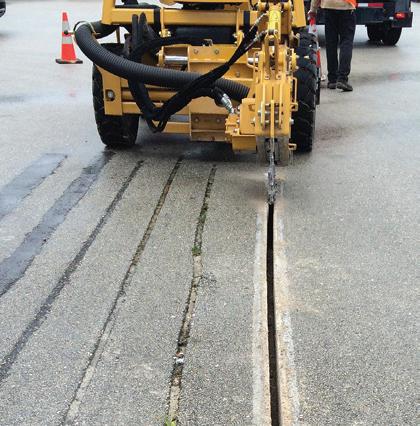
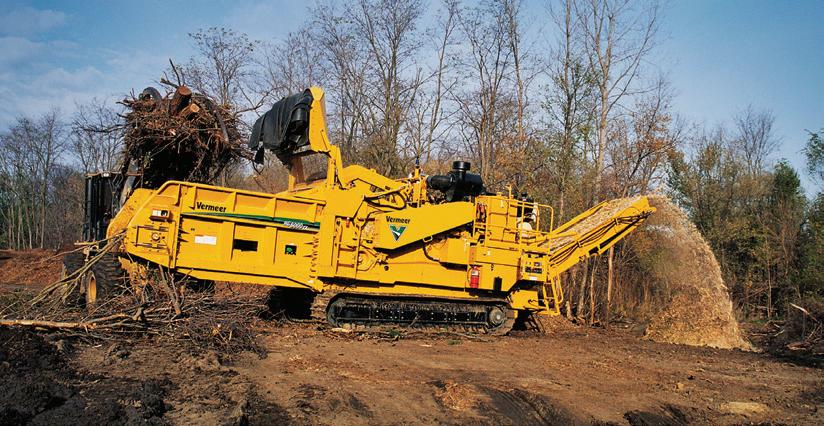









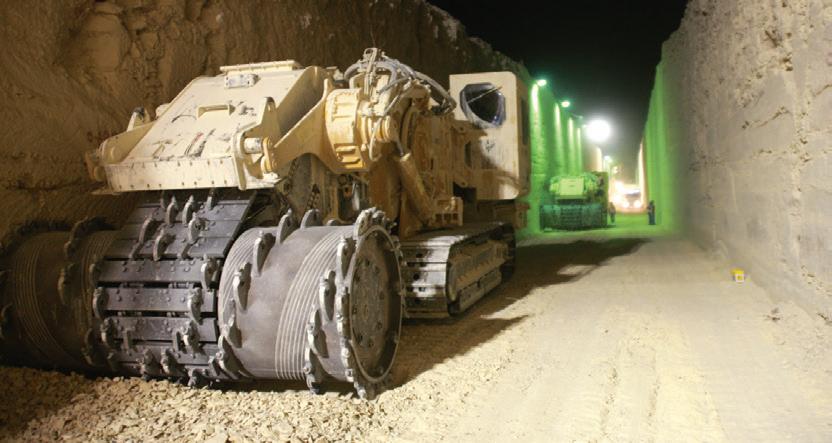


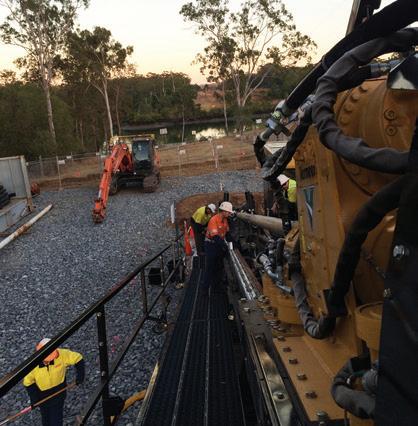
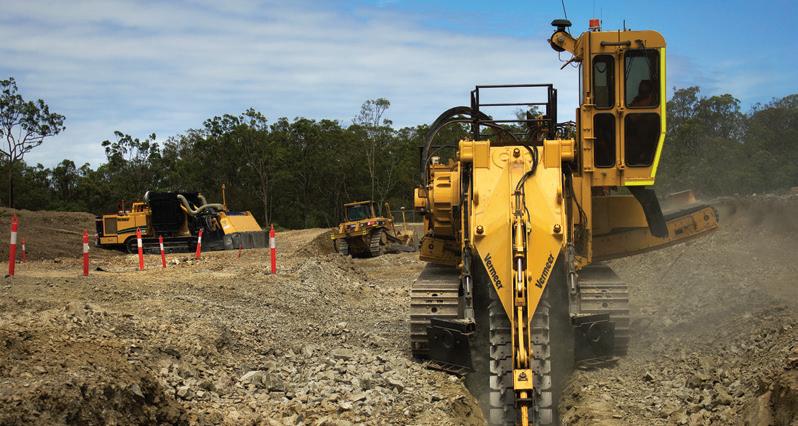

ROAD RAIL TUNNEL UTILITY VERMEER Vermeer and the Vermeer logo are trademarks of Vermeer Manufacturing Company in the United States and / or other countries. © 2018 Vermeer Australia. All Rights Reserved. CONSTRUCTION EQUIPMENT SOLUTIONS FOR AUSTRALIA’S INFRASTRUCTURE INDUSTRY / VermeerAustralia VERMEER.COM.AU | 1300 VERMEER
AS AUSTRALIAN INFRASTRUCTURE PROGRESSES, WE’RE PROUD TO PARTNER WITH THE CONTRACTORS THAT ARE LEADING THE WAY FORWARD.

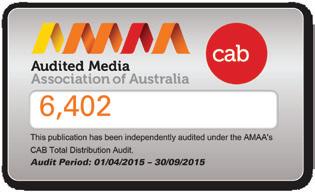
Published by
Monkey Media Enterprises
ABN: 36 426 734 954 PO Box 1763
Preston South VIC 3072
P: (03) 9988 4950
F: (03) 8456 6720
monkeymedia.com.au info@monkeymedia.com.au infrastructuremagazine.com.au news@infrastructuremagazine.com.au
Editor Jessica Dickers
Associate Editors
Lauren Cella
Charlotte Pordage
Journalists
Elisa Iannunzio
Kirsty Hutton
Marketing Associate
Sam Penny
Marketing Manager
Rima Munafo
Marketing Assistant
Helena Brace
Production and Customer Service
Titian Bartlau
Senior Designer
Alejandro Molano
Designer
Jacqui Abela
Publisher Chris Bland
Managing Editor
Laura Harvey
EDITOR’S WELCOME
It’s been about a month since the Federal Government handed down its Budget for 2018/2019 – a budget which saw $24 billion allocated over the next four years for major infrastructure projects, including road and rail investments, and one that has received mixed reviews from the sector.
This funding is included in the $75 billion that will be invested in transport infrastructure projects over the next decade and this financial support for major projects, especially in rail, has been welcomed across the industry. However, investments in projects such as the Port Botany Rail Line duplication, the Brisbane Metro project, Melbourne Airport Rail Link, Bruce Highway, Perth's METRONET program, and the Urban Congestion Fund, among others, have the ability to create challenges around finding enough skilled workers to ensure these projects are delivered. It also brings up issues around ensuring Australia’s transport infrastructure solutions are fully integrated and sustainable in the long term.
The sector’s increasing skills shortage and discussions around sustainability are major considerations across all areas of the industry, with research from the Civil Contractors Federation (CCF) highlighting the need to put in place a civil industry workforce development plan for the future.
Whatever skills solution is implemented, it will also need to have a strong focus on new technologies and equipment in order to fulfil the increasing use and demand for technology. The use of new technologies varies from digital apps that can increase mobility, to forecasting tools that help plan which projects are needed to support rapid population growth, and the technologies that are being used alongside traditional civil equipment such as earthmoving machinery.
Since the last issue of Infrastructure was released, Infrastructure Australia also published its 2018 Infrastructure Priority List, identifying 96 major infrastructure proposals which represent a $55 billion pipeline of investments. The high priority projects identified included the M4 Motorway upgrade - Parramatta to Lapstone; WestConnex; Sydney Metro: City and Southwest; Western Sydney Airport; M80 Ring Road upgrade;
I’m keen to

and the Brisbane Metro, so it’s great to see some of these projects recognised as part of the country’s long-term infrastructure needs.
Having current and planned major projects meet economical, environmental and social sustainability goals is also a focus for a lot of asset owners and contractors, with more emphasis placed on how to plan, build and maintain efficient and resilient assets. One way to measure the success of this has been against the Infrastructure Sustainability Council of Australia’s (ISCA) IS rating scheme, which was recently reviewed and updated following extensive industry collaboration.
These are some key issues that will be discussed at the Asset Management for Critical Infrastructure 2018 Conference, running from 12–13 September in Sydney. The two-day conference will bring together experts from the infrastructure and utility space to discuss some of the biggest issues in the management of Australia’s critical assets. The full program and speaker lineup will be released shortly, so you can stay updated at www. assetmanagementevent.com.au.
Before then, this edition of Infrastructure will be distributed at several upcoming events including the Smart Mobility Show 2018; ISCA’s WA Infrastructure Sustainability Conference; the Inland Rail 2018 Conference in Parkes; the Smart Infrastructure Summit 2018; the Oceania Damage Prevention Conference (ODPC); and ITS Business Networking events in Brisbane and Melbourne. It continues to be an exciting and rapidly evolving time for Australia’s infrastructure and we will continue to look in-depth at all the issues and opportunities that are created.
Jessica Dickers Editor
hear your thoughts and feedback on Infrastructure. Drop me a line at jessica.dickers@monkeymedia.net.au
free to call me on 03 9988 4950 to let me know what you think.
or feel
2206-7906 June 2018 ROAD RAIL AIRPORT PORT URBAN UTILITY INFRASTRUCTURE JUNE 2018 MICHAEL MCCORMACK DECONSTRUCTS THE FEDERAL BUDGET THE LOGISTICS HUB at the centre of Inland Rail The new SUSTAINABILITY BENCHMARK WHAT DO WE WANT? Skilled workers WHEN DO WE WANT THEM? Yesterday 8,313 1 October 2017 - 31 March 2018
ISSN:

REGISTER BEFORE 30 JUNE TO SECURE THE EARLY-BIRD RATE
The Australasian Structural Engineering Conference 2018 will explore the theme 'Engineering Our Future' and will cover a diverse range of topics of relevance to practising structural engineers, students, academics, researchers and industry specialist providers.
Invited national and international keynote speakers will inspire and provide invaluable knowledge on modern materials, methods, innovation and the future direction of engineering. Topics expanding the conference theme of interest to delegates are listed below:
• Challenging the normal
• Modern Methods and Materials
• Engineering for Extreme Events
• Forensic Engineering – Lessons from failure or success
• The Large – The Complex
• Structural Health Monitoring
Keynote Speakers




Faith Wainwright
President, Institution of Structural Engineers
Prof. Kourosh Kayvani
Global Director of Excellence & Expertise, Aurecon
Prof. Stefano Pampanin
Department of Civil and Natural Resources Engineering, University of Canterbury, New Zealand
Prof. Robert Melchers
School of Engineering (Civil), University of Newcastle

Preliminary Program now available: www.aseconference.org.au SUPPORTED BY ENGINEERS AUSTRALIA STRUCTURAL COLLEGE ORGANISED BY Gold Sponsors Silver Sponsor Lanyard & Name badge Sponsor Coffee Cart Sponsor



ASSET MANAGEMENT
ASSET MANAGEMENT FOR CRITICAL INFRASTRUCTURE RETURNS IN 2018
The return of the Asset Management for Critical Infrastructure Conference for its second year will include the addition of an exhibition, new targeted streams and in-depth discussions with a new lineup of industry experts.
INDUSTRY INSIGHT
A RAIL REVIVAL AND CONGESTION BUSTING PROJECTS
As you are keenly aware, transport infrastructure connects people to jobs, their homes and their communities, and allows Australian businesses to connect to domestic and global export markets. But the task is escalating.
INVESTMENT & FINANCING
A CLOSER LOOK AT BUDGET FUNDING: HOW THE INDUSTRY RESPONDED
Over the next decade more than $75 billion will be invested in transport infrastructure projects, with $24 billion allocated as part of the 2018/2019 Federal Budget to be spent over the next four years. The major road and rail investments that received funding aim to reduce congestion in the face of a rapidly growing population.
SUSTAINABILITY
THE BENCHMARK FOR SUSTAINABILITY HAS SHIFTED
SKILLS & TRAINING
MEETING THE DEMAND AND SUPPLY OF CIVIL CONSTRUCTION SKILLS
There is no doubt that the civil industry in Victoria is experiencing significant challenges and there are many reports that provide evidence and statistical data validating the urgent need to put in place a civil industry workforce development plan.
WHY IS ENGINEERING NOT ATTRACTIVE TO FUTURE BUILDERS?
BRINGING PAVEMENT DESIGN INTO THE FAST LANE
SENSING CHANGE – UAVS TO REVOLUTIONISE UTILITY MANAGEMENT
NEW PERSPECTIVE ON DRONES AND INSPECTION TECHNOLOGY
PLANNING FOR POPULATION GROWTH: FORECASTING TOOL FOR GOVERNMENTS AND UTILITIES
SMART TRANSPORT DRIVEN BY UNIFIED CRITICAL COMMUNICATIONS
NATIONAL MAGNET CONFERENCE
4 June 2018 // ISSUE 7 www.infrastructuremagazine.com.au CONTENTS
HOW SUSTAINABILITY CAN BE DELIVERED: A CASE STUDY REUSING COMMONWEALTH GAMES INFRASTRUCTURE SUSTAINABLY
14 32 36 40 16 41 44 42 46 47 ASSET INSPECTION & DRONES/UAVS SMART INFRASTRUCTURE 20 24 26 28


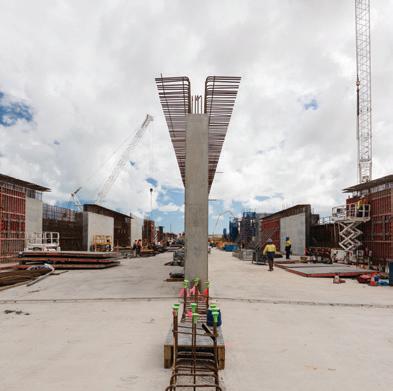
TOO MUCH OF A GOOD THING? EARTHMOVING INDUSTRY OUTLOOK 2018/2019
MAXIMISING PRODUCTIVITY AND EFFICIENCY ON TELECOMMUNICATION PROJECTS
TOLLING
SCENARIO 2028 – THE TOLLING INDUSTRY IN TEN YEARS
EARTHMOVING OUTLOOK VICROADS
5 www.infrastructuremagazine.com.au June 2018 // ISSUE 7 CONTENTS
REGULARS 02 EDITOR’S WELCOME 06 CONTRIBUTORS 80 ADVERTISERS’ INDEX 80 FEATURES SCHEDULE NEWS 50 54 08 MAJOR PROJECTS ADDED TO PRIORITY LIST 09 $400 MILLION FOR PORT BOTANY RAIL LINE 10 FINAL STAGE
LINK APPROVED 11 FUNDING
AIRPORT RAIL LINK 12 PORT
CONTRACT
12 FREIGHT PRIORITIES IDENTIFIED
OF WESTCONNEX
FOR MELBOURNE
OF PORT HEDLAND
AWARDED
RAIL NOISE AND
MOBILITY
VIBRATION
PORTS AIRPORT THE
OUR
PARKES
AUSTRALIA'S TRANSPORT FUTURE BUCKLE
SAFETY LEVEL
HIGHEST
NATIONAL
FROM INNOVATIVE TECHNOLOGY FULL
WHAT
TECHNOLOGIES TACKLING CONGESTION ON
ROADS
– THE CENTRE OF
UP – MODIFYING VICTORIA’S ROADS FOR
CROSSING SYSTEMS FOR THE
DEMANDS
RAILWAYS BENEFIT
STEAM AHEAD FOR SYDNEY’S METRO MILESTONES
MOBILITY AS A SERVICE COULD MEAN FOR AUSTRALIA
THINKING
OVERCOMING AIRPORT UNDERPASS ENGINEERING CHALLENGES 60 64 62 67 68 70 48 56 72 76
DOMESTICALLY AT OUR PORTS
Contributors
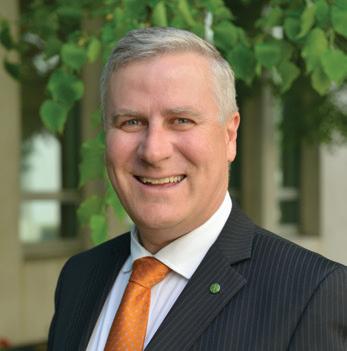
Michael McCormack
Deputy Prime Minister, Minister for Infrastructure and Transport
Prior to entering Parliament, Michael began professional life as a cadet with The Daily Advertiser. At the age of 27 he was appointed to the newspaper’s editorship, becoming the youngest person appointed to edit a daily newspaper in Australia at the time. During his career at the newspaper, Michael was a champion of many community issues.
Michael was elected as The Nationals’ Member for Riverina in 2010.
Following the 2013 Federal Election, Michael was appointed Parliamentary Secretary to the Minister for Finance and in September 2015 he was then appointed Assistant Minister to the Deputy Prime Minister. In this role, Michael worked alongside then Nationals’ Leader and Deputy Prime Minister, the Hon Warren Truss, in the administration of regional development programs.
Following the announcement of Mr Truss’ retirement in February 2016 Michael become the Assistant Minister for Defence and after the 2016 Federal Election, Michael was appointed to the Ministry as the Federal Small Business Minister. In early 2018, Michael became the 14th Leader of The Nationals and the 18th Deputy Prime Minister of Australia.
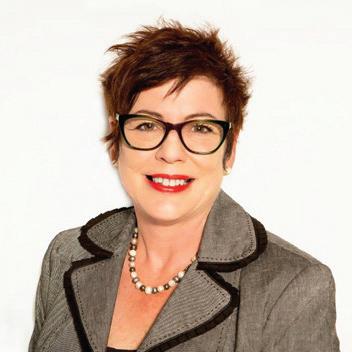
Sonya Casey
Project Officer - Training, Civil Contractors Federation (CCF)
Sonya Casey has been contracted by CCF Victoria, on behalf of the Victorian State Government, to undertake specific research and test remedial approaches into Apprenticeship and Traineeship attraction and retention within the civil industry sector. Her work has led to the development of the four stage Civil Skills Cadetship (CSC) program and leveraging career opportunities under the Youth Job paTH program with the Commonwealth Government.
At the time of writing this article, CCF Victoria has submitted a revised grant funding application of $2.66 million to the Victorian State Government’s Workforce Training & Innovation Fund (Skills First) initiative for the implementation of the CSC program targeting 120 candidates over the next two year period.
6
Contributors
 Mike Gallacher CEO, Ports Australia
Mike Gallacher CEO, Ports Australia
Following an intensive and varied 16 year career as a Police Officer, Mike Gallacher was appointed to the NSW Legislative Council in 1996. He has been the Shadow Ministerial for a variety of portfolios including Ports, Industrial Relations, Transport and Police. Winning government in 2011, Mike was appointed Minister for Police and Emergency Services, Minister for the Hunter, and later the further role of Minister for Industrial Relations.
Mike is widely recognised for his robust approach to policy development and his preparedness to strongly advocate the need for reform. As Minister he led on behalf of government the public debate on issues such as measures to reduce alcohol related violence, rampant gang/gun related crime and introduced initiatives to change driver behavior. Leaving Parliament in 2017, he has now taken the role as CEO of Ports Australia, the peak industry body for the ports industry.
Dr Collette Burke
Chief Engineer of Victoria, Managing Director at Exner Group, and Director at VicTrack
Collette has spent more than 25 years in the engineering and construction industry with major contractors moving through a variety of roles from site engineer, executive manager to managing director of many organisations. She is an internationally acknowledged researcher, with a PhD in risk management and value for money on major infrastructure projects. Her passion to give back to the industry has lead to the creation of engineering consultancy and education firms, Exner Group and Karsta in the Middle East, in the position of Managing Director. Collette was also the former National Director of the National Association of Women in Construction (NAWIC), with a focus on building skills through education for members in the industry. She has since been appointed a Director of VicTrack and Victorian Chief Engineer.
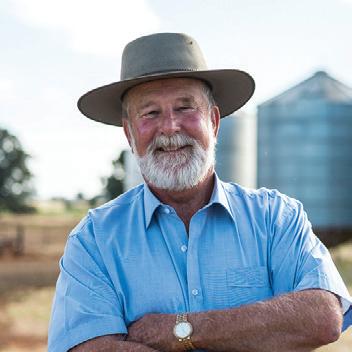
Ken Keith OAM
Mayor, Parkes Shire Council
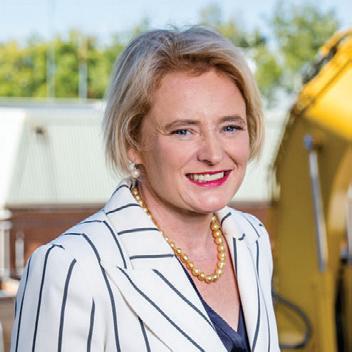
Parkes Shire Mayor Ken Keith OAM is currently serving his 11th term on Council and was first elected as a councillor in 1983. Born in Parkes, Mayor Keith was educated at Yanco Agricultural High School, before studying a Bachelor of Science in Agriculture at the University of Sydney where he specialised in agricultural education. During his time on council, Ken has been dedicated to delivering the community’s vision of becoming a progressive and smart regional centre, embracing a National Logistics Hub with vibrant communities, diverse opportunities, learning and healthy lifestyles.
Ken currently chairs the Melbourne to Brisbane Inland Rail Alliance (MBIRA), which is made up of local governments along or adjacent to the proposed Melbourne to Brisbane Inland Rail route. The MBIRA proactively advocated and lobbied the Australian Government to commit to the delivery of Inland Rail.
Ken is also passionate about improving the connectivity of our region’s broader transport network as the Chair of the Newell Highway Taskforce and the Central NSW Council (CENTROC) Strategic Transport Group, as well as being a member of the Rural Roads Advisory Group, Roads and Maritime Services Regional Consultative Committee and Western Region Joint Regional Planning Panel.
7

Infrastructure Australia released its 2018 Infrastructure Priority List, identifying a $55 billion pipeline of infrastructure investments for the country’s cities and regions.
The 2018 list identifies 96 major infrastructure proposals, including six High Priority Projects, six Priority Projects, 24 High Priority Initiatives and 60 Priority Initiatives.
High Priority Projects include:
MAJOR PROJECTS ADDED TO PRIORITY LIST
♦ M4 Motorway upgrade - Parramatta to Lapstone (NSW)
♦ WestConnex (NSW)
♦ Sydney Metro: City and Southwest (NSW)
♦ Western Sydney Airport (NSW)
♦ M80 Ring Road upgrade (VIC)
♦ Brisbane Metro (QLD) Priority Projects include:
♦ Inland Rail - Melbourne to Brisbane via inland NSW
♦ The Northern Road upgrade (NSW)
♦ Beerburrum to Nambour Rail Upgrade (QLD)
♦ Myalup-Wellington Water Project (WA)
♦ Eyre Infrastructure Project - Iron Road (SA)
♦ Hobart Science and Technology Precinct (TAS)
Infrastructure Australia Chair, Julieanne Alroe, said, “In the 10 years since Infrastructure Australia was formed, the Priority List has helped establish a longer-term view of our collective needs as a nation — one that enables our leaders to look beyond elections and budgetary cycles, and make evidencebased investment decisions.”
The list also identifies new initiatives to improve rail network capacity in Sydney, Melbourne and Perth to meet unprecedented demand in these growing capital cities.
The list is based on the Australian Infrastructure Audit and more than 500 submissions from governments, stakeholder groups and the community, and is the authoritative list of nationally-significant infrastructure investments Australia needs over the next 15 years.
Reflecting the demands of a growing population, Australia’s cities and public transport needs are a major focus of the revised Priority List.
“New investment-ready projects like the $1 billion Brisbane Metro and the $800 million Beerburrum to Nambour Rail Upgrade in South East Queensland have been prioritised because of their potential to deliver national productivity gains,” Ms Alroe said.
Deputy Prime Minister and Minister for Infrastructure and Transport, Michael McCormack, said the Priority List is critical in informing all levels of government and the private sector on what priority projects and initiatives are under development across the country.
“I am particularly pleased to see the addition of two major Queensland projects to the list following the assessment by Infrastructure Australia as having the potential to improve connectivity and reduce urban congestion,” Mr McCormack said.
Minister for Urban Infrastructure, Paul Fletcher, said the updated Priority List provided important input into the government’s deliberations on which major national infrastructure projects should receive federal funding.
June 2018 // ISSUE 7 www.infrastructuremagazine.com.au 8 NEWS
$400 MILLION FOR PORT BOTANY RAIL LINE
The Federal Government will provide $400 million to duplicate the remaining single-track section of Sydney’s Port Botany Rail Line, as well as a passing loop at Cabramatta, allowing trains to pass.
Duplicating the Botany line will improve freight movement on Sydney’s rail network and encourage a shift in freight from road to rail — reducing traffic congestion in and around Sydney Airport and Port Botany.
Listed by Infrastructure Australia as a High Priority Initiative, this critical project will strengthen rail connection efficiency, improve freight transit times and increase service reliability for the Sydney region.
“This is a vital upgrade to ease pressure on Sydney’s transport system. It will enable freight to be moved faster and easier — allowing businesses to get goods to market faster — and it will ease traffic around the airport by taking more heavy vehicles off the road,” Prime Minister, Malcolm Turnbull said.
The Australian Rail Track Corporation will deliver the project on behalf of the Australian Government. It will support about 150 jobs during construction.
The project will include new rail bridges, civil works and duplicated rail tracks across the 2.9km length of the freight line between Mascot and Botany, along with the construction of a 1.4km passing loop between Cabramatta and Warwick Farm.



The commitment will support the freight logistics and supply chain activities of existing intermodal terminals such as at Enfield and Chullora, as well as the new terminal under construction at Moorebank.
NSW Ports welcomed the confirmation of funding; NSW Ports CEO, Marika Calfas, said about 440,000 TEU each year travel by rail to and from Port Botany and this volume is growing.
“Completing the duplication of the Port Botany freight line will ensure reliability of freight rail access to Port Botany and resilience in the event of disruption on the single track.
“We have a target to move three million TEU by rail in the long term. The duplication of the freight line is essential to achieve this objective and will benefit Sydney with reduced volumes of trucks on roads around the port.
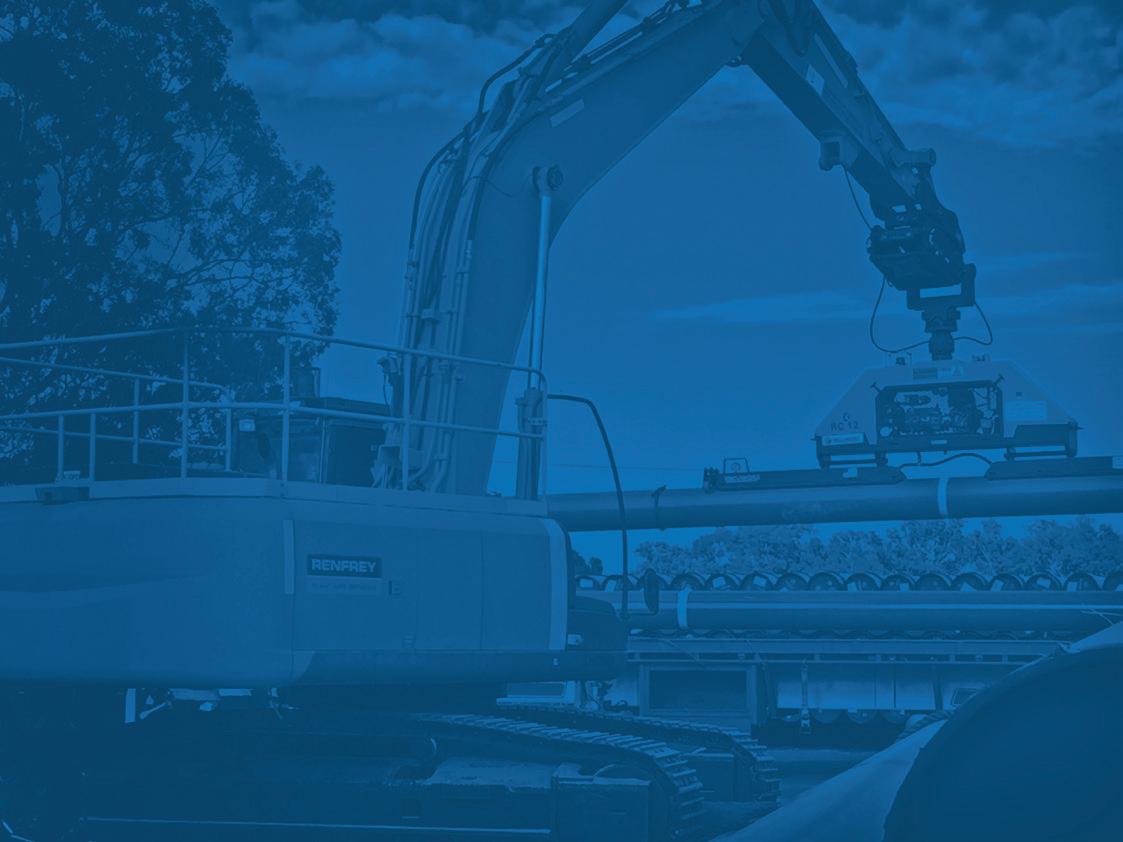


www.infrastructuremagazine.com.au 9 NEWS
FINAL STAGE OF WESTCONNEX LINK APPROVED

The third and final stage of WestConnex, linking the M4 and M5 motorways, has been approved by the NSW Government, and will complete Australia’s largest road project.
Minister for Planning and Housing, Anthony Roberts, said the most critical section of WestConnex joins the M4 tunnel at Haberfield with the M5 at St Peters, as well as the Iron Cove Bridge and Rozelle Interchange.
“This project will join the two motorways, taking thousands of trucks off Parramatta Road, providing connections from the west and southwest, and saving commuters and tradies hours of travel time each week,” Mr Roberts said.
“Traffic congestion currently costs the NSW economy $5.1 billion a year and this is expected to increase to $8.8 billion by 2020 if improvements are not made.
“The M4-M5 link is part of a comprehensive range of road and public transport projects that are all connected and will make Sydney a much better place to live.”
Mr Roberts said the project included the transformation of the disused Rozelle Rail Yards into a 10 hectare park with green space, footpaths and cycleways.
“This new park will include pedestrian and cyclist connections between communities, including a bridge linking the open space at Rozelle to the foreshore parks adjacent to Rozelle Bay
at Annandale,” he said.
Minister for WestConnex, Stuart Ayres, said the delivery of the M4–M5 tunnel link is central to the success of Sydney’s future transport network.
“Like the Sydney Harbour Bridge did for the North Shore, the M4–M5 Link will bridge a major gap in the road network, creating a non-stop underground western bypass of Sydney’s CBD, slashing travel times and delivering over 18 hectares of open space for local communities.”
Strict conditions have been set to reduce impact on locals during construction and operation. To address traffic impact during construction, it will be mandatory for spoil haulage trucks to be fitted with GPS devices to allow for accurate monitoring with restrictions on local roads.
The GPS tracking will assist the department in its regulatory role by providing evidence of truck movements. There will also be a truck marshalling yard to further reduce disruptions.
There will be opportunities for ongoing community involvement in the design of the project such as community input into the Urban Design and Landscape Plan, and involvement on the Air Quality Community Consultative Committee.
The conditions of approval also require compulsory, ongoing reporting and review of strict compliance standards. Quarterly compliance reports will be made available to the community on the projects website.
June 2018 // ISSUE 7 www.infrastructuremagazine.com.au 10 NEWS
FUNDING FOR MELBOURNE AIRPORT RAIL LINK
The Federal Government has announced it will provide $5 billion in funding to help build the Melbourne Airport Rail Link. Melbourne Airport welcomed the news of the government’s funding commitment for the long-awaited rail line to Melbourne’s CBD. Chief Executive, Lyell Strambi, said the twin challenges of growth and congestion required transformative infrastructure investment.
“A global city like Melbourne deserves world-class infrastructure, including transport links. With a growing population and increasing numbers of international visitors, it’s vital that our city’s transport infrastructure continues to support the rapid growth in the north and west.
“An airport rail link could be part of an expanded transport network that would change the face of Melbourne.
“A rail link can help us to realise the full potential of Melbourne Airport, injecting enormous value into the Victorian and national economies, creating and supporting jobs for the local community and putting the world within reach for
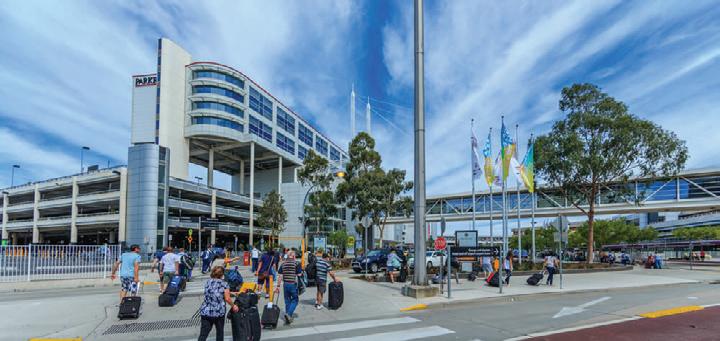
millions of Victorian travellers.”
The Australasian Railway Association (ARA) CEO, Danny Broad, said a rail link between Melbourne Airport and the CBD is vital.
“The ARA is of the view that any proposed route will need to consider the highest frequency for commuters journey time so it is to compete with other modes of travel and be accessible to commuters who travel to large regional centres, including Geelong, Ballarat and Bendigo.
“Infrastructure Australia has already identified the corridor between Melbourne CBD and the Melbourne Airport as one of the most congested,
and one where the Tullamarine Freeway is already at capacity.
“The rail corridor between the Melbourne Airport to CBD was identified by Infrastructure Australia as a priority initiative, and the rail industry and the Victorian community are ready for this investment – The time is now.”
Roads Australia Chief Executive, Ian Webb, also welcomed the funding announcement.
“A rail link will be great news for everyone travelling to and from the airport, and complement the work that is currently being done to upgrade CityLink and the Tullamarine Freeway,” Mr Webb said.
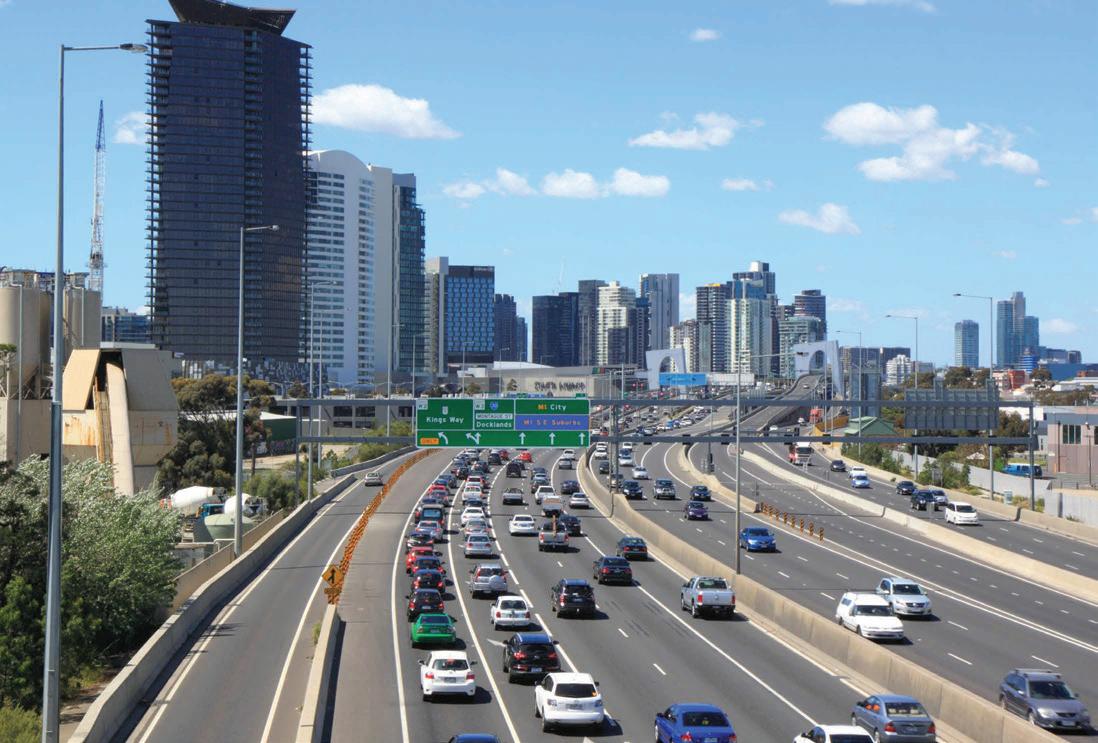
www.infrastructuremagazine.com.au June 2018 // ISSUE 7 11
NEWS
Unified Communications for Smart Transport www.simocowirelesssolutions.com inquiry.aus@simocowirelesssolutions.com Tel: +61 1300 363 697
PORT OF PORT HEDLAND CONTRACT AWARDED
Pilbara Ports Authority (PPA) has awarded the contract for demolition and construction work for the Port of Port Hedland Berth 3 Deck Replacement project.
York Civil was the successful tenderer for the project which will see the demolition of the existing concrete deck and adjacent storage shed, construction of a new reinforced concrete deck, installation of new wharf fenders and other ancillary works.
The demolition and construction works will require periodic closure of Berth 3, anticipated to occur between September 2018 and June 2019. PPA has been working closely with customers and port users to minimise impacts on shipping during this time.
Berth 3 is a multi-user berth primarily used for the export of salt and the import of fuels to service the Pilbara region. It was originally constructed in the 1960s.
The Berth 3 Deck Replacement project will facilitate ongoing trade from the Pilbara, and sustain local jobs and local industry as far as possible.

The Berth 3 Deck Replacement project is a pilot project under the WA Industry Participation Strategy (WAIPS).
WAIPS is designed to maximise opportunities for Western Australian businesses to secure work on government contracts, promote increased apprenticeship, training and
Tjob opportunities in Western Australia, and raise awareness of local industry capabilities.
York Civil proposed high Pilbara region and WA-based content in undertaking the works. PPA will monitor York Civil’s local content participation for the duration of the project delivery.
FREIGHT PRIORITIES IDENTIFIED
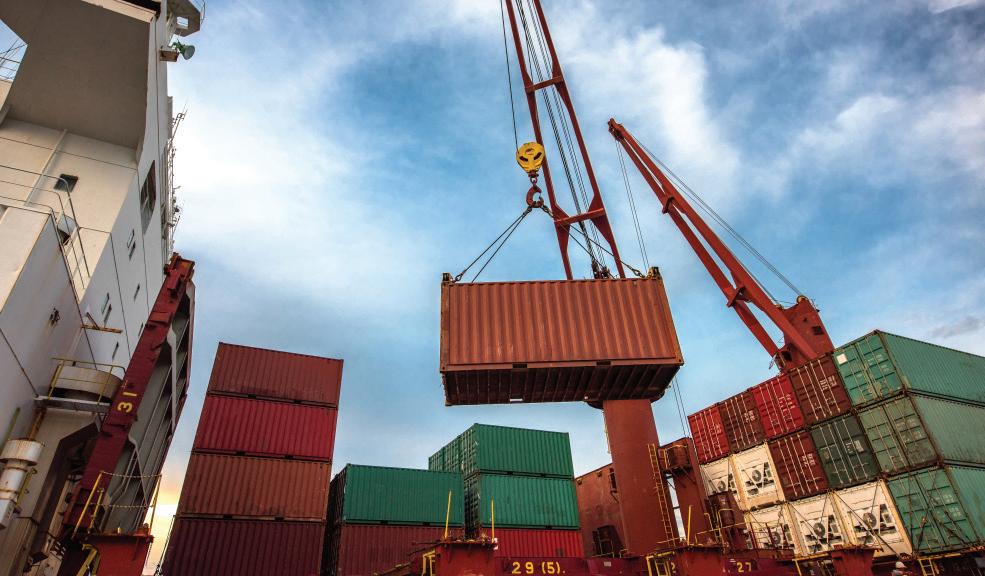
he Australian Government has released the Inquiry into National Freight and Supply Chain Priorities Report which makes 54 recommendations relating to transport modes operating in Australian freight logistics.
The Inquiry Report sets out 54 priority actions for governments to take in relation to investment, reform and governance of Australia’s freight industry.
The Independent Expert Panel developed the report with significant industry input, including drawing on 127 submissions and one-on-one meetings with more than 200 individuals from 28 peak industry bodies and 90 businesses. It concluded strong support exists within industry for an overarching national strategy.
The Australian Logistics Council (ALC), which released a final submission, Freight Doesn’t Vote, as part of the inquiry, said the recommendations show the huge task facing governments and industry in
the development of an effective National Freight and Supply Chain Strategy.
“The report articulates the challenges that are hampering greater supply chain efficiency and safety: a lack of data, antiquated planning practices, poorly coordinated infrastructure investment and poor appreciation of freight’s economic importance,” ALC Managing Director, Michael Kilgariff, said.
“This report now gives all governments the opportunity to work cooperatively to develop a coherent and effective Strategy that addresses each of these priority areas.”
A key recommendation in the report is for the establishment of an Industry Advisory Group to monitor progress in implementing the strategy.
Minister for Infrastructure and Transport, Michael McCormack, said the report paves the way for the development of a strategy which improves the competitiveness of Australian businesses and delivers for
consumers by making it faster, easier and less expensive to move goods.
“We know the national freight task will almost double over the next 20 years, which presents a challenge and opportunity to work with industry to maximise the benefit from the sector which already contributes around ten per cent of our productivity,” Mr McCormack said.
The Australasian Railway Association (ARA) welcomed the release of the report, which it said also reflects many of its policy priorities, particularly in the areas of corridor protection, heavy vehicle pricing, short haul rail, consistency between state and federal plans, and improved land use planning.
“The final report provides a range of recommendations across the critical areas of investment, governance and reform which are critical to improving the efficiency and productivity of the freight rail sector,” ARA CEO, Danny Broad, said.
June 2018 // ISSUE 7 www.infrastructuremagazine.com.au 12 NEWS


Responsibility towards mankind, nature and the economy: Systematic stormwater management. For more information, please contact - stephen.herd@fraenkische.com www.rigofill-st.com www.fraenkische.com/en/group/drainage-systems INTEGRATED STORMWATER
Where Stormwater falls on impervious surfaces, it cannot drain away easily. FRÄNKISCHE have developed comprehensive drainage systems, that have been modelled from nature, that integrate with WSUD principles, ensuring a reliable and efficient collection, treatment, storage and discharge of stormwater in any terrain.
www.fraenkische.com TRANSPORT TREATMENT STORAGE DISCHARGE TRANSPORT TREATMENT STORAGE DISCHARGE TRANSPORT TREATMENT STORAGE DISCHARGE TRANSPORT TREATMENT STORAGE DISCHARGE 4
1 solution
challenges –
SYSTEMS
THE BUILT ENVIRONMENT CREATING SPACE FOR WATER
MANAGEMENT
FOR
12-13 September 2018
Swissôtel Sydney assetmanagementevent.com.au
ASSET MANAGEMENT FOR CRITICAL INFRASTRUCTURE RETURNS IN 2018
The return of the Asset Management for Critical Infrastructure Conference for its second year will include the addition of an exhibition, new targeted streams and in-depth discussions with a new lineup of industry experts.
The two-day conference, running from 12–13 September in Sydney, is the place to be for news and updates on technologies, projects and processes that help to better manage critical assets in Australia, from water pipes and energy networks, to railway tracks, airports and port infrastructure.
It’s the only event where different sectors come together to give delegates the opportunity to hear about each others successes and learn from past mistakes. Past attendees have highlighted the benefits of seeing what others are doing in the asset management space and how they have overcome similar challenges.
Sometimes all it takes is to see what someone else is doing to spark an idea or innovation, with delegates able to take these ideas back to their organisations.
WHAT’S NEW FOR 2018?
DEDICATED STREAMS AND PANELS
Day One will feature individual presentations exploring asset management challenges and solutions, technologies and processes across the utility and infrastructure sectors. Day Two takes this a step further and splits the conference into dedicated streams so delegates can delve deeper into their chosen area of interest or specialty. These streams will run as long moderated panel sessions to give a broader scope into the topics.
This year’s streams include:
♦ Rail
♦ Corrosion
♦ Trenchless
♦ Renewables
EXHIBITION SHOWCASE
The 2018 conference will include the addition of an exhibition, which will see leading asset management, technology, utility and infrastructure companies highlighting some of the newest products and innovations in the sector.
NEW EXPERT SPEAKER LINEUP
The lineup of speakers will include senior figures from infrastructure asset owners, Australia’s water and power utilities, as well as representatives from government and key industry bodies. Speakers will represent sectors including water, energy, rail, airport, roads and ports. The event will also be MC’d by Steve Doran, Director of Infrastream and Chair of the Sydney Chapter of the Asset Management Council, who is an expert in achieving innovation in asset management.
MORE NETWORKING OPPORTUNITIES
In addition to networking opportunities in breaks and at the networking drinks after Day One, the event will also feature multiple speed networking sessions where delegates are guaranteed introductions to like-minded colleagues from their industry. This structured and fun activity will get conversations flowing and allow delegates to make new connections.
WHAT TO EXPECT?
This year, you can expect presentations and panel discussions on topics such as:
♦ Big data, data analytics and technological disruption
♦ How to combat corrosion
♦ Using trenchless technologies to your advantage
♦ Predictive maintenance
♦ How to implement new technologies such as drones and VR/AR
♦ Utilising the Internet of Things (IoT) across your organisation
♦ ISO 55000 - the asset management standard
♦ Achieving sustainable asset management
♦ Asset management best practices, and so much more!
June 2018 // ISSUE 7 www.infrastructuremagazine.com.au
14
ASSET MANAGEMENT
INDUSTRY EXPERTS
The full program and lineup will be released shortly. Here are some of the first round speakers from across the asset management sector.

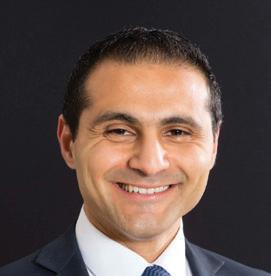

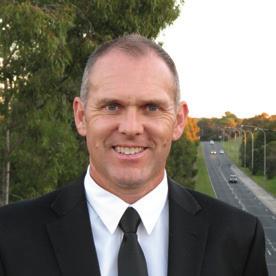

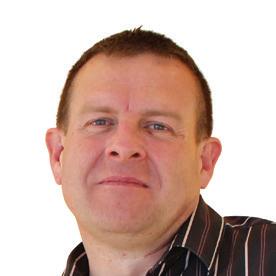
For more information or to register, please visit www.assetmanagementevent.com.au.
www.infrastructuremagazine.com.au June 2018 // ISSUE 7 15 ASSET MANAGEMENT
Ivan Beirne Asset Knowledge and Performance, Unitywater
Mina Gerguis Asset Program Manager, Victrack
Steve Doran Director, Infrastream Chair of the Asset Management Council’s Sydney Chapter
Scott Stevens Principal Engineer Civil, Operations and Service Delivery, Queensland Urban Utilities
Bonnie Ryan Senior Manager, GS1 Australia
Paul Higham Head of Service Planning and Asset Strategy, Sydney Water

A RAIL REVIVAL AND CONGESTION BUSTING PROJECTS
By Michael McCormack, Deputy Prime Minister, Minister for Infrastructure and Transport
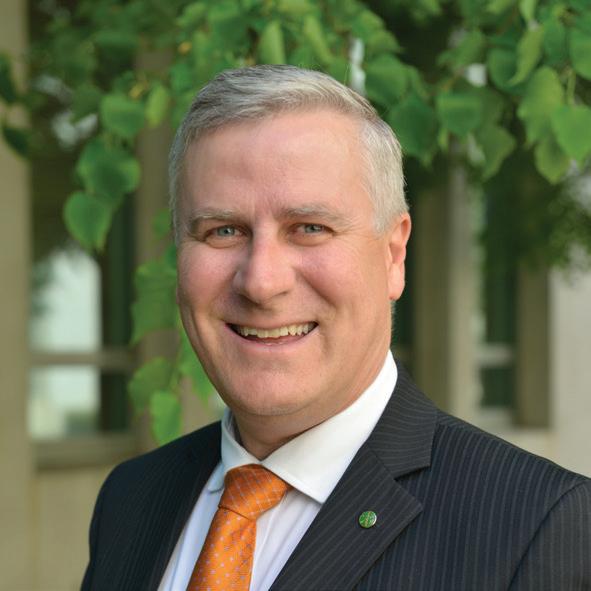
16
INDUSTRY INSIGHT
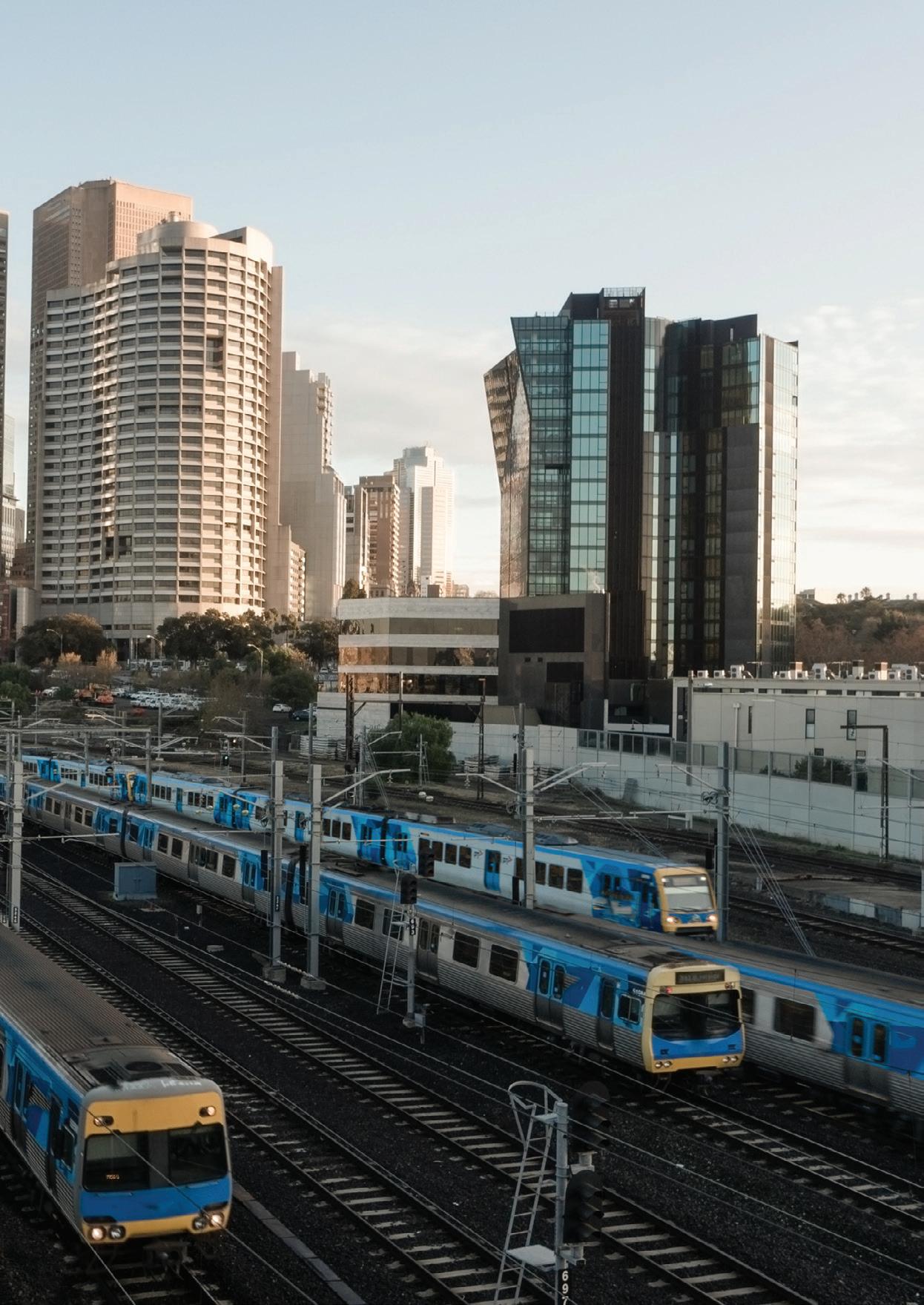
17 INDUSTRY INSIGHT
As you are keenly aware, transport infrastructure connects people to jobs, their homes and their communities, and allows Australian businesses to connect to domestic and global export markets. But the task is escalating.
Australia’s population is forecast to grow to around 29 million over the next decade and that means the demand for goods and services delivered through a safe and efficient supply chain will also continue to grow. At the same time, our cities remain the engine rooms of our economy, but our urban transport networks are increasingly congested, with the daily gridlock negatively impacting on productivity and the quality of urban life.
It is for these critical reasons that investment in transport infrastructure, including congestionbusting projects and a rail revival, is a core focus for the Liberal and Nationals Government.
Our commitment is emphasised in the 2018-19 Budget, with a pipeline of $75 billion over the next decade for investment in new and upgraded transport infrastructure. This figure includes a new $1 billion targeted Urban Congestion Initiative to remediate pinch points, improve traffic safety and increase network efficiency for commuters and freight movement in urban areas.
Everything we are doing is trying to help people get home sooner and safer.
We are also investing $3.5 billion over the next decade through the new Roads of Strategic Importance Initiative (ROSI). ROSI will deliver works such as road sealing, flood immunity, strengthening and
widening, pavement rehabilitation, bridge and culvert upgrades, and road realignments—opening up corridors to provide a more reliable road network, improve access for higher capacity vehicles, better connect regional communities, and facilitate tourism opportunities.
ROSI reserves $1.5 billion for projects in Northern Australia, acknowledging the importance of this region and allowing the Government to build on the benefits being delivered through the Australian Government’s Northern Australia Roads Program and Northern Australia Beef Roads Program.
Tasmania will receive $400 million for roads such as the Bass Highway, $100 million has been committed to

June 2018 // ISSUE 7 www.infrastructuremagazine.com.au 18 INDUSTRY INSIGHT
improve access from regional New South Wales to the Australian Capital Territory via the Barton Highway, and Western Australia will receive $220 million for the Bindoon Bypass. Investment on this scale will drive the national economy and support jobs and economic growth in urban and regional areas by ensuring Australian industries remain globally competitive across all sectors.
FUTURE-PROOFING OUR ECONOMY
In my dual roles as Deputy Prime Minister and Minister for infrastructure and Transport, I am proud to be able to say the Government is getting on with the job of delivering the major infrastructure projects, which are critical in meeting future challenges and opportunities.
Our current investments are already delivering significant economic benefits to urban and regional areas across Australia. However, without major new investments, construction activity would suffer a significant decline from the early 2020s as current projects are completed.
To avoid such a downturn and to future-proof our economy, we have committed to a new 10-year Infrastructure Investment Pipeline.
The pipeline is a list of nationallysignificant land transport priorities in our major cities and across regional Australia. It has been developed by identifying serious transport network deficiencies that have the potential to constrain commuter and freight movements across both urban and regional Australia.
Practical solutions have been identified, informed by the advice of Infrastructure Australia — the Government’s independent infrastructure advisory body — through its Infrastructure Priority List and State and Territory Governments' locally-focused infrastructure strategies.
The pipeline will see substantial investment in urban road and rail initiatives and will provide certainty to the construction industry, facilitating the retention of a skilled workforce and enabling the creation of approximately 50,000 additional
jobs over the next decade. The pipeline is also dynamic. New projects will be added as more priorities are identified through ongoing analysis and engagement with the State and Territory Governments and the private sector.
The pipeline will see substantial investment in urban road and rail initiatives and will provide certainty to the construction industry, facilitating the retention of a skilled workforce and enabling the creation of approximately 50,000 additional jobs over the next decade.
The pipeline of future infrastructure priorities has been called for by our communities, investors and the construction industry. Key projects include the Melbourne Airport Rail Link, METRONET in Perth, the Coffs Harbour Bypass on the Pacific Highway, and the Beerburrum to Nambour Rail Upgrade in Queensland.
In delivering the pipeline, the Government will ensure that all jurisdictions pay their fair share of the costs. Acknowledging the national productivity benefits that can be delivered through investment in key freight corridors, the Government will commit up to 80 per cent of the delivery costs of regional projects.
We will partner with State and Territory Governments on a 50:50 basis for major initiatives in our cities. In some cases, for instance where funding is for a rail freight initiative through the Australian Rail Track Corporation, the Government will be the sole contributor.
THE NEXT PHASE OF GOVERNMENT INVESTMENT
While it is important that our investment pipeline establishes our plan for Commonwealth-funded
priorities over the next 10 years, it is also essential that there is support to plan for the next phase of Government investment. Planning and business case development is a critical period in project delivery, often commencing many years before construction can start – especially when community consultation and complex engineering are required.
Accordingly, robust governance measures will be put in place to ensure that Australians get value for money for the investments we make on their behalf. This includes the establishment of a $250 million Major Project Business Case Fund.
Major projects will be subject to a vigorous business case assessment process before the Australian Government investment amount is finalised and funding starts to flow. Investments will also be predicated on State and Territory Governments providing their fair share of funding.
Opportunities for private investment will be explored and value captured to defray the capital costs of the project on an equal basis. Early commitments under this fund include $10 million to plan Eastlink WA in Western Australia, and $15 million for a Toowoomba to Brisbane passenger rail connection.
These new commitments build on the Government’s current major investments which are delivering once-in-a-generation projects such as the Western Sydney Airport and Inland Rail. We are also funding major road projects across the nation, including upgrade programs on the Pacific Highway in New South Wales, the Bruce Highway in Queensland, the Monash Freeway in Melbourne, the North-South Corridor in Adelaide, the Midland Highway in Tasmania and in Northern Australia. Our current investment program also funds major rail initiatives such as METRONET in Perth and Regional Rail Revival in Victoria.
The next decade will see a major transformation of Australia’s land transport infrastructure networks and will secure productivity and prosperity across our nation.
www.infrastructuremagazine.com.au June 2018 // ISSUE 7 19 INDUSTRY INSIGHT
A CLOSER LOOK AT BUDGET FUNDING: HOW THE INDUSTRY RESPONDED
Over the next decade more than $75 billion will be invested in transport infrastructure projects, with $24 billion allocated as part of the 2018/2019 Federal Budget to be spent over the next four years.
The major road and rail investments that received funding aim to reduce congestion in the face of a rapidly growing population.

This year’s Budget aims to demonstrate the government's commitment to a credible, decadelong pipeline of infrastructure projects, with freight and rail receiving the biggest share.
Prime Minister, Malcolm Turnbull, said the budget delivers a record investment in infrastructure.
“The budget also outlines the most significant infrastructure investment in our nation’s history, with $24.5 billion worth of new projects,” Mr Turnbull said.
“Right across the country, you will see that funding is committed in a manner that fairly represents the interests of the various parts of Australia and their infrastructure needs. So nobody has missed out,” Mr Turnbull said.
The major new investments in public transport infrastructure include the Melbourne Airport Rail Link, Perth's METRONET program, the Port Botany Rail Line duplication, the Brisbane Metro project and the electrification of the Gawler Line in northern Adelaide.
IMPROVING FREIGHT THROUGH RAIL AND PORTS
The Federal Budget allocated $7.9 billion towards rail projects across Australia for both passengers and freight rail in order to reduce road congestion. This includes a commitment of up to $5 billion for a future Melbourne Airport Rail Link, the biggest infrastructure commitment in the budget.
$400 million will be provided to duplicate the remaining single-track section of Sydney’s Port Botany Rail Line. Listed by Infrastructure Australia as a High Priority Initiative, this project will strengthen rail connection efficiency, improve freight transit times and increase service reliability — reducing traffic congestion in and around Sydney Airport and Port Botany, and is a major part of the National Freight and Supply Chain Strategy.
The Australian Logistics Council (ALC) was particularly pleased with the Port Botany duplication and the support of Australia’s freight network.
ALC Managing Director, Michael Kilgariff, said, “The Budget contains $5 million over four years to assist in the implementation of the National Freight and Supply Chain Strategy. This is a positive step which will hopefully promote close government engagement with industry participants throughout the implementation phase of the strategy.”

The National Freight and Supply Chain Strategy will guide the development of freight logistics infrastructure and regulation over the next generation, and prioritise decreasing congestion and increasing efficient and safe delivery of freight.
However, Mr Kilgariff also raised concerns over the government not establishing a dedicated Freight Strategy and Planning Division within the Department of Infrastructure, Regional Development and Cities.
“Such a body is essential to ensure that the movement of freight is effectively monitored, analysed and prioritised in policy-making.”
The Australasian Rail Association (ARA) also welcomed the commitment to freight and rail, but raised concerns over the challenges in skill development.
ARA CEO, Danny Broad, said it is imperative that Commonwealth, State and Territory Governments work collaboratively with industry to identify the long-term labour skills required, ensuring training methodologies are leading edge, as well as enhancing traineeship and apprenticeship opportunities and capabilities.
“If we do not get this right and invest now in the skills needed tomorrow, we will be putting the cart before the horse, resulting in projects not being delivered on time, delays and congestion to our networks, ultimately not solving the problems we are there to fix,” Mr Broad said.
Ports Australia CEO, Mike Gallacher, said there are a number of good measures in the budget being directly spent improving the supply chain to the country’s ports and economy.
“The rolling $75 billion infrastructure spend needs to address areas of inefficiencies in the supply chain, but we can also increase efficiencies without spending taxpayer dollars which is why a National Freight and Supply Chain Strategy is crucial.”
A NATIONAL APPROACH TO ROAD FUNDING
The Budget includes various national road initiatives that prioritise reducing congestion and increasing safety.
The government will establish a targeted Urban Congestion Fund that will invest in projects in urban areas that address congestion points and last mile access to ports, airports and freight hubs.
A further $3.5 billion was allocated to establish the Roads of Strategic Importance initiative which will upgrade key freight
20
INVESTMENT & FINANCING
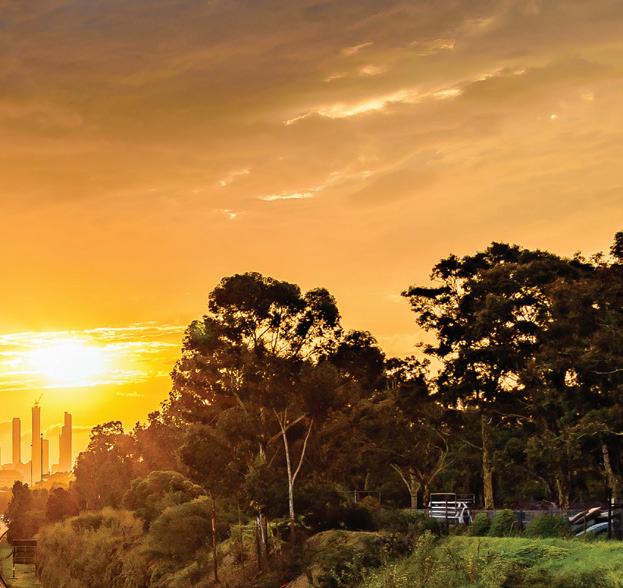
corridors in regional Australia and increase productivity by connecting major agricultural and resource areas with cities and ports.
“Urban road congestion is not just an irritation for commuters in Australia’s major cities, but it has an enormous impact on the efficiency and cost of road freight movement,“ Mr Kalgariff said.
“Accordingly, the expansion of the Urban Congestion Fund to tackle this problem across all capital cities is an enormously welcome step, as are the investments to upgrade key freight routes through the $3.5 billion Roads of Strategic Importance initiative.”
Other road project funding investments included:
♦ $1.5 billion to upgrade Northern Territory infrastructure
♦ $400 million to upgrade regional highways in Tasmania, including the Bass Highway, to improve safety and freight efficiency
♦ $220 million to deliver a bypass of Bindoon on the Great Northern Highway in Western Australia
♦ $100 million in additional funding for the Barton Highway corridor to improve access from regional New South Wales to the Australian Capital Territory
Roads Australia Chief Executive, Ian Webb, said, “The Budget reaffirms the government’s commitment to the funding of significant infrastructure projects that will have a meaningful impact on people’s lives.
“The rail and road projects being funded are sorely needed, nation-building projects that will provide long-term community benefit, kick-off growth and encourage further investment from the private sector, and attract more tourism to our cities.”
The National Road Transport Association (NatRoad) also welcomed the Federal Budget measures which NatRoad CEO, Warren Clark, said have the potential to improve the safety and efficiency of the road transport industry.
“Spending to reduce congestion in our cities has the potential to reduce expensive delays for operators, particularly in terms of the frustrating last mile access to ports, airports and freight hubs,” Mr Clark said.
Funding by state and territory

National
♦ Roads of Strategic Importance (ROSI) initiative: $3.5 billion, including $2.2 billion to be provided to specific regions or corridors
♦ Urban Congestion Fund: $1 billion
♦ Major Project Business Case Fund: $250 million
New South Wales
♦ Coffs Harbour Bypass: $971 million
♦ Nowra Bridge construction: $155 million
♦ Port Botany Rail Line Duplication: $400 million
♦ Western Sydney North-South rail: $50 million to joint fund a business case with the New South Wales Government
♦ Barton Highway corridor: $100 million for the continued upgrade of the highway, which is an important link between regional New South Wales and the Australian Capital Territory
Victoria
♦ Melbourne Airport Rail Link: Up to $5 billion
♦ North East Link: $1.75 billion
♦ Monash Rail: $475 million
♦ Frankston to Baxter Rail Link Electrification Upgrade: $225 million
♦ Victorian Congestion Package: $140 million
♦ Continued investment in regional rail (Geelong Line): $50 million
♦ Completion of the duplication of the Princes Highway East (Traralgon to Sale): $132 million
♦ The government also remains committed to the East West Link and its offer of $3 billion stands
Queensland
♦ Bruce Highway: $3.3 billion for continued upgrades to the Bruce Highway:
• $880 million Pine River to Caloundra corridor upgrade
• $800 million for the Cooroy to Curra—Section D
• $200 million for additional safety works
♦ M1 Pacific Motorway: $1 billion towards upgrades between Varsity Lakes and Tugun, and between Eight Mile Plains and Daisy Hill
♦ Beerburrum to Nambour Rail Upgrade: $390 million
♦ Brisbane Metro: $300 million
♦ Cunningham Highway (Amberley Interchange): $170 million
♦ Toowoomba to Brisbane Passenger Rail Business Case: $15 million to support planning
♦ Queensland will also receive a share of the $1.5 billion ROSI initiative—Northern Australia Package, and a share of the $160 million commitment to the Outback Way, both to be allocated across the three northern jurisdictions
21 INVESTMENT & FINANCING
CONCERNS OVER FOCUS OF INFRASTRUCTURE SPEND
However, Infrastructure Partnerships Australia (IPA) Chief Executive, Adrian Dwyer, was disappointed with the outcome, saying the Federal Budget reduced infrastructure funding by $2 billion over the forward estimates, meaning less cash for projects and more congestion for commuters.
“This will be disappointing to the states because the warm infrastructure narrative pre-budget has not been met with cold hard cash in the budget papers.
“Infrastructure projects like metro in the major cities, better freight connections and safer roads will need much greater focus from all sides of politics in the run up to the next election.”
In contrast, PwC Chief Executive, Luke Sayers, said it's
Western Australia

pleasing to see a significant focus on infrastructure to cater for the growth in cities, including investment in transport networks in Sydney and Melbourne.
“Our cities are feeling growing pains due to infrastructure bottlenecks causing congestion and infrastructure gaps making it difficult for people to access essential services. There is also the ongoing challenge of linking up remote communities with our cities,” Mr Sayers said.
Overall, this year’s Federal Budget supports a decade-long pipeline of infrastructure projects focused on driving economic growth, increasing productivity and connectivity, and creating new employment opportunities. These projects are expected to create approximately 50,000 additional direct and indirect jobs over the next ten years.
Funding by state and territory
South Australia
♦ METRONET: An additional $1.1 billion, taking total Australian Government funding to $2.3 billion, including new projects announced in the budget:
• $500 million for Morley-Ellenbrook Line
• $241 million for Byford Extension
• $83 million for the Midland Station project
• $2 million for Lakelands business case
• $226 million for further projects to be agreed
♦ Road Projects: $1.5 billion including:
• Bunbury Outer Ring Road (stages two and three): $560 million
• $252.5 million for Tonkin Highway stage three Extension
• $145 million for Tonkin Highway Gap
• $183 million for Tonkin Highway interchanges
• $107.5 million for Mitchell Freeway Extension— Hester Avenue to Romeo Road
• $46.5 million for Leach Highway (Welshpool Road interchange)
• $144 million for Roe Highway/Great Eastern Highway Bypass and Abernethy Road/Great Eastern Highway Bypass Interchanges)
• $65 million for Stephenson Avenue Extension Bindoon Bypass—Great Northern Highway: $220 million though the ROSI initiative
• EastLink WA (Orange Route) Business Case—$10 million
♦ Western Australia will also receive a share of the $1.5 billion ROSI initiative—Northern Australia Package, and a share of the $160 million commitment to the Outback Way, both to be allocated across the three northern jurisdictions
♦ The government also remains committed to the Perth Freight Link and its offer of $1.2 billion stands
♦ North South Corridor Future Priorities:
• North-South Corridor—Regency Road to Pym Street: $177 million
• Future Priorities: $1.21 billion
♦ Joy Baluch Bridge: $160 million
♦ Gawler Rail Line Electrification: $220 million
Tasmania
♦ Bridgewater Bridge Replacement: $461 million
♦ Freight Rail Revitalisation: An additional $59.8 million to be provided from 2019–20
♦ Tasmania will also receive dedicated funding of $400 million from the ROSI initiative for a Tasmanian Roads Package, focusing on the Bass Highway
Australian Capital Territory
♦ Monaro Highway Upgrade: $100 million
♦ ACT will also benefit from the increased connectivity with NSW generated through the ROSI initiative to upgrade the Barton Highway
Northern Territory
♦ Central Arnhem Road Upgrade: $180 million
♦ Buntine Highway Upgrade: $100 million
♦ The Northern Territory will also receive a share of the $1.5 billion ROSI initiative—Northern Australia Package, and a share of the $160 million commitment to the Outback Way, both to be allocated across the three northern jurisdictions
Northern Australia
♦ ROSI initiative—Northern Australia Package: $1.5 billion to be shared across Queensland, the Northern Territory and Western Australia
♦ Outback Way: $160 million to be allocated across Queensland, Northern Territory and Western Australia
22 INVESTMENT & FINANCING
Unlocking the potential of infrastructure through innovation and technology 7-9 August 2018 | Parkroyal Darling Harbour | Sydney | Australia




Philip Davies Chief Executive Officer Infrastructure Australia
Cynthia Mitchell Professor of Sustainability
Institute of Sustainable Futures
Pascal Labouze
Executive Director of Operational Systems
Transport for NSW BENEFITS
Get insights into what factors are driving the need for smart infrastructure approaches in Australia
Understand how smart infrastructure will help address resource constraints and enhance connectivity, liveability, productivity and resilience
Learn which infrastructure assets should be retrofitted to become smart and strategies to achieve this
Hear how smart infrastructure enables better value capture from new construction projects
Learn how to apply smart infrastructure strategies for water, transport, energy, social and digital assets
See how emerging technologies such as IoT, AI, Hydrogen and UAVs are impacting infrastructure
Understand how to manage the security risks associated with smart connected infrastructure









Margaret Makeham-Kirchner
Director Infrastructure and Project Financing Agency
William Bourke
President and Secretary
Sustainable Australia
Antony Sprigg Chief Executive Officer
Infrastructure Sustainability Council of Australia
Chris Johnson Chief Executive Officer
Urban Taskforce Australia
Simon Morgan Director - Government & Communications
Australian Logistics Council
www.infrastructuremagazine.com.au June 2018 // ISSUE 7 23 INVESTMENT & FINANCING
ATTENDING
OF
Organised by: REGISTER TODAY! +61 (0) 2 9977 0565 www.smartinfrastructuresummit.com.au Pascal Perez Director SMART Infrastructure Facility University of Wollongong BOOK BEFORE 29 JUNE AND SAVE UP TO $400! Endorsing bodies Platinum partner Media partners
THE BENCHMARK FOR SUSTAINABILITY HAS SHIFTED
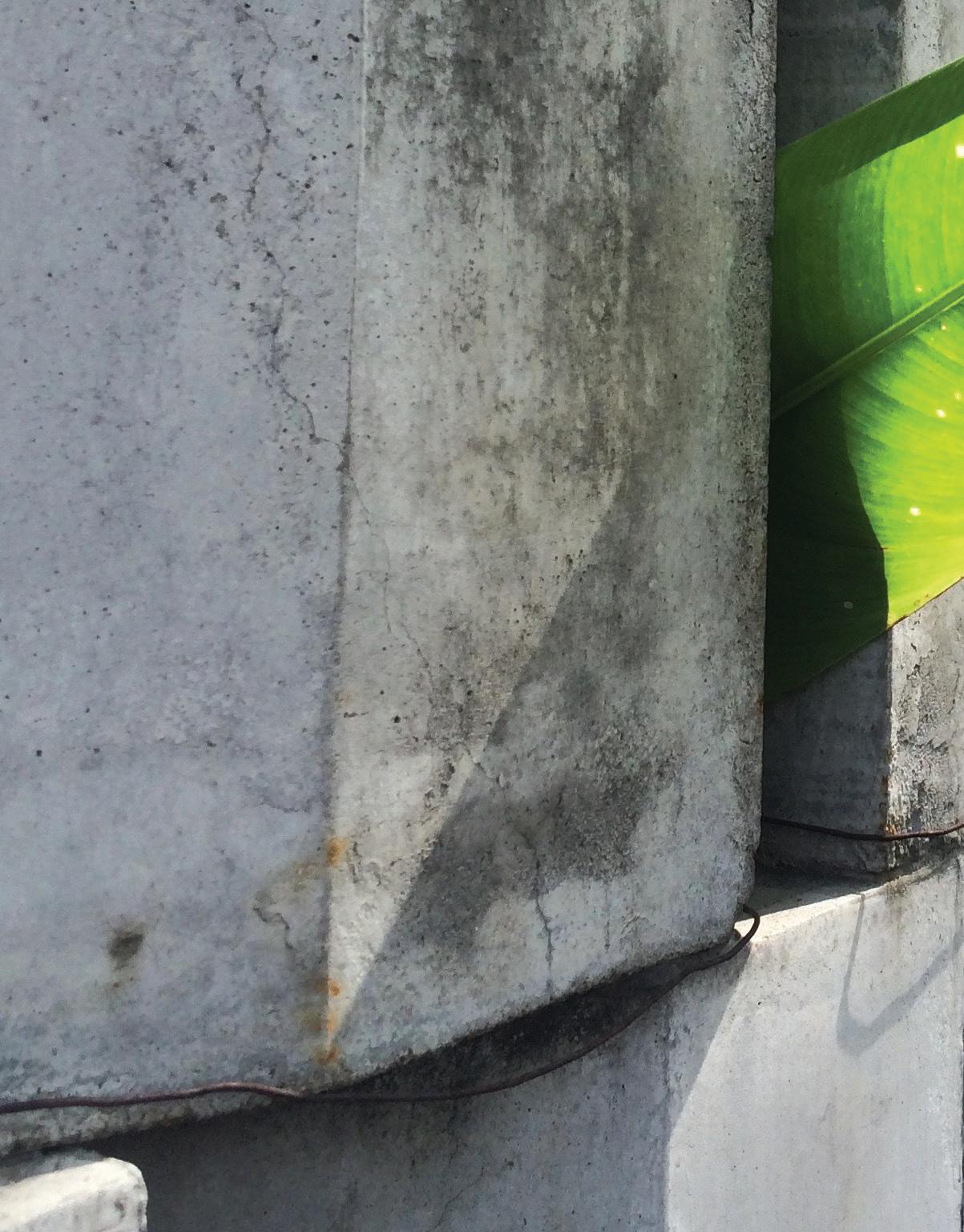
The Infrastructure Sustainability Council of Australia (ISCA) has been working closely with the infrastructure industry in the development of the latest version of the IS rating scheme, IS Version 2.0 (ISv2.0).
This has been a collaborative labour of love for ISCA and the infrastructure industry, with the tool having been developed for the industry, by the industry.
ISv2.0 has been financially supported by public and private organisations including: Rail Projects Victoria, Level Crossing Removal Authority, Transport for NSW, The Australian Government Department of Infrastructure and Regional Development and Cities, Queensland Government, The Australian Government Department of Jobs and Small Business, NSW Government Office of Environment and Heritage, CPB Contractors, Lendlease, and Liberty OneSteel.
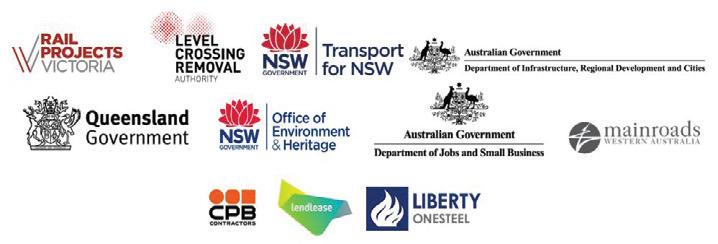
The collaborative effort for the development of the tool wasn’t limited to financial contributions. 100 industry organisations invested more than 1,300 collective hours reviewing and updating the current version of the IS technical manual (v1.2), and fine-tuning the specifications related to the development of new themes, categories and credits.

June 2018 // ISSUE 7 www.infrastructuremagazine.com.au
24 SUSTAINABILITY


“I’m not sure we’ve witnessed collaboration of this scale in the infrastructure industry before, we’ve had all players of the supply chain come together to develop a tool that delivers better outcomes. From top tier contractors through to material suppliers and delivery agencies of government,” ISCA Development Manager of ISv2.0, Nicole Boyd, said.
ALIGNMENT WITH UNITED NATION'S SUSTAINABLE DEVELOPMENT GOALS
ISCA takes a holistic approach to sustainability to ensure the planning, design, construction and operations of an infrastructure asset helps to deliver positive outcomes for society.
Infrastructure plays an important role in society and the IS rating scheme helps infrastructure projects and assets embed practical sustainability actions that contribute to achieving the United Nation’s Sustainable Development Goals (SDGs).
“The new version aims to challenge the infrastructure value chain to go even further in planning, designing, building and maintaining efficient and resilient assets,” ISCA CEO, Ainsley Simpson, said.
“The tremendous investment from industry has ensured that the tool is flexible, accommodating of the complex nature of infrastructure, and importantly, remains a credible thirdparty verified approach to demonstrating value for money.”
THE BENCHMARK HAS SHIFTED
Since the Infrastructure Sustainability Rating Tool was first piloted in 2011 it has been widely adopted. Infrastructure
projects and assets worth more than $80 billion in capital value have used the IS Rating Tool, resulting in over 120 rating registrations. Almost all transport delivery agencies have mandated an IS rating on critical infrastructure.
“What was once considered an innovative approach to implementing sustainability initiatives is now becoming a business as usual practice. Over time we’ve seen infrastructure project rating scores increase and the level of sustainability performance lift,” Ms Boyd said.
“At ISCA’s core is a fundamental drive to push performance beyond business as usual, and with the benchmark shifting industry-wide so too is our rating tool with version 2.0.”
Major changes to the IS rating scheme include the addition of an ‘Economic’ theme, which consists of ‘Business Case and Options Assessment’ and ‘Benefits Realisation’ categories.
A ‘Resilience’ credit has been added to the ‘Governance’ theme, ‘Green Infrastructure’ is a new credit within the ‘Environment’ theme, and ‘Workforce Sustainability’ has been introduced to the ‘Social’ Theme (see Figure 1).
ISv2.0 represents a more holistic approach to sustainability and as such will be a step change for the industry. It will be difficult, but nothing great is easy.
ISv2.0 will be launched through a series of ISCA events across Australia and New Zealand throughout June and July, please contact ISCA for more details.
In-depth webinar trainings are already taking place, and if you would like more information, please contact ISCA at www.isca.org.au.
www.infrastructuremagazine.com.au June 2018 // ISSUE 7 25 SUSTAINABILITY
Figure 1

HOW SUSTAINABILITY CAN BE DELIVERED: A CASE STUDY
Late last year, Main Roads Western Australia’s Northlink WA Southern Section (NLWA-SS) was awarded the Infrastructure Sustainability Council of Australia’s (ISCA) IS Outstanding Achievement Award which recognises the IS certified project that demonstrates the highest overall score and sustainability achievements. Here’s a look at what the project did to achieve this sustainability honour.
The NLWA-SS Project achieved an IS Tool Design Rating of ‘leading’ with a score of 93 points (the highest ever for a design and construct contract), eleven independently verified sustainability innovations and enhanced economic, social and environmental outcomes.
Accordingly, it may go some way towards explaining how infrastructure sustainability can be delivered and provides an important case study for the industry.
Northlink WA – Southern Section is more than a road – once the adjacent Central and Northern sections are completed, the communities of Morley and Muchea will be connected by a non-stop transport route for the first time, letting people spend less time in traffic, and more time on what matters. As a result, lives will be transformed through the creation of job opportunities, making the morning commute easier and getting people home quicker.
From start to finish, sustainable outcomes were embedded in the way that NLWA-SS was conceived, designed and built – winning it the Infrastructure Sustainability Council of Australia’s outstanding achievement and impact awards in 2017.
Main Roads WA Senior Project Director, Rob Arnott, explains that sustainability was at the core of the project as conceived by Main Roads WA, flowing through to the concept design developed by BG&E and the detailed design and construction by John Holland.
“The excellent sustainability outcomes achieved on NLWASS were only made possible through the shared commitment of Main Roads WA, BG&E, John Holland, and others - it was an exemplary team effort.”
“The biggest and most important opportunities were
June 2018 // ISSUE 7 www.infrastructuremagazine.com.au 26
SUSTAINABILITY
acknowledged, and the elephants in the room called out, by using techniques such as lifecycle assessment. Alongside capital costs, a genuine and sustained effort was made to consider social value, environmental value and lifecycle costs. And a mechanism was implemented that enabled the realization of opportunities that were outside the specification, representing a new level of maturity for client/ contractor relationships."
Pavement with a 10 per cent reclaimed asphalt content was utilised project-wide, and a significant reduction in water use during operations was achieved by redesigning landscaping to avoid the need for reticulated watering.
A shared path for cyclists and pedestrians was identified early on as a priority for the community and was subsequently incorporated into the design. And the project achieved a 15 per cent reduction in energy use on the path by using light dimming through the quietest times of night.
WHAT OTHER PROJECTS CAN LEARN ABOUT SUSTAINABILITY
Mr Arnott said the lessons from NLWA-SS showed how major infrastructure projects can embed sustainability throughout delivery to ensure better outcomes for local communities.
“The project continues to have broad community support and locals are seeing firsthand how connectivity and liveability is improving,” Mr Arnott said.
“Long-term enhancements to water quality, flood risk, ecological value, top soil, landscape character, local heritage values, and community wellbeing have been achieved via the project’s high-quality urban design, public art, drainage, landscaping and shared path solutions."
The enhanced durability and operability of the project’s pavement, structures and lighting solutions have reduced construction impacts and will enable ongoing savings over the full life of the project. The willingness of Main Roads WA, BG&E, and John Holland and to pursue innovation and trial new approaches has led to market changing technologies such as intelligent lighting systems, EME (lean) asphalt and on-site solar systems being one step closer to wholesale uptake by industry.
In particular, the close partnership forged between Main Roads WA, BG&E and John Holland allowed the team to raise the bar when it came to embedding the elements of sustainability during the detailed design and construction phases – there was ongoing engagement on economic, social and environmental impacts and value, and a firm commitment to sharing information openly.
John Holland’s NLWA-SS Project Manager, Ben Johnston, agreed stating that ,“Projects like NLWA-SS are examples of how sustainable social, environmental and economic outcomes can be achieved through the creation of peoplecentred solutions to complex challenges, and is a living example of our commitment to the values of caring and empowering, and being imaginative and future focused. It’s our belief that the same creativity, innovation and excitement that was generated on NLWA-SS can flourish on more projects – leaving a legacy that carries on long after this project is finished, and transforming lives.”
The NLWA-SS Project parties hope to see the same principles that led to their success implemented on major projects around Australia and with this in mind, Main Roads WA and John Holland have commissioned consultancy Perspektiv to share the Project’s Sustainability Experience through the publication of an industry paper.
Australian firsts
» The use of lifecycle assessment by a contractor in decision-making during detailed design
» Implementation of a tightened asphalt specification to improve water resistance and durability to increase pavement design life
» High modulus asphalt (EME2) trial on 700m section of the highway is the heaviest traffic loading section of a highway in Australia

Western Australia state firsts
» Grade-separated roundabout demonstrated to be the preferred solution with regard to congestion and road safety
» Adaptive lighting trial
» Dimming of Principal Shared Path lighting for 50 per cent of each night
» EME2 asphalt on trial section of freight route carriageway
» Design of pedestrian underpass using 3-pin arch structure
» Supplier Sustainability Day in collaboration with Supply Chain Sustainability School
» Principal Shared Path width increased to four metres for length of NorthLink WA
» Solar powered variable message sign (VMS) trial
www.infrastructuremagazine.com.au June 2018 // ISSUE 7 27 SUSTAINABILITY
REUSING COMMONWEALTH GAMES INFRASTRUCTURE SUSTAINABLY
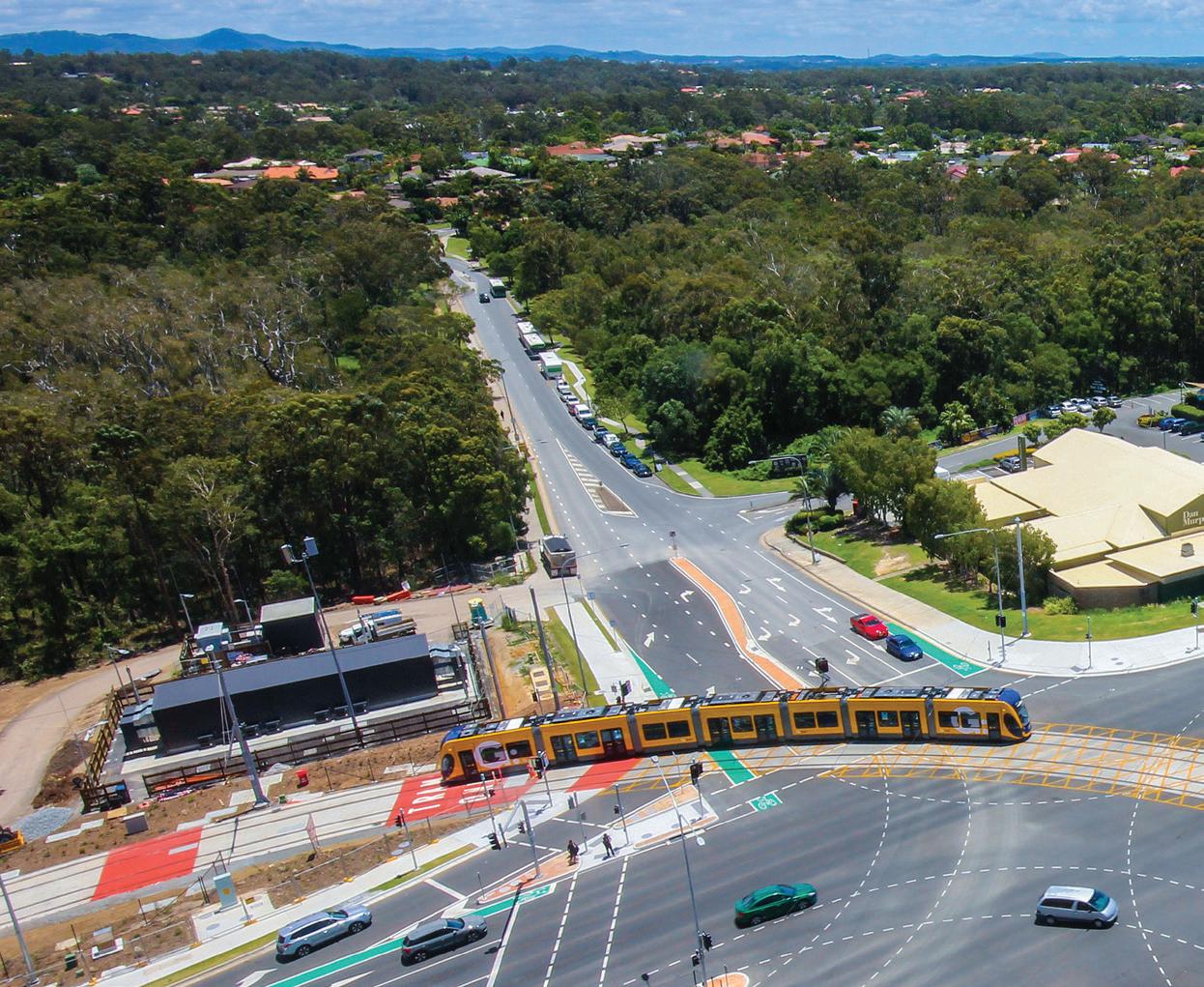
From 14-15 April 2018, the Gold Coast hosted the 21st Commonwealth Games, showcasing 23 sports with representatives from 70 nations. With doubts surrounding the capacity of new and existing infrastructure to meet demand and questions raised about how to best reuse the infrastructure built during the event, the Games presented a range of unique opportunities and challenges far beyond the 11 days of competition.
The success of any global sporting event relies on the host city’s ability to plan and execute a range of infrastructure delivery outcomes, with opportunities and pitfalls at every turn. The discussion paper, The Legacy of Commonwealth Games Infrastructure –minimising the effects of ‘white elephant’ infrastructure post Gold Coast 2018, was released by the Emerging Professionals in Infrastructure Queensland (EPIQ). It examines Gold Coast 2018, as well
as previous international major events held around the globe, to gain a greater understanding of the common pitfalls and potential avenues to leverage benefits of the Games for Queensland. A primary incentive for bidding to host a major sporting event such as the Commonwealth Games is the legacy value it provides the host city. This value can include a range of long-term benefits including ongoing tourism expenditure, infrastructure investment, new events and community sports participation.
With reports suggesting that the Games could inject $4 billion into the Queensland economy, attract 1.5 million spectators and a global television audience of 1.5 billion, the Queensland Government was able to deliver three new competition venues and undertake major upgrades to seven facilities prior to the event. In addition to these new facilities, major transport network upgrades such as Gold Coast Light Rail Stage 2 (GCLR2), were also completed.
June 2018 // ISSUE 7 www.infrastructuremagazine.com.au 28 SUSTAINABILITY
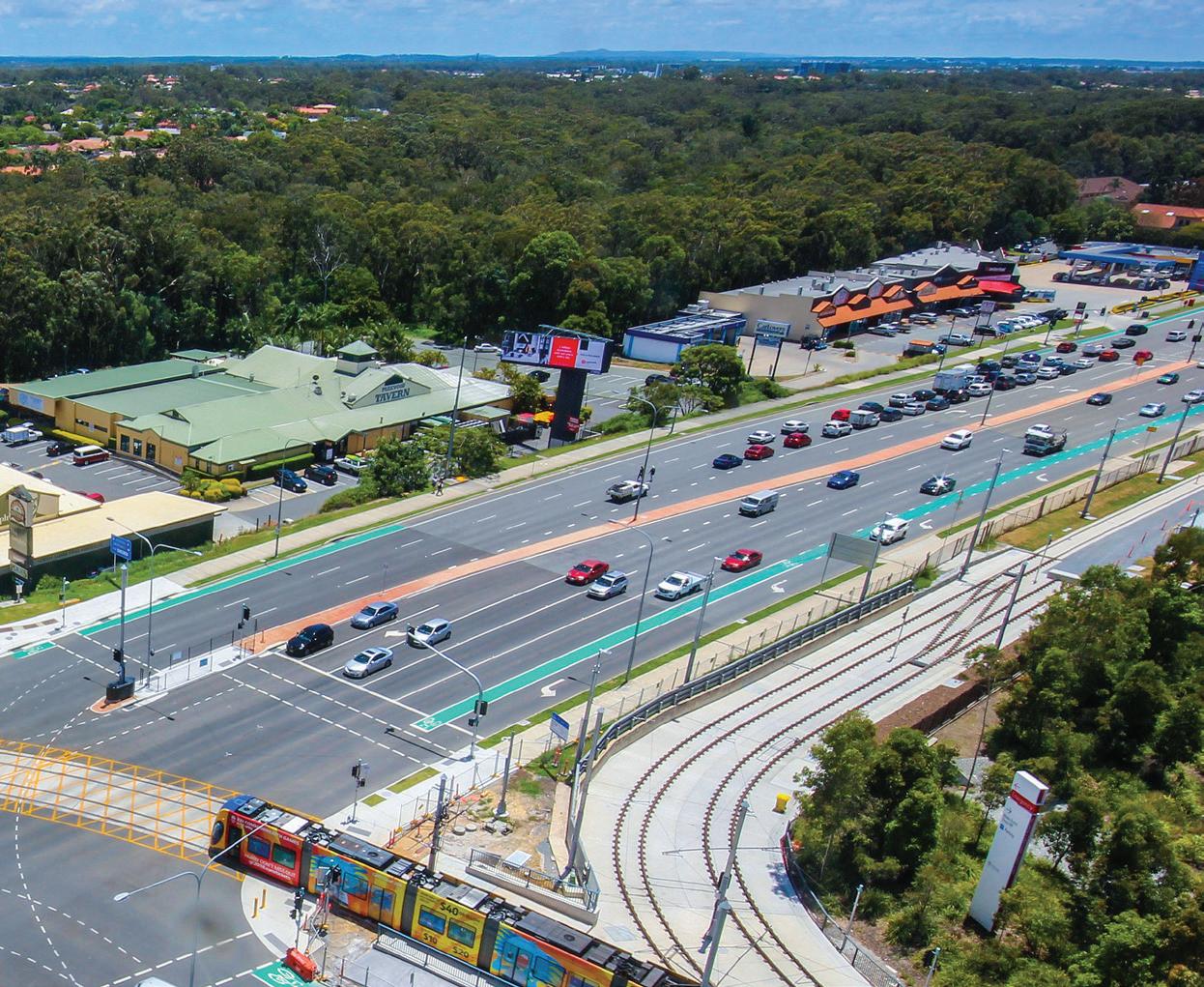
THE CHALLENGE FOR THE GOLD COAST COMMONWEALTH GAMES
The perceived success of Gold Coast 2018 was under the microscope before it had even begun, with media outlets citing transport management as a major concern. The perception of potential public and private transport issues was often discussed through the lens of the expected excessive congestion on the M1, which, along with the postponed delivery of the Gold Coast Airport redevelopment project, fuelled concerns among many of the Games’ critics.
However, this was in contrast to the successful delivery of GCLR2 and the Coomera to Helensvale rail duplication, which were positively received by the community and commentators alike. Delivery of other infrastructure projects also seemed to pass the public test, including the new Games Village with residential, retail, recreation, dining and medical facilities.
Many developed and developing nations have hosted major sporting events in recent history, so a lot can be learnt from looking back. An analysis of the infrastructure legacy outcomes of those who have gone before appears as fickle as a game of snakes and ladders. Global reviews such as this, highlighting the range of challenges experienced in the past, forced Gold Coast 2018 organisers to sit up and take notice.
A STRONG COLLABORATIVE APPROACH TO PLANNING POSITIONED THE GAMES FOR GOLD
In 2013, early in the planning phase for Gold Coast 2018, the then Newman Government released Embracing 2018, a blueprint for government to deliver on its promise of ‘a transformative legacy, creating active and inclusive communities, diverse and enduring economic growth and greater reconciliation and social justice’.
The latest iteration of the Embracing 2018 Legacy Program seeks to prolong the benefits of Gold Coast 2018 through maximising long-term community, sport and health benefits, and strengthening Queensland’s standing as Australia’s top tourism destination.
In preparation for Gold Coast 2018, the Gold Coast 2018 Commonwealth Games Corporation (GOLDOC) and the Queensland Government focused not only on planning a successful event, but transitioning seamlessly into the period after the Games.
The Embracing 2018 Legacy Program aims to create long-lasting benefits through eight key programs and a range of supporting initiatives. Programs include: Trade and Investment; Tourism; Supporting Queensland Business; Aboriginal and Torres Strait Islander Initiatives; Sport and Healthy Lifestyles; Engaged and Inclusive Communities; Arts and Culture; and Inspiring Games.
www.infrastructuremagazine.com.au June 2018 // ISSUE 7 29 SUSTAINABILITY
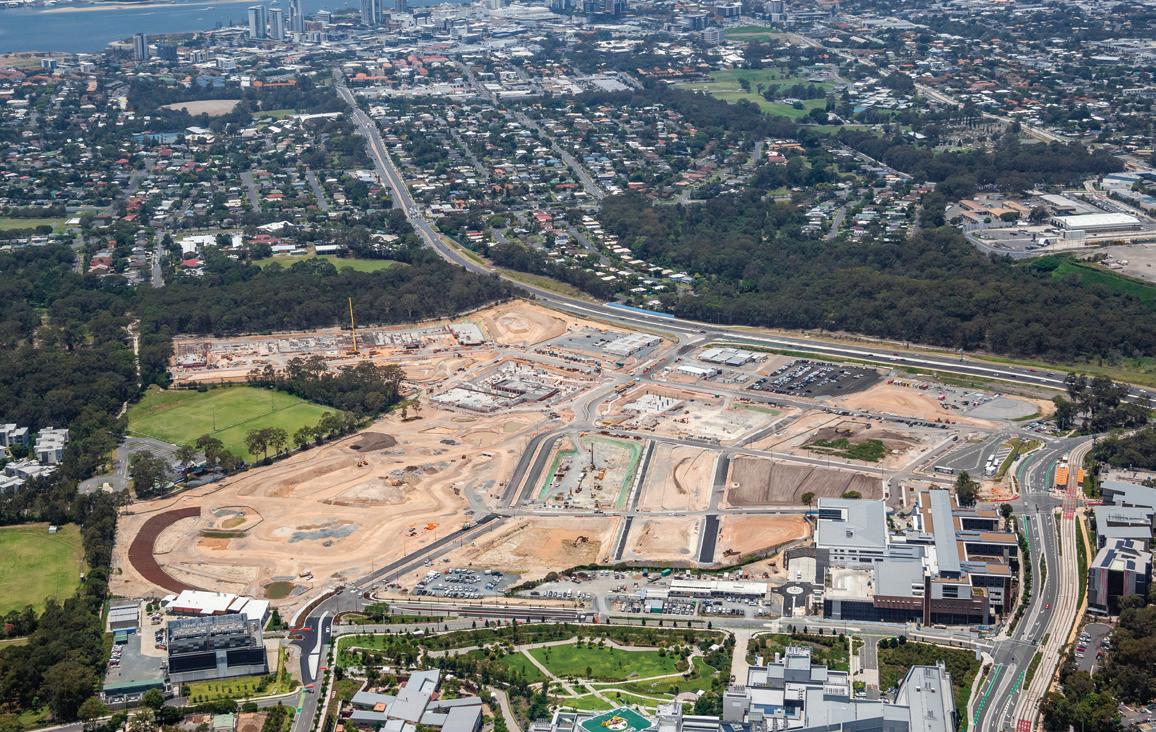
INFRASTRUCTURE INVESTMENT BOOSTED ACTIVITY IN THE REGION
Athlete’s Village
Now that the games have finished, the $550 million Parklands Project – which will only be leased to GOLDOC – will be re-purposed into a mixed–use residential community within the broader Gold Coast Health and Knowledge Precinct. A sustainable approach was also taken to prepare competition venues with a mix of existing, new, upgraded and temporary sites being used. Three new venues were developed, including the $59 million Anna Meares Velodrome, the $40 million Coomera Indoor Sport Centre, and the $105 million Gold Coast Sports and Leisure Centre.
Seven existing venues were upgraded or refurbished and the ‘Super Stage’ at Village Roadshow Studios Oxenford was temporarily fitted out as a competition venue. A number of other sites did not require any major or costly upgrades to meet competition standards.
Similar to the Athlete’s Village, and under the banner of re-purposing infrastructure, the majority of the competition venues were flagged for transition into use by the local community and for future events following the Games.
Ongoing benefits
Various other sustainable infrastructure projects were delivered to support the Games and provide opportunities for long-term value, with the City of Gold Coast outlining 38 programs that would provide a catalogue of benefits to the region.
These projects have been categorised thematically, and endeavour to deliver on initiatives across transport; culture; skills development; education; digital development; environment; health and lifestyle; community benefit; spatial information sharing; safety and security; beach nourishment and business; trade and investment. These programs aim to provide Australia, Queensland and the Gold Coast with an economic and social uplift.
DID THE GOLD COAST MAKE A PODIUM FINISH?
Transport infrastructure was identified as a major risk, with significant capacity demand during the Games. Importantly, the infrastructure delivered for Gold Coast 2018 aligned with the State Infrastructure Plan. Since 2016, the Queensland Government has delivered $320 million of planned infrastructure for the Commonwealth
Games, some of which were accelerated into delivery in time for the Games.
Despite this level of planning and accelerated project start dates, in December 2016, the Commonwealth Games Federation wrote a letter to GOLDOC Chair Peter Beattie highlighting apparent inefficiencies in the host city’s transport plan.
The letter specifically noted concerns around the need for expanded train services and shuttle buses, in addition to recommending further consideration be given to traffic concerns on the M1. The Federation warned if the 14 steps outlined in their letter were not undertaken greater effects may be felt throughout the Games and beyond.
Follow up correspondence from the Federation specifically noted that while GOLDOC and the Queensland Government had taken steps toward planning and modelling the proposed requirements, final decisions needed to be made to ensure the necessary measures were in place in time for the Games.
In June 2017, GOLDOC’s Transport Operations Plan (TOP) was released which identified several key transport legacy outcomes including partnerships, enhanced transport coordination,
June 2018 // ISSUE 7 www.infrastructuremagazine.com.au 30 SUSTAINABILITY
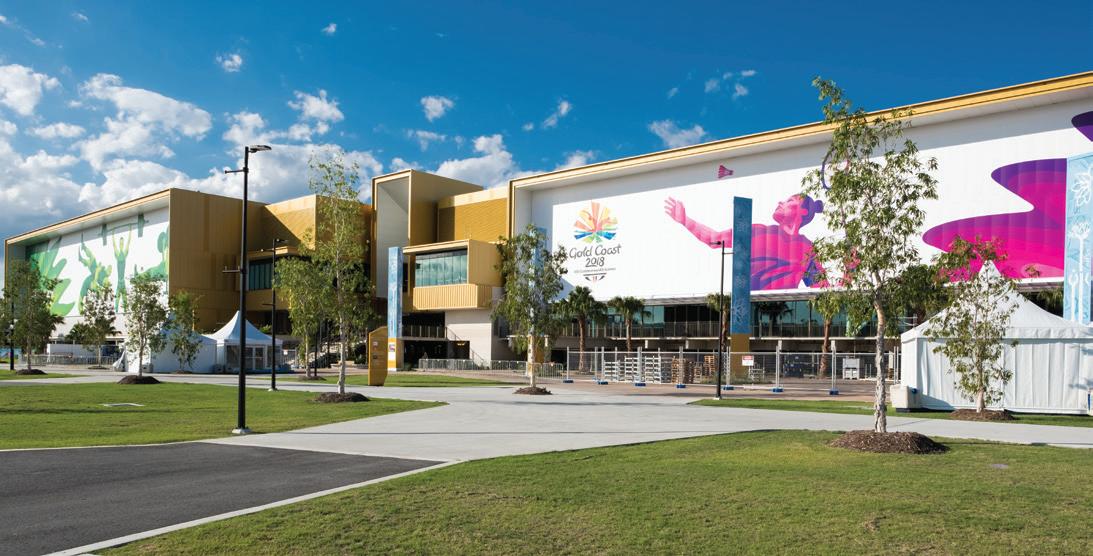
Various other sustainable infrastructure projects were delivered to support the Games and provide opportunities for long-term value, with the City of Gold Coast outlining 38 programs that would provide a catalogue of benefits to the region.
transport infrastructure upgrades, permanent change in travel behaviour, and enhanced transport planning information.
The positive signs that came from the TOP – including a supplementation of the train network with bussing –and social media campaigns that aimed to actively engage with the Gold Coast and travelling community, gave hope that with a little planning and considerable political action, great long-term benefits could be achieved.
Some plans however don’t always make it to fruition. The $200 million capacity upgrade of the Gold Coast Airport was partially delivered in time for the Games to alleviate delays and queuing of more than 126,000 visitors, athletes, officials and media. These works will now not be completed until mid-2018 and well after the last athlete has left the village.
While it was expected that the transport network around the Gold Coast would come under pressure during the all-important 11 days of competition, and despite the potential for delays at the airport, the successful delivery of essential transport infrastructure undoubtedly helped meet transport demand. This infrastructure will now have
a lasting impact on how travellers move throughout the region, beyond the Games.
WHAT WILL BE CRITICAL BEYOND 2018
EPIQ believes GOLDOC and the Queensland Government took the time to strategically plan for the Games and learn from those who had gone before them. The risk was then in the execution, but with 15,000 volunteers, hundreds of paid staff and four years of strategic legacy planning, the Gold Coast and Queensland were able to enjoy a successful outcome.
The holistic planning put in place positioned the region to transition the short-term benefits from Gold Coast 2018 into long-term benefits for the Gold Coast’s residents, businesses, workers and tourists well into the future.
Viewers around the world were spoilt for choice when it came to watching some of the world’s best athletes compete along Queensland’s golden beaches, but EPIQ is now excited to see how the transport and broader infrastructure legacy story unfolds. EPIQ remains optimistic that the strategic planning and investment undertaken to-date provided an appropriate platform for the Games and beyond.

www.infrastructuremagazine.com.au June 2018 // ISSUE 7 31 SUSTAINABILITY
MEETING THE DEMAND AND SUPPLY OF CIVIL CONSTRUCTION SKILLS
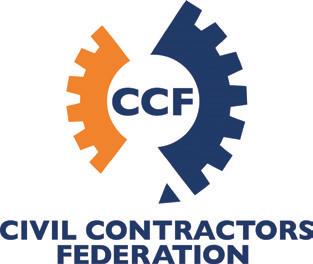 Aby Sonya Casey, Project Officer – Training, Civil Contractors Federation (CCF)
Aby Sonya Casey, Project Officer – Training, Civil Contractors Federation (CCF)
There is no doubt that the civil industry in Victoria is experiencing significant challenges, and there are many reports that provide evidence and statistical data validating the urgent need to put in place a civil industry workforce development plan.
snapshot of known challenges for civil construction businesses are: engaging as a subcontractor to deliver major infrastructure projects, recruiting skilled equipment operators, supervisors and entry level workers, and maintaining legislated compliance and reporting requirements.
CCF Victoria, has investigated past recruitment, training delivery and assessment practices. Based on our research findings and member feedback on the immediate need for adequately trained workers, CCF has designed and is ready to implement a series of targeted skills development programs.
This is an opportunity to build on current civil skill development programs, to inject these programs with learning experiences and assessment activities that directly relate to the realities of the civil worksite.

the aspiration and present a positive civil construction development pathway for those interested. In addition, we need to grasp the opportunity to improve the profile of civil construction as a career.
IMPACT ON SMALL TO MEDIUM SIZED ORGANISATIONS
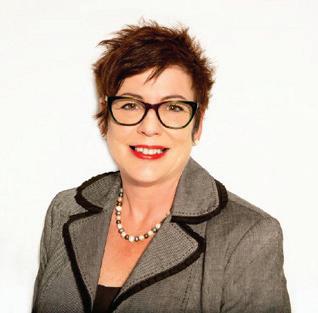
Victoria’s 30 Year Infrastructure Strategy states, “By 2046, we see a thriving, connected and sustainable Victoria where everyone can access good jobs, education and services. In 30 years’ time, the state will look very different. We can’t tell what the future holds, but we know that the performance of infrastructure across all sectors will shape Victoria’s society, economy and environment.”
As indicated by the comments above, the future for a career in civil construction is positive. We need to create
Our 2018 Victoria Infrastructure Outlook Report, Implications and Challenges – A Victorian and National Perspective, states, “From a Victorian perspective, the infrastructure task is high over the next five years, and challenges can lead from rising costs of construction, particularly since the construction phase within the state coincides with rising construction activity nationally.
“A need to employ skilled staff during this period will be a challenge particularly when skill transferability is limited and the demand for certain skill set increases within the industry during heightened periods of activity.”
The civil construction industry is a complex sector. Experienced and well-resourced Tier One contractors are grappling with the significant and accelerating demand for entry level workers, supervisors and experienced operators. This has a “knock on” effect for small to medium sized (SME) organisations who are subcontracting to these Tier One contractors who are also placed under incredible pressure to deliver targeted apprentice/trainee results.
June 2018 // ISSUE 7 www.infrastructuremagazine.com.au
32 SKILLS & TRAINING
Sonya Casey, Project Officer – Training, Civil Contractors Federation (CCF)
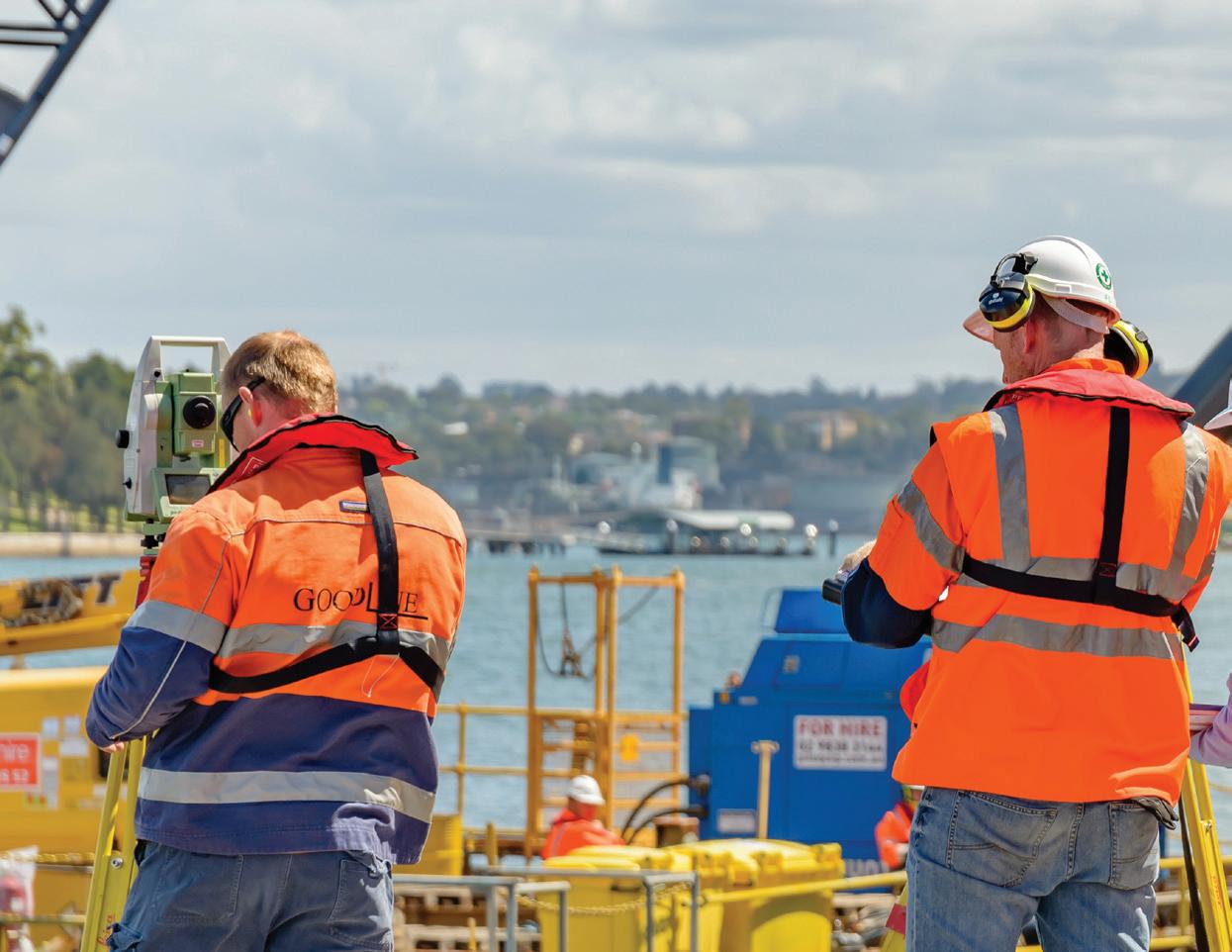
Many SMEs do not have the level of experience and internal administrative resources to cope with the demand of recruiting entry level workers or operators as required. There are thousands of workers required to work on current and projected infrastructure projects in Victoria.
DEMAND FOR TECHNOLOGY SKILLS
The rate of innovation in the civil industry is gathering pace. This is largely dominated by new processes and equipment. Alongside new techniques, automation, robotics, remote operations centres, use of drone technology, increased use of GPS, and increased use of data in monitoring operations, are all key features of innovation in the civil sector.
This will impact on the skills required for the civil industry and create an increased demand for technology skills and competencies to use the latest equipment. Applications of technology are becoming more evident in the civil industry worksite.
Past approaches to delivering training have been mostly traditional. The updated design will take into consideration younger generations expectations and modes of learning, the effectiveness and efficiency of time committed to developing new skills and the balance between on the job and intensive workshop session learning activities.
For the civil sector, an innovative approach is to shift from classroom based, "chalk and talk", theory only examinations and separate practical demonstration, to a blended approach. For example, a blended approach could incorporate technology
platforms, eLearning packages, workplace experiences and mentoring. One size does not fit all situations.
CCF Victoria has developed a skills development program titled the Civil Skills Cadetship Program (CSC Program). This is the baseline program from which skills development activities are linked. For example, Civil Career school information, Taster Program, Youth Job PaTH, apprenticeship programs and engineering graduate placements are linked to the four stages of the CSC Program.
Through the CSC Program, CCF Victoria is presenting a major change to the way “things have always been done”. It is a significant advancement to workforce development methods in the civil sector, with structured recruitment and selection processes, and the integration of technology platforms that are proven to add value through creating engagement with participants.
Simulators and virtual reality have been used, however, not built into program assessment requirements. Individuals are empowered through the use of technology, with learning and connecting with others. The CSC Program is designed to encourage entry level workers to take up an opportunity for a career in the civil construction industry.
The CSC Program is a four-stage approach which delivers to participants career support, induction to the construction industry, cross industry competencies, civil construction core competencies, worksite experience, industry mentor assistance and learning experiences that are integrated throughout the program.
www.infrastructuremagazine.com.au June 2018 // ISSUE 7 33 SKILLS & TRAINING
Assessment - LLN Robot
Introduction - Profile21
Distribute - PPE and iPad to each participant
Guest Speaker - Wellbeing and Work Enrol - Induction Units of Competency (See below)
Facilitate - CPCCWHS1001 - Prepare to work safely in the construction industry
Facilitate - HLTAID003 First Aid
Facilitate - HLTCPR201A - CPR
Work Site - Participants (in small groups of 4) to experience one of the six work sites alongside Industry Mentor










Stage Three
Work Site Ready
Enrol - Certificate III in Civil Construction
Quest Speaker - Worksafe Representative
Faciliate
RIICOM201D, RIIBEF201D, RIIGOV201D, RIIWHS201D
RIIRIS201D
Work
RIIBEF201D, RIICCM203D
RIICCM203D, RIISAM204D
RIICCM206D
Facilitate - Traffic
RIIWHS302D
Stage Four
Mentor Support
Participants continue with Cert III in
Participants formally signed up with a civil employer under the appren arrangement.
Mentors to be connected specific industry sites, all access permits must be cleared.
Mentors to take leadership/coaching of 4 participants each. (4 x 6 mentors = 24 part)










INDUSTRY PROGRAM TO ENTICE NEW WORKERS
Using the CSC Program design as a baseline, CCF Victoria and the Department of Jobs and Small Business have partnered to offer a Youth Jobs PaTH internship program. This program targets young people, aged between 15 to 24 with an interest to enter the civil industry. Recruitment, screening and selection of participants is carried out in consultation with civil employers. Participants will be provided with a “warts and all” induction to what it’s like to work in the civil industry. This is followed by a 10-day intensive program with participants completing cross industry units of competency. The participants are then available to be placed as an intern with a civil industry employer. If the intern is the right fit for the business, the employer may decide to offer employment. The business could be eligible for a youth bonus wage subsidy. The first of the Youth Job PaTH programs for civil construction kicked off in May 2018.
In Our Captivating History, The First 50 Years of AERCF Victoria (1943– 1993) writer and compiler, Graeme Moore, in 1973, stated, “Lack of organised training for plant operators remained a problem within the industry. A letter was sent to the Minister for Defence suggesting that unused army equipment could be used for this purpose and army personnel employed as instructors. We are not quite sure how the Minister viewed this request as we did not receive a reply to our letter”.
Reflecting on the above excerpt, it could be assumed that not a lot has changed. The demand and supply of skilled civil construction workers was a problem in 1973 and is currently a challenge in 2018.


All stakeholders involved with Victoria’s major infrastructure projects should be encouraged to work together. Led by the civil industry, CCF Victoria has designed a meaningful foundation and agile skills development program, known as CSC Program. This program reflects the complexities of the civil construction industry. It sets the scene and supports each individual to achieve successful outcomes, as they travel on the civil construction career pathway.
About Civil Contractors Federation (CCF)
Civil Contractors Federation (CCF) is a peak industry body representing Australia’s civil construction industry with more than 2,000 contractor and associate members nationally and over 520 of these based in Victoria.
CCF Members are responsible for the construction and maintenance of Australia’s infrastructure, including roads, bridges, pipelines, drainage, ports and utilities. Our members also play a vital role in the residential and commercial building industry by providing earthmoving and land development services including the provision of power, water, communications and gas.
June 2018 // ISSUE 7 www.infrastructuremagazine.com.au SKILLS & TRAINING
Civil Skills Cadetship (CSC) Program Implementation Model Stage
Recruitment & Selection Expression of InterestParticipants Career Assessment - Brilliant Fit Interviews - Participants Selection - Participants Introduction - Industry Mentor Introduction - Civil Industry Employers
- RTO(s) Development - Indiviudal Civil Skills Development Plan
- Tripartide Agreement - Industry Mentor, RTO and Participant S tage Two Induction Guest Speaker - Industry orientation and expectations Introduction - CSC Team Inroduction - CSC Program Ambassador LL&N
One
Introduction
Development
- Workplace Communication & Safety
Site - Participants (in small groups of 4) Industry Mentor
Work
Facillitate - Preparing to Carry Out
Work Site - Participants (in small groups of 4) Industry Mentor
Operations Simulator
VR Summary - CSC Program Ambassador Participant(s) sign with employerProbabtion period - Cert III in Civil Construction
RIIWHS205D,
Work Site - Participants (in small groups of 4) Industry Mentor Facilitate - Conduct Plant
&
Civil Construction (appren) selecting the stream which suits the employer.
Option for participants to exit and take up entry level employment in alternative industry which requires the units of competency Options for participants to continue with the Cert III in Civil Construction (Appren) or become employed as a Labourer Participants continue in civil construction as a career Option for participants to exit and seek support/advice to enter alternative type of industry 34

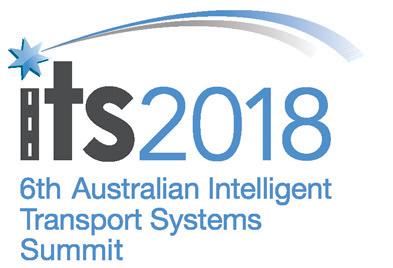


WHY IS ENGINEERING NOT ATTRACTIVE TO FUTURE BUILDERS?
by Dr Collette Burke, Chief Engineer of Victoria
Futureproofing the engineering industry will not only require the development of new skills and capabilities but also greater collaboration between students, academic institutes and industry, as well as improving diversity, says Dr Collette Burke, Victoria's first Chief Engineer.
Albert Einstein once said, “I was originally supposed to become an engineer but the thought of having to expend my creative energy on things that make practical everyday life even more refined, with a loathsome capital gain as the goal, was unbearable to me.”
Despite the feats of engineering marvels that have been created, engineers remain the quiet technical achievers of the world to date. Whilst the physical creations are often remembered — such as the buildings, roads, bridges, submarines, railways and products — little is known about the great minds behind these creations that inspire the next generation of future engineers. Engineers are in fact visionaries that dream and create tangible, innovative structures to serve mankind.
In this world of exponential technological change, it is important to value the people who have the ability to turn ideas into reality, and to have leaders invested in shaping the future of a sustainable world through use of visionary engineering skills. In the current climate, engineers need to
June 2018 // ISSUE 7 www.infrastructuremagazine.com.au 36
SKILLS & TRAINING

step up and take the power to lead our society to adopt technology and innovation, hence the need for greater representation at every level.
To date, engineers have typically been involved in areas surrounding research and design, manufacturing and product development, design, construction, operations of assets and infrastructure, and the development of physical and digital systems.
Naturally, the engineering industry is filled with skilled technical people, however these specialised technical skills are not necessarily being transferred to upcoming engineers to provide the inspiration they need. Given this, and the aging engineering workforce, the new generation of engineers are becoming more generalist. Is this a good or a bad thing? Only time will tell.
The engineering profession is also seeing increasing vacancies within Australia, up to 25 per cent in 2017, and 29 per cent in Victoria alone (ABS 2018 statistics). The most alarming shortage of engineers can be seen in the public sector, where employment of engineers has decreased significantly over the past 30 years, from approximately 100,000 down to a mere 20,000.
How do we deliver unprecedented levels of infrastructure and innovation with so few engineering minds? This number is indicative of how vital it is for greater representation of engineers across all sectors and in particular the government sector. It is essential for the growth of our country and to integrate the ever-growing technological, social and physical worlds.
INTEGRATING NEW TECHNOLOGIES AND SUSTAINABILITY TARGETS
As is clear in our evolving society, the future is an exciting prospect if we are given the tools to properly develop and advance as a society. Engineers have the potential to become holistic visionary designers of the environment in which we live, however the key to this is shifting away from seeing projects in isolation to systems-based thinking, which is currently difficult given the aging workforce who have worked differently.
An example of this is the underutilisation of Building Information Modelling (BIM) within Australia, where we have been slow to adopt the technology which is reshaping the development, construction and management of assets. The introduction of BIM has provided an opportunity to move away from the traditional methods and to allow the leveraging of digital assets for a more efficient analysis of optimisation of project lifecycles, particularly in a visual way.
As spatial and construction information modelling technologies begin to converge, there is a significant opportunity for Australia, through use of data policies, to promote integrated adoption of this manner of working across the entire construction sectors.
It is clear BIM is capable of providing all manner of key sector
www.infrastructuremagazine.com.au June 2018 // ISSUE 7 37
SKILLS & TRAINING

benefits, from improved project quality to labour market improvements, and so it is integral that the engineers working currently and in the future are equipped with the tools and resources to use these technological advancements in their future work. BIM capabilities will make the communication of complex issues on projects easier for all stakeholders involved in the project.
This rethinking of asset development and management should also be combined with the understanding of sustainability principles and processes. The increased focus on sustainable construction and asset management is critical, given the rapid global urbanisation and the call to reduce global carbon emissions, and is creating enormous challenges requiring differing solutions and a ‘motivation’ to want to change our world for a sustainable future.
As with any industry, the skill requirements for workers is consistently evolving. Engineers will need to acquire and utilise knowledge surrounding social, economic and environmental areas in order to see how their designs will interact and influence the world in which we live. Due to continued transition into a digital economy, there is need for greater technological skills for upcoming engineers.
There will also be a requirement for increased soft skills in engineering degrees to prepare students and give them the skills to succeed in the real world. Agility is also a key factor influencing how people progress through their chosen industry and how they develop skills.
I can personally attest to this, having worked in a variety of different areas and on numerous projects, ranging from civil engineering, the creation of engineering consultancy firms both locally and overseas, and working with government bodies on major projects. It is important that engineers are given the skills to work within all areas in the public and private sector and ensure we can permeate skills to new sectors in order to aid not only our individual development, but that of the future world.
MOVING TOWARDS A MORE INCLUSIVE WORKFORCE
On top of the crucial technical skills, future engineers will also need better people skills, in terms of stakeholder management and internal teams and companies, to give them greater power to influence and help the creation of our technological society. Given the diminishing technical expertise within the public sector, leadership skills should also be developed for engineers, in order to help ensure the public sector has well informed and knowledgeable technical expertise to develop our future society.
Acknowledging the future skills required in engineers, it is important to look into and discuss the teaching and promotion of engineering degrees at universities. Currently, there is an overarching perception that all engineers need to be extremely skilled at maths and physics, which could be pushing away potential future engineers. We also see a significant under representation of young females joining and remaining in the profession.
While some engineering disciplines do require high level maths skills, the broader aspects of engineering should be promoted to attract a wider range of skills and interests. Engineering should be promoted as the creative and visionary profession that it is, where world’s best practice in innovation can be achieved.
Working with the engineering profession to ensure that there is appropriate course content and skills development for our young engineers, and strengthening the relationship between students, academic institutes and industry will go a long way to ensuring we can nurture engineers of the future that are job ready upon completion of studies.
We also need to strive for greater diversity in the profession – in respect to diversity in gender, culture, age, disability and experience. Non-homogenous teams increase diversity of thought, greater creative problem solving and productivity that leads to monumentally greater outcomes.
Focusing on building synergies in teams for the enhancement of communication skills and promoting lifelong learning and development will lead to optimal outcomes for projects within the industry and for future developments. In general, everyone wants a cross-section in our workplace which is more aligned to the cross-section in society. Promotion of the benefits and attributes of being an engineer will highlight that engineering is an outstanding profession and requires well-rounded technical skills as well as outstanding personal qualities.
While it is clear that there is considerable work to be done to ensure the readiness of engineers for the future of our world and the industry itself, there are positive signs to be taken from the acknowledgement of such issues by key personnel within the industry. A combined effort is needed to progress the engineering profession and its workforce, which will in turn garner only positive outcomes for society.
June 2018 // ISSUE 7 www.infrastructuremagazine.com.au 38 SKILLS & TRAINING
Platinum Sponsor:
August 20-23, 2018
Gold Coast Convention and Exhibition Centre Queensland, Australia

Make History
Join fellow colleagues from several Oceania nations and abroad for the inaugural damage prevention industry conference to educate stakeholders on damage prevention and safe excavation. A showcase of best practices and international learnings for damage prevention efforts on underground assets and essential infrastructure.
Gold Sponsor:

Founding Sponsors:
3 Industry-Specific Streams
Featuring 30 Sessions Focusing on:
• Damage Prevention Endeavors
• Dial Before You Dig Initiatives
• Utility Location Practices
Supporting Organisations:

Register at OceaniaDPC.com
Owned & Produced by: Oceania Damage Prevention
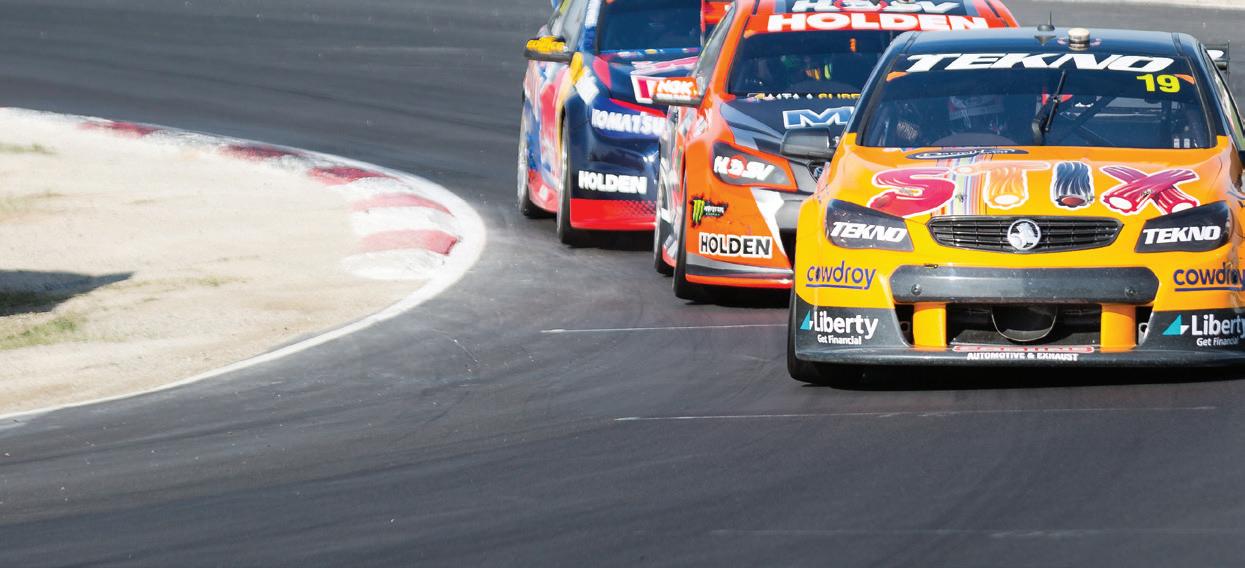
BRINGING PAVEMENT DESIGN INTO THE FAST LANE
Can you think of a more fitting place to update your pavement knowledge than in the pit lane of the Townsville V8 supercar circuit? This is what 20 cadets, technical officers, engineers, infrastructure managers and team leaders did just recently.
The participants, from various local and state government bodies, understood the benefits that ongoing professional development would have not only for their own benefit, but also for ratepayers and taxpayers who expect engineering solutions that provide the best value for money.
The Australian design guide for road pavements has recently undergone its largest technical change in more than a decade. Following several years of research funded by Austroads, some past assumptions that erred on the conservative side were able to be fine-tuned based on new knowledge arising from this research and understanding.
The axle configurations of the Australian heavy vehicle fleets have changed considerably, and in some parts of Australia
reduced pavement thickness whilst maintaining quality and integrity, leading to very significant financial savings especially on major projects.
‘Reliability factors’ have been adjusted to reflect higher confidence levels due to better knowledge. This enables designers to reduce pavement thickness, significantly reducing construction material costs and freeing up funding for additional work.
It is this improved knowledge that the course attendees were looking for. The Centre for Pavement Education (CPEE), a highly specialist training provider endorsed by Austroads, was engaged to work directly with the organisers to provide continuing professional development and in-depth understanding of pavement design in the unusual but highly E N H A N C E Y O U R

CPEE is Australia’s premier provider of higher education and training in roads, pavements and infrastructure asset management. Offering online postgraduate programs alongside specialist short courses and workshops

June 2018 // ISSUE 7 www.infrastructuremagazine.com.au 40 SKILLS & TRAINING // PARTNER SOLUTIONS
T E
A
C A P A B I L I T I E S
C H N I C
L
MASTER OF PAVEMENT TECHNOLOGY Short
Workshops Masters Graduate
BACHELOR OF ENGINEERING TECHNOLOGY (PROFESSIONAL HONOURS IN INFRASTRUCTURE ASSET MANAGEMENT) w w w . p a v e m e n t e d u c a t i o n . e d u . a u [ 0 3 ] 9 8 9 0 5 1 5 5 Roads, Pavements and Infrastructure Asset Management
Courses
Certificates
SENSING CHANGE – UAVS TO REVOLUTIONISE UTILITY MANAGEMENT
The expanding use of unmanned aerial systems (UAS) to collect data on critical infrastructure is transforming how a range of industries manage their assets.
Evolving UAS, sensors and analytics tools are creating a step-change from traditional surveying and inspection methods to offer higher quality, more accurate and usable data.
Insitu Commercial Solutions Director Asia Pacific, Andrew Donald, said that the use of highly temporal airborne remote sensing capabilities was ushering in an era of significant commercial business improvements via automation in the sector.
According to Mr Donald, whether it’s a case of rail, road, energy or utility asset management, leveraging the use of UAS and the data they collect is key to streamlining workflow and generating tangible savings in asset maintenance and operational costs.
“Our experience in working with customers in government, civil construction and large-scale resource extraction has shown us that the quality data we collect from persistent aerial sensing is allowing industries to work more efficiently, safely and productively,” Mr Donald said.
“Insitu has honed professional flight experience through over one million flight hours globally, and we also know that the data management environment is pivotal in solving commercial business challenges by allowing data from other sources such as ground operations to be correlated with the airborne sensor data, to generate a complete picture of assets and their condition.”
ADVANCES IN SENSOR TECHNOLOGY
Rapid advancements in sensor technologies, such as Light Detection and Ranging (LiDAR), open up a range of new opportunities across the construction, utility and linear asset space. Sites that were once hard to reach or access, can now be regularly surveyed, geospatially tagged and monitored, avoiding the need for personnel to be in direct contact with hazards. Data sets can be delivered within hours in many cases.
“We’re applying a range of sensors including LiDAR, thermal imaging, Electro-Optic, Infra-Red, photogrammetry, day and night video, and multispectral linear asset inspection to get the right information at the right time to help our customers make critical decisions,” Mr Donald said.
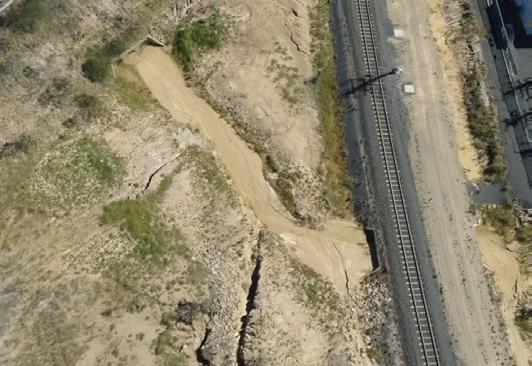
inspection checklists; and emergency response information.”
In the case of linear asset inspections – for example railway inspections for bulge or crack detection, corrosion, vegetation encroachment or responding to weather events – persistent aerial remote sensing and data analysis can pinpoint issues quickly and on a broader scale than traditional methods.
“Whether we are streaming geospatial video into the control rooms of global corporations or delivering information to site managers on mobile devices, we can enable near real-time actioning about deployment of ground personnel, as well as collate data for long-term trend analysis,” Mr Donald said.
MACHINE LEARNING TO INCREASE SPEED OF DATA ANALYSIS
The benefits of aerial data collection become evident with persistent, repeatable inspections and mapping, where changes can be objectively and accurately compared over time. Creating a ‘digital twin’ can replace the need for multiple drawings of assets, models and sites.

“We can then extract precise information for a range of applications such as 3D Digital Surface Model (DSM); volumetric assessment; elevation change; automatic object, vegetation and change detection; plan compliance; automated
The digital twin becomes a reliable baseline, and through repeated data capture and analysis, provides accurate change detection rapidly in an emergency response or for predictive maintenance.
Insitu continues to innovate as more businesses introduce autonomous systems into their asset management strategies.
To this end, Mr Donald said that Insitu’s beyond visual line of sight capability and data analysis are streamlining planning and management practices.
“With one flight and one pass, we can provide multiple analysis layers. Increasingly, we’re seeing the benefits of automatically detecting anomalies through the application of machine learning and computer vision to reduce the workload on human operators, increase their efficiency and importantly, enhance safety.
“There are boundless applications for this technology, and we’re excited to see where we can take these innovations into the future.”
www.infrastructuremagazine.com.au June 2018 // ISSUE 7 41
ASSET INSPECTION & DRONES/UAVS // PARTNER SOLUTIONS For more information: insitupacific.com.au or email: contactus@insitupacitic.com

NEW PERSPECTIVE ON DRONES & INSPECTION TECHNOLOGY
Essential Energy is using new drill and drone technology to inspect its electricity assets and improve condition assessment processes.
Essential Energy is responsible for building, operating and maintaining one of Australia’s largest electricity networks — delivering essential electricity network services to more than 800,000 homes and businesses across 95 per cent of NSW and parts of southern Queensland.
Luke Jenner, General Manager Network Services at Essential Energy, said technology offered an opportunity to improve energy affordability and reliability for customers.
“Our use of technology is part of our continued focus on best practice systems which in turn increases productivity, provides best value for customers, and enhances employee health and safety,” Mr Jenner said.
“Recent additions to the Essential Energy toolkit include new pole inspection technology, increased use of Light Detection and Ranging (LiDAR) data for strategic asset management and a growing fleet of drones to provide a new network perspective.”
NEW DRILLS PROVIDE MORE ACCURATE DATA
It is estimated the use of new drill technology will deliver Essential Energy annual cost savings of $1.3 million and provide improved asset condition data through more accurate pole density measurements.
“From July 2018, new handheld automated wood inspection drills are being rolled out following a successful field trial of the new equipment across seven environmental zones,” Mr Jenner said.
“Our extensive field trial of the drills late last year found that the improved ergonomics meant that they were easier to handle for asset inspectors than current equipment and resulted in less injuries.
The new drills automatically drill through the diameter of the pole whilst measuring the resistance to drilling. This information is stored electronically and analysed to provide an extremely accurate picture of pole condition.
“The inspection procedure itself is less invasive and minimises damage to the pole structure as there is significant
reduction in the need to drill larger inspection holes in all poles,” Mr Jenner said.
A critical component of the technology is the improved measure of remaining pole timber compared with current methodology, enabling better pole defect identification.

June 2018 // ISSUE 7 www.infrastructuremagazine.com.au 42
ASSET INSPECTION & DRONES/UAVS
An Essential Energy drone collecting vital data on the condition of assets.
New handheld automated wood inspection drills are being rolled out following a successful field trial
IMPROVING NETWORK CONDITION DATA
Essential Energy uses a variety of tools and resources to monitor network asset condition from both the air and ground. The introduction of Light Detection and Ranging (LiDAR) technology in 2014 improved Essential Energy’s network condition data.
“LiDAR allows for the measurement of distance between powerlines and vegetation, the ground and surrounding structures using aircraft-mounted laser imaging, in conjunction with high-definition photography. The images provide details of Essential Energy’s assets with precision and accuracy,” Mr Jenner said.
In 2017, this data moved to cloud-based storage technology which improved access and accuracy of data collected through this process.
“LiDAR images are now easily accessible by our asset managers via the cloud. They are catalogued annually and quarantined for quality assurance testing, to vastly improve the effectiveness of strategic asset management,” Mr Jenner said.
“We will provide data for field-based employees to view on mobile devices, use LiDAR with Essential Energy systems for in-house analysis, and provide
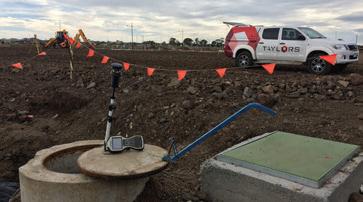

A
LiDAR image helping to better understand the environmental impacts of assets
external parties with restricted access for further analysis. This improves the resource availability, creates costeffective outcomes and reduces risks associated with defects.”
LOOK TO THE SKIES
Another aerial technology recently introduced by Essential Energy to improve planning and scheduling works is drone technology. Fifteen drones are now in operation in Armidale, Bega, Coffs Harbour, Dubbo, Hastings, Tamworth, Tumut, Tweed and Wagga Wagga with the fleet expected to increase in the future.
“Drones are enabling our workforce with mobile solutions that enhance
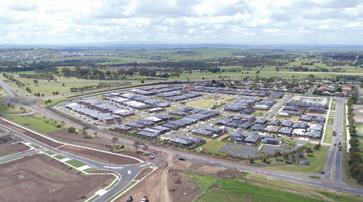
safety, drive efficiency and expand on employee capability with new technology,” Mr Jenner said.
“Successful trials have shown the value drones add by putting staff safety at the forefront, delivering productivity outcomes and returning vital data on the condition of assets.”
Some jobs previously required staff to use elevated work platforms or even physically climb poles — often multiple times. These are now being completed with limited risks for staff and at times in areas that were inaccessible for vehicles or equipment, such as flooded or mountainous terrain.
“Not only can asset condition now be assessed in a safer manner, but drone technology is dramatically reducing the time needed to complete radial live line inspections, as well as identify and resolve faults,” Mr Jenner said.
Overall, Essential Energy’s focus on technology, best practice systems and customer-centred outcomes will provide value for its 1,500 local communities served.
“New tools and technology will allow us to deliver innovative solutions that improve the affordability, reliability and resilience of energy into the future,” Mr Jenner said.

Our range of services include:
● Preparation and administration of contract documentation
● Certification of sewer main, water main and main drainage works
● Intensive surveillance of works ensuring compliance with specifications
● Coordination of inspections
● Practical resolution of construction difficulties and disputes
● Risk assessment
● Certification of works progress
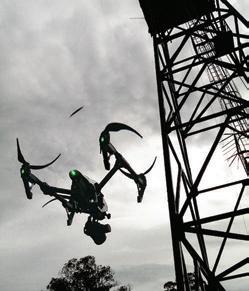
www.infrastructuremagazine.com.au June 2018 // ISSUE 7 43
ASSET INSPECTION & DRONES/UAVS www.taylorsds.com.au Melbourne | Brisbane | Christchurch | Jakarta
Taylors’ practical and experienced team of construction engineers are able to deliver civil engineering works whilst minimising project risk and delays. We offer our clients a full encompassing service from project inception including tendering of works and analysis of tenders, right through to post construction certification.

PLANNING FOR POPULATION GROWTH: FORECASTING TOOL FOR GOVERNMENTS AND UTILITIES
Unitywater operates in one of the fastest developing regions in Australia. The population of the region is expected to grow by 63 per cent in the next 25 years. To meet the requirements of this challenge of projected population and employment growth, Unitywater must be smart in developing tools for infrastructure planning to support the efficient delivery of network infrastructure.
Infrastructure Australia in its Future Cities Planning for our growing population report from February 2018 identified that “while the effects of population growth within Australia’s largest cities will be experienced incrementally over the coming 30 years, many of the key decisions required to successfully cater for change are happening right now. We must ensure that Australia’s governments are equipped with the necessary tools and processes to deliver the planning, policy, regulation and funding required to successfully respond to the population growth.”
Many of the report findings support Unitywater’s approach to planning for population and employment growth namely:
♦ Unplanned growth delivers the worst outcomes for Australia’s fastest growing cities
♦ The need to use existing infrastructure in our cities more efficiently
♦ As demand increases, coordinating and prioritising additional or upgraded infrastructure between and within governments
♦ Well-planned infrastructure to service employment centres enhances the job accessibility of our cities and can deliver national benefits
DEMAND MODELLING, FORECASTING AND TRACKING
One of the key tools developed by Unitywater to forecast growth and infrastructure demand is its Demand Modeller and Tracking Tool (DMaTT). The purpose of the project was to develop and implement an automated demand modelling, forecasting and tracking tool at Unitywater that was credible, consistent, transparent and repeatable.
The project was initiated in 2012 and was developed in-house with the assistance of software vendor Sizztech and was deployed in early 2014.
The DMaTT tool allows the forecasting of future dwelling, population, gross floor area, employment and infrastructure
demand growth at a property level that can be summarised and displayed at any catchment scale (i.e. locality, transport zone or water supply catchment).
DMaTT also has the ability to run more than one forecast model based on “what if” scenarios with changed growth or development density parameters. For example, changes to planning scheme zonings or regional growth boundaries can be modelled to examine the quantum of additional growth, infrastructure demand and the impact on the timing of growth.
Unitywater has published a range of layers developed using DMaTT to a mapping portal, allowing planners and engineers to access growth forecasts and view the type, scale, location and timing of growth and land requirements for development (Figure 1).

The key information inputs into DMaTT forecast models include baseline land use, development approvals, development constraints, planning scheme density provisions, State Government population projections and gross floor area projections. Figure 2 is a graphical representation of how the DMaTT tool constructs forecast models.
June 2018 // ISSUE 7 www.infrastructuremagazine.com.au SMART INFRASTRUCTURE
44
Figure 1

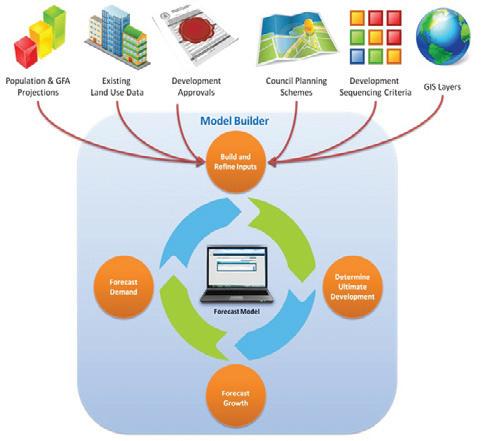
The DMaTT tool has a number of key innovations that benefit town planners and engineers undertaking infrastructure planning:
♦ Demographic and network demand forecasts are undertaken as part of one forecast model ensuring alignment between forecast growth and infrastructure demand
♦ Forecast models are automated and configurable within a user friendly website interface as shown in Figure 3
♦ An unlimited range of growth forecasts and different development scenarios can be examined to produce property level demographic and network demand forecasts within a short time frame (5-7 days for a large council area)
♦ Network demand generation rates can be set for specific land use and development areas for any infrastructure network (i.e. water demand, trip generation, electricity demand) allowing the development of detailed and consistent demand forecasts across infrastructure networks
♦ Property level demographic and network demand forecasts are exported as a spatial layer allowing the forecasts to be used by network modelling packages and viewed as mapping layers
♦ The use of Bayesian Network (BN) for predicting the sequence of development and growth based upon a range of criteria that influences the probability of development (i.e. vacant land, development yield, proximity to infrastructure)

PLANNING FOR QUEENSLAND NETWORKS
DMaTT demand forecasts are currently being utilised in network and capital works planning across Sunshine Coast and Moreton Bay Regional Councils, and Noosa Shire Council areas. In addition, DMaTT demographic forecasts have been utilised by Noosa Shire Council as the source of planning assumptions for there Local Government Infrastructure Plan.
The DMaTT tool is also being used as a tool for planning students at the University of the Sunshine Coast. Students undertaking ENP336 Strategic Infrastructure Planning have been able to merge their studies with industry-specific information and solve problems using a simplified version of Unitywater’s DMaTT tool to examine alternative growth and development scenarios within a study area and the impact on existing and planned infrastructure.
USC Town Planning Program Coordinator, Nicholas Stevens, said the software and course mentoring by Unitywater Planner Chris Teitzel, and delivery by Nicholas Patorniti had been invaluable.
“Using the software during their studies means students have an early introduction to real-life programs used in this industry and real issues that may arise,” Mr Stevens said.
“Working with a large business like Unitywater is hugely valuable for our students and establishing these types of infrastructure and technology industry relationships is what makes our Planning Program unique.”
Sizztech Managing Director, Bradley Rasmussen, said the company was delighted to collaborate with Unitywater and the university.
“The Forecaz Modeller software is a revolutionary tool and it’s pleasing to see USC take an innovative approach to exposing the students to these new technologies and processes as part of this course,” Mr Rasmussen said.
“Industry will welcome USC’s addition of this course to its curriculum, providing graduates with core competencies in strategic infrastructure planning.”
www.infrastructuremagazine.com.au June 2018 // ISSUE 7 SMART INFRASTRUCTURE
Figure 3
45
Figure 2

SMART TRANSPORT DRIVEN BY
UNIFIED CRITICAL COMMUNICATIONS
Road networks are key elements of our critical infrastructure in Australia. They connect our states, cities and towns, and from the heart of our industry to our ports, they are the arteries that deliver vital goods and resources that keep the nation on the move. Our largest cities’ roads are increasingly coming under pressure due to population growth. Road operators are recognising that smart transport starts with unified critical communications to keep them operational, efficient and safe.
Road operators need to enable maintenance engineers to rapidly identify the source of incidents and repair any damage, allow emergency service vehicles to quickly reach accidents and re-route vehicles appropriately, and manage the flow of traffic in the most efficient way possible.
Today’s road networks need to allow a range of stakeholders to reliably and securely share information, using both voice and rich data.
KEEPING MELBOURNE MOVING
Transurban, the organisation which manages and develops urban toll road networks across Australia, grappled with these issues when it sought to upgrade its CityLink communications system. CityLink itself comprises 22km of road connecting some of Melbourne’s busiest areas: the Central Business District, the airport and the Port of Melbourne.
In conjunction with a road widening project, and overall increases in road traffic volumes, Transurban needed to upgrade its communications network to ensure that staff had the connectivity required.
Simoco’s Digital Mobile Radio (DMR) Tier III solution, the Simoco Xd network, is able to offer the highly resilient mission-critical network required. It is designed to deliver reliable
voice calls between remote operatives and centralised offices, and also support data features such as GPS tracking.
The solution comprises base sites, operations vehicles fitted with mobile radios and wireless microphones, and a range of portable radios for staff to use. It is resilient and reliable today, and will scale effortlessly in the future too.
Across the eastern side of Melbourne, Simoco also provides a communications network for the city’s EastLink tollway. This 39km stretch of motorway, which connects the Eastern, Monash, Frankston and Peninsula Link freeways, is the largest urban road project constructed in Victoria and is served by a DMR Tier II solution which provides communications for EastLink highway staff. Real-time assets are also monitored with the Simoco Reveloc Dispatcher and the Simoco Voice Recorder.
TUNNEL VISION
Crucially, the DMR Tier II and Tier III networks operate reliably and securely across the entire area covered by the two major roads, including major tunnels. Tunnels introduce complex challenges to road communications projects, since generating clear and reliable signals throughout requires specific expertise in radio frequency (RF) propagation within confined spaces.
While installing additional specialist antennas within a confined space is sometimes the most appropriate solution, tunnels generally require a radiating cable or ‘leaky feeder’ approach — effectively a coaxial cable with a number of holes introduced at carefully calculated intervals.
This enables the signal to ‘leak out’ throughout the length of the cable. Implementing an effective radiating cable requires in-depth understanding of both coupling loss, the loss of signal from the cable to the user, and longitudinal loss, which relates to how much signal is lost along the length of the cable.
WORKING IN PARTNERSHIP WITH OUR CUSTOMERS
Creating the perfect communications solution for a road network is always a bespoke challenge. From initial design through installation and testing to deployment and ongoing maintenance and support, it is essential to work with a partner who understands the entire process. Simoco Wireless Solutions, with over 25 years of experience in the field, is proud to be able to deliver the communications networks that underpin these vital parts of critical infrastructure for our transport industry customers.
June 2018 // ISSUE 7 www.infrastructuremagazine.com.au 46 SMART INFRASTRUCTURE // PARTNER SOLUTIONS
NATIONAL MAGNET CONFERENCE
Position Partners and Topcon will present the MAGNET Conference on the 17th of August at The Westin Hotel, Sydney.
This one-day only conference will provide attendees with a full breakdown and demonstration of the latest updates to the MAGNET software. Attendees will learn how they can use MAGNET Office to improve efficiency and productivity.
The conference will be chaired by Garry MacPhail, Executive Director and National Geospatial Manager of Position Partners.
Jason Hallett, Vice President of Global Software Business Development, Topcon Positioning Group will present the Topcon Vision to attendees, giving attendees the inside scoop on what’s next for MAGNET Office.
Members of the Topcon MAGNET research and development team will be on-site to discuss and present upcoming developments and address any challenges end users may be experiencing.
Attendees will have the opportunity to attend information sessions detailing the MAGNET Office Version 5 release, new features, enhancements, reviews and product demonstrations. Attendees will also benefit from MAGNET Office support desks and Tips and Tricks sessions.
Greg Goodman from LandTeam is leading the users wish list session where attendees will be invited to help shape the future of MAGNET Office by providing their own wish list for future enhancements.
Throughout the conference, the Position Partners national MAGNET support team will give MAGNET software users the opportunity to participate in three punchy classroom sessions and multiple workshops targeted towards specific features of the software.
The Q&A Panel will give attendees the chance to ask MAGNET Office experts questions specific to their own needs. The Q&A Panel will comprise:
♦ Jason Hallett, Vice President of Global Software Business Development, Topcon Positioning Group
♦ Barkley Hensley, Senior Product Manager for MAGNET Office Products, Topcon Positioning Group
♦ Scott Wielt, Senior Manager of the MAGNET Product Management Team, Topcon Positioning Systems
♦ Graeme Hetet, Technical Support Manager, Position Partners (NZ)
♦ David Banks, Senior Application Specialist, Position Partners
This event will be assessed for CPD points. Tickets to the MAGNET Conference are $300 + GST each, with an early bird rate of $200 + GST each if registered by 13 July 2018.
To book accommodation for the duration of the conference at The Westin Hotel, call 02 8223 1111.
For more information or register for the MAGNET Conference, call 1300 867 266.
SPEAKERS AT THE NATIONAL MAGNET CONFERENCE



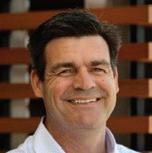




www.infrastructuremagazine.com.au June 2018 // ISSUE 7 SMART INFRASTRUCTURE // PARTNER SOLUTIONS 47
Jason Hallett, Vice President of Global Software Business Development, Topcon Positioning Group
Garry MacPhail, Executive Director, Head of Geospatial Business, Position Partners
Cameron Waters, Business Manager Geospatial Systems, Position Partners
Barkley Hensley, Senior Product Manager for MAGNET Office Products, Topcon Positioning Group
Scott Wielt, Senior Manager of the MAGNET Product Management Team, Topcon Positioning Systems
Greg Goodman, Professional Surveyor and Managing Director, LandTeam Australia
Graeme Hetet, Technical Support Manager, Position Partners (NZ)
David Banks, Senior Application Specialist, Position Partners
WHAT MOBILITY AS A SERVICE COULD MEAN FOR AUSTRALIA
The iMOVE Cooperative Research Centre (CRC) is taking significant steps forward in the development of Mobility as a Service (MaaS) in Australia to improve the movement of both people and freight. iMOVE Managing Director, Ian Christensen, discusses some of the mobility projects and research the centre is doing, the opportunities and challenges, and how iMOVE will continue to support the implementation of a successful MaaS approach.
iMOVE CRC’s primary objective is to improve the mobility of people and freight through better use of data. It supports companies and organisations that want to invest in Australia’s transport future through the development of new products and services.
Managing Director of iMOVE Australia, Ian Christensen, said, “We work with our industry partners to identify objectives within the general scope of smart mobility.
“For the purposes of discussion, we separate our research into three streams — infrastructure, people and freight — however these are all strongly interrelated and many projects fall across at least two of them, although each area has its own particular challenges.
“iMOVE wants to facilitate projects that deliver tangible outcomes to industry participants. We achieve this by identifying problems and opportunities that matter to industry organisations.”
For each industry-identified opportunity, iMOVE assembles partners with the skills and capabilities needed to deliver the project. This not only includes corporations but also entities such as government departments, and road and transport authorities.
With this in mind, iMOVE, together with Intelligent Transport Systems Australia (ITS Australia), is undertaking a project to better understand what Mobility as a Service could mean for Australia.
EXPLORING MOBILITY AS A SERVICE
ITS Australia, through the iMOVE CRC, is partnering with the Institute for Choice (University of South Australia), and leading

transport stakeholders — Transport for Victoria, Transport for NSW, Translink, Department of Transport WA and Royal Automobile Association SA — to develop a MaaS consumer research report asking the questions: What does MaaS mean for Australia, and what do Australians think?
“There’s a level of debate over the definition of ‘MaaS’ but for our purposes we can define it as integration of multiple modes of transport into a single, intermodal travel service, accessible on demand. This includes all modes of public transport as well as car share, bike hire, taxis and Uber. A key aspect is the placing of users at the centre of the mobility options,” Mr Christensen said.
“The main benefits of an integrated MaaS system are easier mobility for individual travellers and better distribution of demand across all infrastructure, leading to a range of transportation improvements – in speed, reliability and cost.
“It also reduces the need for car ownership, thus providing a range of benefits, including potentially: reduced congestion, reduced need for parking facilities and reduced need for people to fund large capital outlays on car purchases.”
The overarching goal of this project is to find out where Australia is placed locally and globally with MaaS. It aims to find out what people think through analysing existing research, determining Australian expectations in this area and finally, identify opportunities for Australia.
The project will result in the publication of a report that will lead the discussion around MaaS in Australia and go to a variety of high profile decision-makers such as ministers and industry leaders. Ultimately it will help develop transport systems that work in the Australian context and also take advantage of the opportunity to produce and deploy new transport services.
Through this and other research, iMOVE has identified some key challenges when it comes to integrating MaaS in Australia.
“A MaaS approach requires reliable availability of real-time data – particularly from transport vehicles,” Mr Christensen said.
“There are also needs for journey planning algorithms that organise each journey, and transaction mechanisms behind the scenes by which the travellers’ payments get distributed to transport operators.
“Different cities are at different stages along this path, with the leading cities having already established effective data sharing regimes. Some of them have made good progress in working out how to distribute traveller revenue across operators. However, no one has yet established a fully integrated ‘travel wallet’.”
June 2018 // ISSUE 7 www.infrastructuremagazine.com.au
48 MOBILITY

USING FREIGHT DATA TO IMPROVE SUPPLY CHAINS
Australia’s standard of living depends crucially on the smooth and efficient flow of goods into and out of the country, and into the hands of Australian consumers wherever they are located. However, some of the technology and information flow in Australia’s supply chains lack visibility and have poor ability to predict arrival times. This causes massive inefficiencies in the supply chain nationally.

LEADING AUSTRALIA’S MOBILITY FUTURE
Australia is currently facing challenges to accommodate our rapidly growing freight task and the distribution of manufactured goods.
To cope with these pressures, iMOVE anticipates that a combination of supply side and demand side initiatives will be needed.
“iMOVE wants to help the freight sector lift its game in this area and we’ve already found companies keen to be involved in projects,” Mr Christensen said.
“We are excited by the results of a 2016 ALC/Austroads trial that demonstrated the benefits of establishing visibility over product movement along a single supply chain.
“Based on this, we want to develop and implement a more general system that will, in response to a unique freight identifier, give the position and status of that item of freight regardless of which party has current carriage or control.
“Noting the industry’s concern about data integrity and confidentiality the new system will avoid aggregating all data into a single repository and access to data will be limited to those with authority to see it.”
The project will include a strong focus on policy, process and data structures, as well as the development of on-ground infrastructure to demonstrate the effective operation of the system.
iMOVE also has an ongoing project in Western Australia looking at intermodal logistics planning for key ports and associated road and rail infrastructure.
“This kind of longer-term planning is invaluable for the efficiency of our supply chains and supports our ability to export Australian goods. Another project is looking at fleet network optimisation, again to improve efficiency,” Mr Christensen said.
“We expect to see even more activity over the coming years in this area, especially given the explosion in demand for freight services due to population growth and online shopping.
“This is placing heavy stresses on our freight systems and challenges us to find new ways to operate, including how to better integrate road and rail transport and how to better deliver the ‘last mile’ freight task.”
“This includes increased physical infrastructure — more roads etc. — as well as technology to operate them at higher capacity,” Mr Christensen said.
“On the demand side of the balance, we look to encourage people to spread their travel over wider range of modes and times, and to facilitate the movement of freight through the network outside of the morning and evening peak hour.
“We need to be alert to the need to establish real-time electronic visibility over vehicles and people moving through infrastructure systems and look for opportunities to use this newly available data to improve the performance of efficiency of infrastructure assets.”
To do this, iMOVE looks to use technologies and processes such as automatically reporting the GPS positions of public transport vehicles and the development of journey planning algorithms that can build journeys across multiple modes of transport.
“As well as developing technologies, we also need to recognise the human aspects. We need to understand the strength of traveller preferences and tolerances for characteristics such as reliability, cost, overcrowding and safety," Mr Christensen said.
Mr Christensen said we can prepare the pathway for mobility in the future by improving the availability of data from all transport modes and working out how to deliver on-demand services. Having clarity around the relative costs of different infrastructure support for each transport mode will shed light on the viability of mobility projects in Australia.
www.infrastructuremagazine.com.au June 2018 // ISSUE 7 49 MOBILITY
Find out more about iMOVE activities at imovecrc.com.
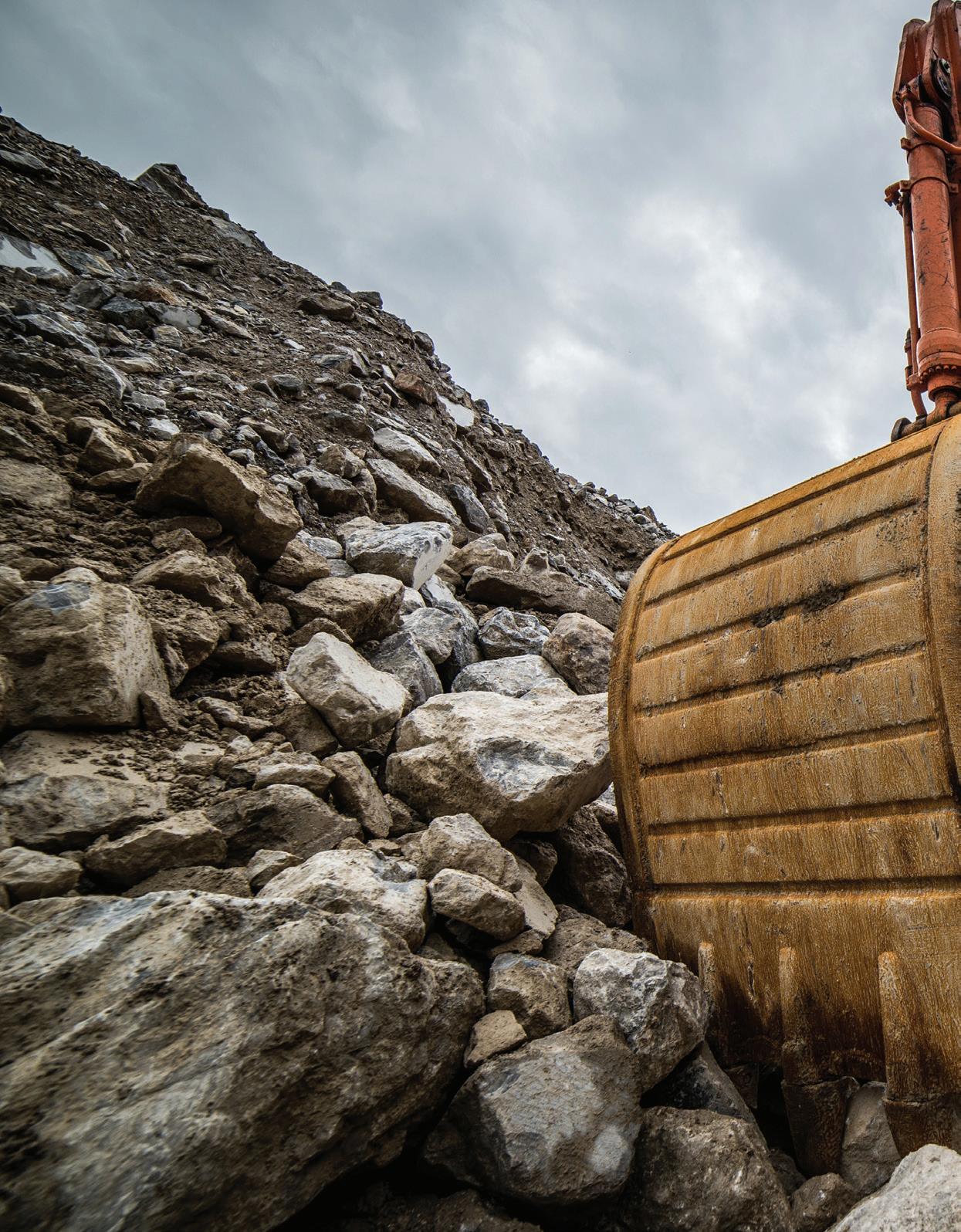
TOO MUCH OF A GOOD THING?
June 2018 // ISSUE 7 www.infrastructuremagazine.com.au 50 EARTHMOVING OUTLOOK
EARTHMOVING INDUSTRY OUTLOOK 2018/2019

In recent years, the earthmoving equipment market in Australia has witnessed a surge in demand, largely driven by increased government spending toward infrastructure projects. We spoke to several industry leaders to find out some of the current trends in the infrastructure and earthmoving space, and where the challenges and opportunities lie in the future.
www.infrastructuremagazine.com.au June 2018 // ISSUE 7 51 EARTHMOVING OUTLOOK

All respondents had a positive outlook for the upcoming 2018/2019 financial year, with demand for new earthmoving machines predicted to only increase.
“The Australian industry for new machines is now at an all-time high. In 2017, there was over 15,000 new machines delivered nationally, which was an increase of over 20 per cent from 2016. In 2018/19, the forecast for new machines is expected to reach over 10 per cent year on year,” Caterpillar Global Construction and Infrastructure Manager, Ranil Tennakoon, said.
General Manager of Construction and Forestry Sales at Hitachi Construction Machinery, Frank Gili, said the company is extremely optimistic about the coming financial year, even if growth in demand slows compared to last year.
“We expect market demand to continue to increase across most major machine classes, however, perhaps not at the rate we experienced in FY18. Continued investment in infrastructure projects, predominantly on the east coast, will continue to fuel this market demand growth. Hitachi Construction Machinery is positive in regards to the opportunities in FY19.”
General Manager of Melbourne Tractors, Matt Thorne, said that as a result of new construction projects across the country, the company was expecting an increase in sales at all of its dealerships.
“The residential boom in Victoria is progressing well with no sight of slowing down, and the Queensland Road and Rail projects will bring about a lot of work for the Queensland construction industry.”
Semco Equipment Sales Corporate Accounts, Director, Graham Murphy, also confirmed that there are currently plenty of large infrastructure projects, more than he had seen for many years.
“Semco is mainly focused on the light to medium class of construction equipment and we are seeing strong demand which we think will be sustained, so long as the housing industry remains buoyant.”
MAJOR PROJECTS CONTINUE TO DRIVE CONSTRUCTION BOOM
Mr Murphy said that he was seeing major investment in road and rail projects in several capital cities, most notably Sydney, Brisbane and Melbourne.
Mr Thorne highlighted the Inland Rail, Ipswich Motorway upgrade, Bruce Highway upgrade, Cross River Rail and M1 upgrade projects in Queensland, and the Melbourne Metro Rail, Melbourne Airport Link, West Gate Tunnel and NorthEast Link projects in Victoria as the biggest projects currently planned or underway in Australia.
Sydney’s second airport, Victoria’s West Gate Tunnel and Melbourne Airport rail link, and Queensland’s Bruce Highway project were top of Mr Tennakoon’s list of the biggest projects currently underway or planned in Australia, with Mr Tennakoon adding that he expected to see an increase in demand for large projects like these.
According to Mr Gili, “There are many large infrastructure projects (road, rail and housing) both current and planned that will continue to drive construction machinery demand.”
UNDERSTANDING THE CHALLENGES AHEAD
Both Mr Tennakoon and Mr Murphy said that the main challenge facing earthmoving equipment suppliers was getting access to capable staff, particularly good operators, diesel fitters and field workers.
“Maybe we are not training enough apprentices, although Semco does it’s share. Quite a few are striking out on their own and becoming contractors, which is a double-edged sword. The level of tech-savvy that diesel fitters need these days and the tooling to keep up with the low emission engines and other electronics suggests they may struggle on their own,” Mr Murphy said.
“Some of the challenges facing the industry are safety and access to good operators. The industry is addressing these challenges by investing in technology to help reduce fatigue, and use of on-board technology to provide unmatched protection for people, equipment and existing assets and infrastructure on work sites. Technology is also allowing operators to move more dirt and be more accurate in a faster time frame, therefore improving overall productivity,” Mr Tennakoon commented.
While earthmoving equipment suppliers are enjoying the spike in sales, managing the supply chain to meet market machinery demand also brings its own challenges.
“Manufacture of machines continues to increase significantly and while most Original Equipment Manufacturers (OEMs) have the capacity to increase volumes, predominantly by adding an extra shift, downstream suppliers are struggling to ‘feed the OEMs’,” Mr Gili said.
“As a consequence we are starting to see lead times increase significantly. To counter this significant increase in demand, OEMs are now increasing their forecast volumes on their downstream suppliers and also seeking alternative supply sources to assist in maintaining market acceptable lead times.”
Mr Thorne said that most manufacturers have ramped up production to meet the new global demand.
“The Australian excavator market is up 37 per cent from last year which is causing factories to run over capacity. And this increase in sales isn’t just occurring in Australia but worldwide which means we are competing with other nations for excavator supplies.”
Mr Murphy also shared this sentiment, commenting, “Customers need a strong dealer support base here if they want to work machines hard and shift dirt. We are just two per cent of the world market so it is an issue for OEM distributors and dealers where they are expected to support brands through their working lifetimes with parts and service.”
June 2018 // ISSUE 7 www.infrastructuremagazine.com.au 52 EARTHMOVING OUTLOOK






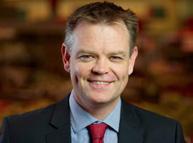








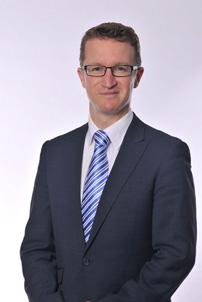












ALL THE BIG ISSUES. ALL THE KEY PLAYERS. ALL UNDER ONE ROOF. REGISTER TODAY +61 (0)2 9977 0565 www.smartmobilityshow.com.au With key experts from across industry including: Annie Lien Industry Expert & Advisor Self-Driving Cars Autonomous Driving (San Francisco) Stuart Ballingall Director Transport Futures VicRoads Chief Executive Officer car2go Europe GmbH Barbara Wise Commissioner NSW Point to Point Transport Commission Compliance & Technology Lucas Groeneveld State Manager - Victoria & Tasmania Uber Conrad Harvey Chief Information Officer Linfox 18-21 JUNE 2018 | HYATT PLACE MELBOURNE, ESSENDON FIELDS | AUSTRALIA 5 NETWORKING 3x WORKSHOPS 500+ ATTENDEES 2x CONFERENCE STREAMS 60+ INDUSTRY SPEAKERS 20+ EXHIBITORS
we move
transforming -
it’s not just about driverless vehicles. The entire mobility ecosystem is changing: how we pay for it, the technology that supports it, how goods are transported.
Smart Mobility Show can help you prepareattend the Future Vehicles Summit stream or IoT for Transport & Logistics Summit stream. Anthony Riemann Director, Strategy & Urban Mobility General Motors International Holden Rachel Johnson Chief Executive Officer Victorian Ports Corporation Vice President Information Technology, Australia New Zealand & Life Sciences & Healthcare APAC DHL Supply Chain Endorsing bodies Media partner Innovation zone partner Silver sponsor Gold sponsor Platinum sponsor Organised by
The way
is
and
The
MAXIMISING PRODUCTIVITY AND EFFICIENCY ON TELECOMMUNICATION PROJECTS
The growth of the telecommunications industry in Australia — particularly with the rollout of the NBN — has presented contractors with a range opportunities, but it is not without its challenges. Having the right equipment can overcome these challenges, allowing contractors to complete installations with ease and within deadlines. Along with the support of strong before and after-sales customer service, contractors can get the competitive edge to grow their business.

June 2018 // ISSUE 7 www.infrastructuremagazine.com.au 54
EARTHMOVING OUTLOOK // PARTNER SOLUTIONS
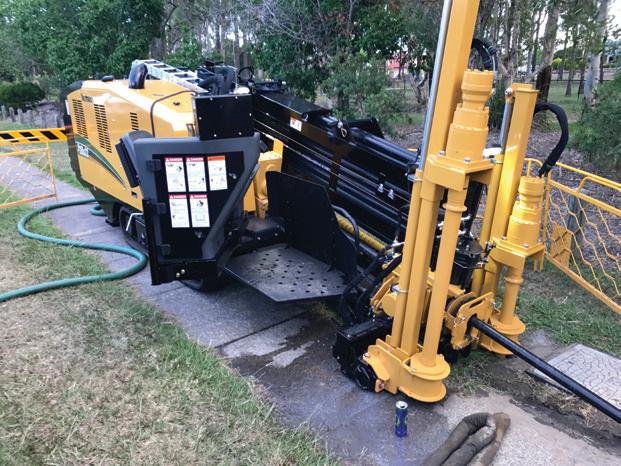

Lawrence Bourke, Owner of Queensland-based L&K Directional Drilling, first opened the business in 2015 under the name Bourke Fibre Optics Solutions, completing NBN service installations, splicing and lead ins.
“In 2017, we wanted to become a more versatile company so we began undertaking large civil projects. We first came across directional drilling when we were installing nodes as we had to subcontract a lot of the work. I found it intriguing and wanted to know more,” Mr Bourke said.
This led to Mr Bourke purchasing a used Vermeer D18X22, and he liked it so much that ten months later he bought a new Vermeer D20X22 S3. To reflect the company’s new capabilities, he changed the company name to L&K Directional Drilling.
“We now do all of our own service locating, directional drilling and civil construction in underground telecommunications. In the future I would like to obtain more projects that specialise in gas, water and power installations,” Mr Bourke said.
CONSIDERATIONS WHEN SELECTING A DIRECTIONAL DRILL
Mr Bourke said there were three key reasons that led him to purchase the D20X22 S3: size, remote control and safety.
The D20X22 S3, like other drills in Vermeer’s horizontal directional drill range, has been designed to maximise productivity and efficiency while working in tight spaces and challenging conditions.
The D20X22 S3 is available with an optional remote control which enables tracking and setup of the drill from convenient locations, and provides safer loading, unloading and tracking of the drill in hazardous areas.
It also allows the operator to choose their perspective when working in challenging conditions, which increases safety.
“The safety features are outstanding, and using the remote control to move the drill is extremely useful, especially loading on and off the truck, and when getting into tricky locations,” Mr Bourke said.
“It is also a good size drill for telecommunications work.”
Mr Bourke said since purchasing the D20X22 S3 the company has completed all projects with ease even when working with difficult ground conditions.
“We have used the D20X22 S3 to successfully complete an NBN installation in Kilcoy, South East Queensland. During the project we came across a lot of rock and this drill cut through it with ease.
“It has become an asset for the business as it is quick and reliable, allowing us to complete projects ahead of deadlines.”
SUPPORTIVE RELATIONSHIP TO GROW
Mr Bourke said one of the advantages of working with Vermeer is its strong customer service, and the relationship its sales team build to ensure the business is getting the right equipment for its needs.
“I have a brilliant relationship with the Vermeer team in Richlands, Queensland. Anthony O’Grady is a great salesman and his team are always helpful,” Mr Bourke said.
“We are looking at expanding the business and purchasing a bigger drill and another vacuum truck sometime in the near future.
“We are constantly looking for ways to improve our business and Vermeer offers different options for top-of-the-range, reliable equipment.”
www.infrastructuremagazine.com.au June 2018 // ISSUE 7
55 EARTHMOVING OUTLOOK // PARTNER SOLUTIONS
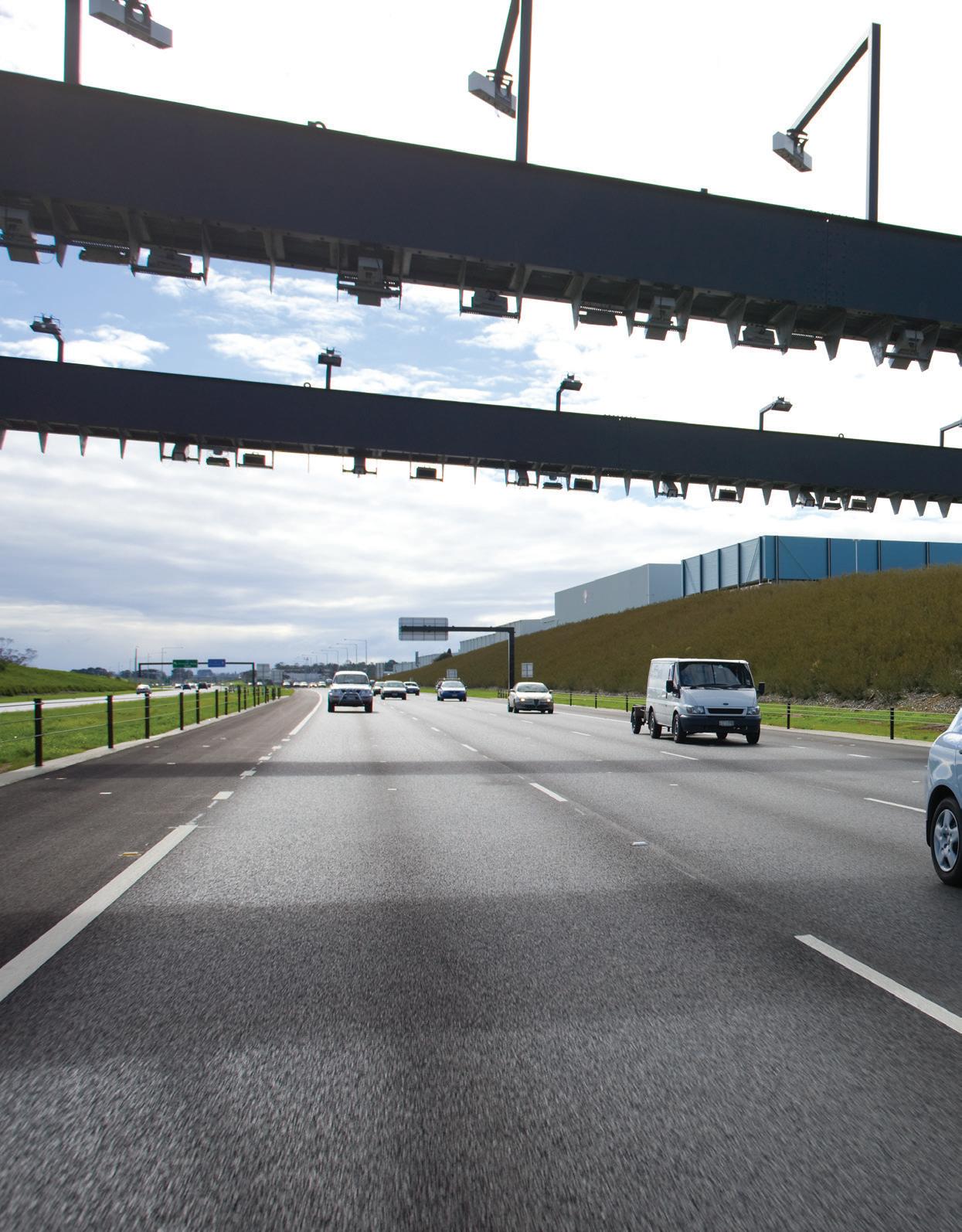
– THE TOLLING INDUSTRY
IN TEN YEARS SCENARIO 2028
One of Australia’s largest tollways, EastLink, takes a look at the achievements of Australia’s tolling industry to date, and the future convergence of connected autonomous vehicles, tolling and road user charging.
56 June 2018 // ISSUE 7 www.infrastructuremagazine.com.au
TOLLING
ACHIEVEMENTS OF THE AUSTRALIAN TOLLING INDUSTRY
EastLink’s 40km road network is the largest privately operated network in Victoria. EastLink is the major north-south transport artery in Melbourne’s east, connecting the Eastern, Monash, Frankston and Peninsula Link Freeways.
Australia has 17 world-class toll roads with more under construction or planned. Every toll road in Australia operates with multi-lane free-flow technology. Tolling plazas, kiosks, coin baskets and boom gates have been eliminated from the nation.
Almost uniquely in the world, Australia has 100 per cent tag interoperability. Any tag, issued by any tolling operator, can be used on any toll road in the country. Every day, operators exchange the latest data about Australian tags. A tag beeps correctly whichever toll road it’s on. Operators even exchange

licence plate details, so that if a tag transaction fails, for example the tag is not fitted correctly, the correct toll is still applied to the tag account.
EastLink Corporate Affairs and Marketing Manager, Doug Spencer-Roy, said, “Australian tolling systems operate with a relatively high performance. EastLink’s tolling system alone processes more than 1.2 million toll point transactions per day. The system consolidates these toll point transactions into a quarter of a millions trips per day.”
18 per cent of trips on EastLink have no valid tag. Instead, images are taken of the vehicle’s licence plates. Well over 90 per cent of these licence plate images are read fully automatically, with less than 10 per cent proceeding to manual verification by an image processing operator. This is despite the vehicles travelling at 100km/hr day and night, in
57 www.infrastructuremagazine.com.au June 2018 // ISSUE 7
TOLLING
Tolling gantries like this will be removed
all-weather conditions, and the myriad of licence plate formats and colours on Australian roads.
“After account, trip pass and toll invoice payments have been received, less than one per cent of trips on EastLink remain as unpaid debts,” Mr Spencer-Roy said.
Over the years, the tolling industry has made huge strides in improving customer services. At EastLink, 94 per cent of accounts receive electronic statements instead of paper. 62 per cent of account customers have set up fully automatic payment, significantly improving the customer experience.
“The EastLink website now receives more than 25,000 user sessions per day. This compares to EastLink’s Melbournebased call centre operators, who receive less than a tenth of that volume in calls,” Mr Spencer-Roy said.
29 June 2018 is the 10th anniversary of EastLink’s opening. EastLink GM Information Technology, Bill Advic, said, “Over ten years, systems start to become obsolete. EastLink’s original back office tolling system had become too expensive to maintain, was near end of life, and would no longer be supported by the vendor. The decision was made to replace it with a new tolling system implemented by SICE, the Spanishbased international ITS provider.”
The cut over to the new tolling system was relatively seamless. The original tolling system was suspended last year on Friday 19 May. And the new system was progressively started up just two days later. No toll charges were lost during the transition.
“Almost exactly one year after switching to the new system, software development defects – which are inevitable in a project of this size – have been resolved,” Mr Advic said.
“Customers and staff have become accustomed to the new features and business rules that were implemented with the new system. Once again it’s business as usual for EastLink, and we are turning our thoughts and efforts to new opportunities for improving the customer experience using the new tolling system.”
POTENTIAL FOR TOLLING IMPROVEMENTS IN THE SHORTER TERM
For infrequent tollway users who have video accounts rather than tags, there is usually only interoperability within each state. A video account from a Victorian operator can’t be used to pay for a trip in New South Wales or Queensland, for example.
“There is no technical impediment to achieving 100 per cent video account interoperability. EastLink believes that it’s time for the industry to close this gap for infrequent users,” Mr Spencer-Roy said.
“In Victoria, a casual user can buy EastLink trip passes and CityLink 24 hour passes. Some might be confused by the fact these passes work in quite different ways. And if a casual user drives on CityLink and EastLink within the space of a few days they need to buy these passes from separate websites.
“If a casual user chooses to wait for toll invoices, separate invoices are sent by EastLink and CityLink, which need to be paid separately. With more tollways coming to Victoria in the future, the risk is more confusion for casual users. EastLink believes the industry players in Victoria should work together to find ways to make it easier for casual users.”
While less than one per cent of trips on EastLink are unpaid, there is recognition that tolling and infringement debts often accumulate in cases where the vehicle registration authority has out-of-date or incomplete post, phone and email contact details for the owner of a vehicle. In these cases, toll invoices,
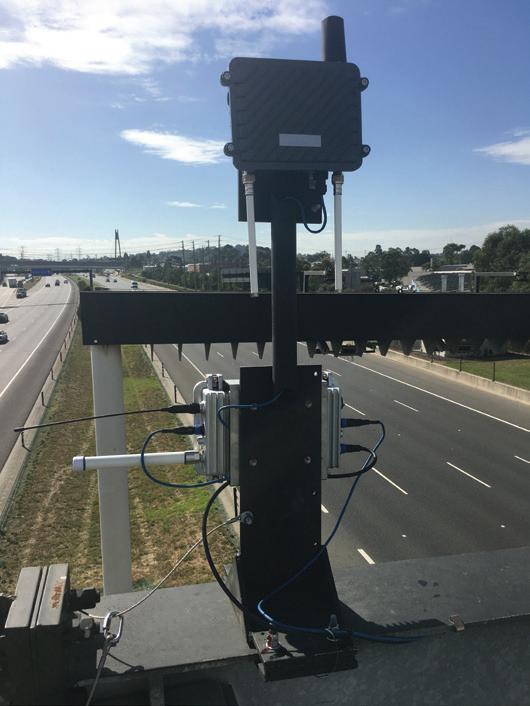
overdue notices and infringement notices may not be delivered to the owner.
“We ask that registration authorities consider new measures to improve the quality of contact details for the owners of vehicles,” Mr Spencer-Roy said.
Increasingly, stolen and cloned number plates are a burden. In many cases, the stolen or cloned number plate is fitted to a vehicle of the same make, model and colour as the original vehicle.
In these circumstances, it is unreasonable to expect a toll road operator to be able to determine whether a vehicle is the original vehicle or the illegal vehicle.
“Motorists who report their licence plate cloned or stolen should be issued with a new licence plate by the registration authority, and the original licence plate number should be cancelled. Banks don’t let customers continue to use credit cards whose details have been compromised. Registration authorities should take the same approach with licence plate numbers,” Mr Spencer-Roy said.
A FUTURE VISION FOR CONNECTED AUTONOMOUS VEHICLES, TOLLING AND ROAD USER CHARGING
EastLink Managing Director, Charles Griplas, said, “The EastLink concession continues until 2043. There are going to be many changes during this time.”
Late last year, EastLink conducted the inaugural Annual Victorian Self-Driving Vehicle Survey. More than 15,000 Victorian motorists completed the survey, making it one of the world’s largest surveys of attitudes to self-driving cars.
“The results show that Victorian motorists are looking forward to change,” Mr Griplas said.
♦ More than half of respondents are no longer considering a traditional petrol combustion engine for their next car
58 June 2018 // ISSUE 7 www.infrastructuremagazine.com.au TOLLING
V2X transceiver equipment on EastLink toll point

♦ A third of respondents are now considering hybrid power as an option for their next car
♦ A quarter are considering the 100 per cent battery electric vehicle option. Is Australia now ready to set a final date for the sale of new petrol/diesel cars in favour of hybrid and 100 per cent battery electric vehicles?
♦ More than half of respondents want lane keeping assistance (also known as highway autopilot) in their next car, which should encourage manufacturers to continue to roll this out, and other driver assistance features, and ensure they work effectively on our freeways
♦ Even though hands-free driving on our freeways is not yet available, one in three respondents already want this feature in their next car
♦ The majority of respondents want their next car to be connected to a data network to receive traffic and road condition warnings, vehicle security and automatic emergency assistance
“It’s now up to vehicle manufacturers, road operators, governments and others to work together and deliver the changes that motorists are pushing for,” Mr Griplas said.
SCENARIO 2028 – TEN YEARS FROM TODAY
Let’s take a look at a future scenario, ten years from today, envisioned by EastLink. It’s 2028. Connected autonomous vehicles make up a third of the vehicle fleet.
Most of these are privately owned SAE Level 3 vehicles — able to drive themselves, legally, on freeways and major highways without driver supervision. However, the driver still needs to take control of the vehicle in more difficult situations such as urban streets.
In 2028, some of the latest luxury vehicles have SAE Level 4 capabilities. On the most common journeys, such as to and from work, they have self-learned to drive completely autonomously.
By 2028, fully self-driving SAE Level 5 cars have started to appear in Melbourne and other state capitals, with vehicle sharing providers taking the lead. These vehicles don’t have a steering wheel or driving controls. Their range is limited to metropolitan areas that have been mapped in very high resolution, such as with LIDAR. However, they are very popular with younger people, who are increasingly not bothering to get driving licences.
In 2028, the proportion of connected autonomous vehicles is growing rapidly, as only connected autonomous vehicles can be imported.
In this scenario, connected autonomous vehicles will make up more than half of the vehicle fleet a few years after 2028. So transport planning becomes geared towards connected autonomous vehicles. This includes tolling.
By 2028, tolling tags are no longer issued for connected autonomous vehicles. Instead, connected autonomous vehicles track themselves across the road network, and on-board apps calculate the tolls that apply to the vehicle’s travel. The on-board apps are able to do this using the full range
of precision location-awareness technologies embedded in connected autonomous vehicles, such as GPS and LIDAR maps. Payment arrangements can be set up and administered via the on-board app. The on-board app does most of the work that is done by today’s centralised tolling systems — a “fringe processing” model.
By 2028, tolling gantries, tolling tags and image capture of licence plates are only used for older legacy vehicles. With legacy vehicles set to be in the minority, plans are developed to remove tolling gantries from tollways in the years following 2028. All legacy vehicles will receive a mandatory tolling and road user charging OBU (on board unit) comprising GPS, SIM card and mobile data connection.
At the same time, connected autonomous vehicles receive updated apps to include road user charging.
From 2028, some lanes on freeways become dedicated to connected autonomous vehicles driving in autonomous mode, with platooning to unlock capacity gains.
SCENARIO 2038 – TWENTY YEARS FROM TODAY
Another ten years pass, and EastLink envisions that by 2038 most legacy vehicles are off the roads, helped by “cash for clunkers” programs. SAE Level 4 and 5 vehicles make up the majority of the vehicle fleet.
Private vehicle ownership will be declining, replaced by vehicle sharing. Around 2038, freeways and highways will be reconfigured.
One or two painted lanes in each direction will be used by the remaining human driven vehicles and the earlier generations of connected autonomous vehicles that are dependent on painted lane markings. The rest of the roadway will be unpainted.
From 2038, virtual lanes will be managed in real time by a terrestrial traffic control system communicating directly to connected autonomous vehicles. Tidal lanes and high occupancy lanes will be created and removed by the traffic control system as traffic volumes require. During peak hours, the traffic control system reduces speeds to allow more virtual lanes to be fitted into the same space.
The 2038 traffic control system will be able to direct controlled amounts of self-driving vehicle traffic, at lower speeds, through side streets, to take advantage of unused capacity while not impacting safety or local amenity.
THE TOLLING INDUSTRY NEEDS TO BE UP FOR THE CHALLENGES AHEAD
“Of course, none of us can predict accurately what will happen in 2028 or 2038,” Mr Griplas said.
“But this is going to be a fascinating journey, bringing together connected autonomous vehicles, ITS, tolling and road user charging, full of technical and commercial challenges.
“The tolling industry needs to be up for these challenges, if it’s going to continue to keep Australia moving through the forecast population growth.”
59 www.infrastructuremagazine.com.au June 2018 // ISSUE 7 TOLLING
THE TECHNOLOGIES CONGESTION ON OUR


We understand congestion is a fact of life in a busy city such as ours – but by targeting the most important improvements at congestion hotspots – we can deliver relief where it’s needed most.
More than 1.1 million Melbournians drive vehicles to work each day with an additional 83,000 people travelling to work as passengers in vehicles. VicRoads manages and maintains over 23,000km of arterial road across Victoria.
We’re delivering billions of dollars in road upgrades to tackle congestion and cut travel times so Victorians spend
by Sameem Moslih, Director Journey Services, VicRoads
Melbourne’s population is growing by almost 2,000 people each week, which means that the number of people who travel on our roads is increasing.
less time stuck in traffic. We’re building, upgrading and improving roads right across Victoria to connect communities, increase capacity on our road network and ensure people have more transport choices closer to where they live.
While there is an unprecedented amount of work going on, we know we can’t simply build our way out of congestion. This is why we’re investing in technology-based solutions, including better monitoring and data collection, so we can get more vehicles moving more efficiently on our existing road network.
IMPLEMENTING COMPLEX TECHNOLOGIES
VicRoads has more than 600 Bluetooth sensors on the network and complex technology under our major freeways which help us reduce the onset of congestion or divert traffic from incidents.
We're continuously exploring and adopting new and cutting edge technologies to reduce congestion and improve journeys right across Victoria.
We’re using Lane Use Management Signs on many of our major freeways which use electronic overhead signs to provide road users with real-time
June 2018 // ISSUE 7 www.infrastructuremagazine.com.au
60 VICROADS
TACKLING OUR ROADS

information on road condition ahead.
These signs enable us to adjust speed limits and close lanes depending on road conditions and following emergencies, such as crashes, which not only improves the management of these incidents, but also provides smoother and safer journeys for drivers.
On many of our major freeways, including the Monash and West Gate Freeways, we’re using ramp metering which controls the amount of traffic entering the road, particularly during periods of heavy traffic volumes or following major incidents.
On-ramp metering has already proven highly effective in regulating traffic flow, with average speeds along the Monash Freeway increasing by 20km/h and casualty rates dropping by 30 per cent over the past decade.
Streamlining Hoddle Street is an example of a project where we’re using
technology to help relieve congestion along this important corridor in metropolitan Melbourne.
More than 330,000 drivers travel along Hoddle Street every day making it Melbourne’s busiest arterial road. It has connections with all of Melbourne’s major freeways and train, tram, bus and cycling routes.
At the Hoddle Street and Punt Road intersection, we’re changing the design of the intersection to continuous flow. Currently, right turns take up to 40 per cent of green time at the Swan Street and Punt Road intersection during the morning and afternoon peaks.
Drivers wanting to travel straight through the intersection often get stuck at the red light when drivers making right turns are on green time. Continuous flow reduces the long queues and delays you experience when other drivers turn right.
With continuous flow, drivers travelling south on Punt Road and wanting to turn right onto Olympic Boulevard will have a new, dedicated right-turn lane which will allow them to turn right at any time without delaying traffic travelling behind.
This means drivers on Swan Street can continue travelling through the intersection while drivers turning into Olympic Boulevard make their turn.
Changing the way drivers turn right will reduce the delays and queues along Punt Road and unlock the time drivers need to travel through the intersection.
Traffic congestion is an ongoing challenge, but at VicRoads, we’re investing in and developing new technologies and innovative solutions to keep Victorians moving.
www.infrastructuremagazine.com.au June 2018 // ISSUE 7 TECHNOLOGIES
61 VICROADS
BUCKLE UP – MODIFYING VICTORIA’S ROADS FOR SAFETY
by Bryan Sherritt, Director Safe System Road Infrastructure Program, VicRoads

Not many people like to admit this, but everyone makes mistakes on our roads. That’s why we’re currently rolling out safety infrastructure across our state’s highest risk country roads.
The tired driver who just wants to get home, the distracted driver who loses concentration, the young driver who isn’t yet experienced in wet conditions.
We’ve made seat belts mandatory and introduced tough drink driving laws — but we can’t legislate against the mistakes people make on our roads.
So we’re making these roads safer and more forgiving for when mistakes do happen.
Country roads – like the Hume, the Calder, the Princes Freeway – are where we see too many people losing their lives in head-on and run-off-road crashes.
In fact, these were the biggest cause of fatalities on country roads last year.
The number of people killed on rural roads increased by five in 2017, from 150 to 155. Of those, 109 were involved in a crash where a vehicle left its lane, with 72 lives lost in singlevehicle crashes on the roadside, and 37 deaths resulting from a head-on collision.
INSTALLING BARRIERS AND STRIPS
To reduce the number of people being killed and injured on our roads, we’re installing flexible safety barriers on the edge and sometimes in the centre of our highest risk country roads.
They work by absorbing the force of a crash and bringing the car to a gradual stop, and are proven to reduce the risk of being seriously injured or killed in a crash by around 85 per cent.
Last year alone there were more than 1,700 hits recorded to flexible barriers across the state.
That’s many serious or even fatal crashes prevented. Crashes where in many cases the driver could simply drive away perhaps shaken, but not hurt.
Another safety treatment we’re rolling out on our highest risk roads
is audio tactile line marking, more commonly known as rumble strip line marking.
When a vehicle drives over them, the rumble strips vibrate and alert the driver to the fact they’ve strayed from their lane.
Research from the US shows a 37 per cent reduction in head-on crashes and a 26 per cent reduction in runoff-road crashes where centreline and edge rumble strip line marking was installed.
NEW LANES AND INITIATIVES FOR MOTORCYCLISTS
We’re also building more overtaking lanes to provide drivers more opportunities to safely overtake, widening the centre of roads to prevent head-on crashes, and building roundabouts to improve the safety of dangerous intersections.
We’re also undertaking safety improvements specifically targeted at motorcyclists, who are some of our most vulnerable road users.
Things that seem small for a driver can be disastrous to a motorcyclist, like gravel on the road or an uneven road surface, particularly at corners.
That’s why we’re making sure that the roads used most frequently by motorcyclists are safer by modifying barriers with cushioning and ‘rub rail’, sealing driveways and side roads to prevent gravel getting on the road, and doing more maintenance works to ensure a smoother ride.
It’s all part of the Victorian Government’s Towards Zero goal to ensure nobody is killed or seriously injured on our roads.
The $1.1 billion Towards Zero Action Plan is funded through the Transport Accident Commission (TAC) and is being delivered by VicRoads.
It’s a transformational program of works that will drastically improve the safety of these high risk country roads. Our aim is simple: to save lives.
62 June 2018 // ISSUE 7 www.infrastructuremagazine.com.au
VICROADS
INLAND RAIL CONFERENCE
INLAND RAIL CONFERENCE




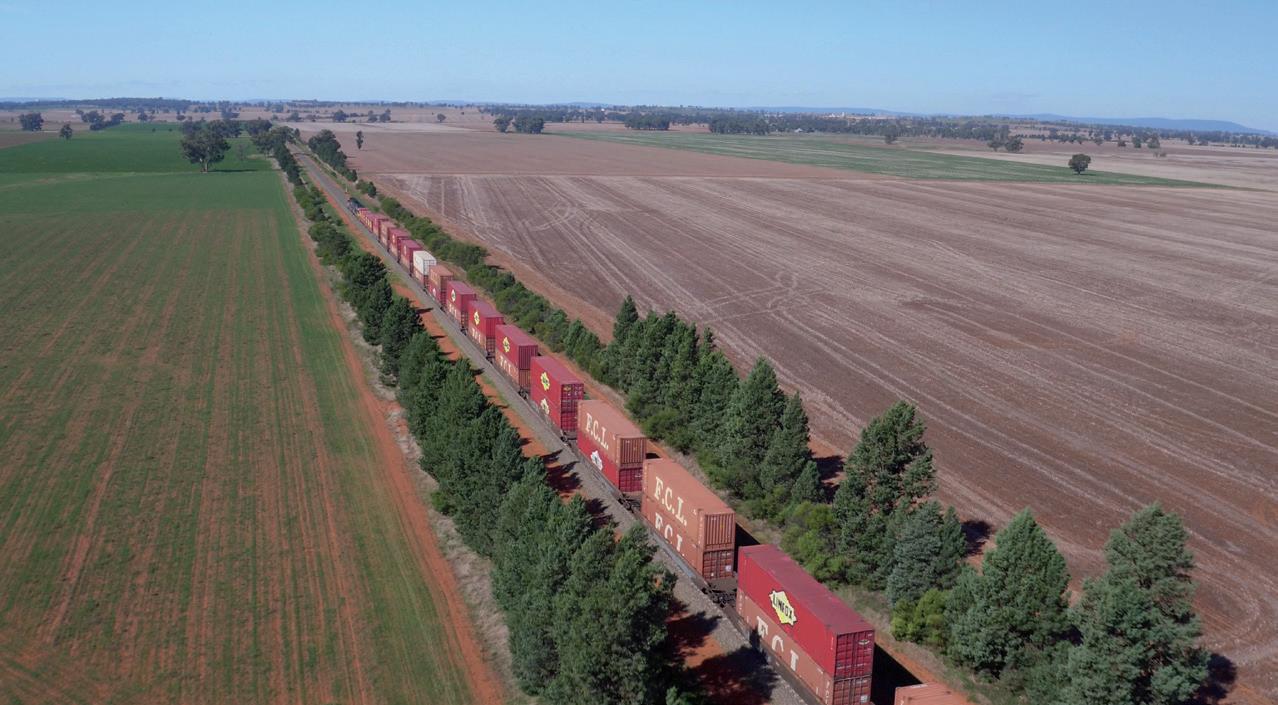
The Australasian Railway Association (ARA) and the Australian Logistics Council (ALC) invite you to register now for the 2018 Inland Rail Conference in Parkes NSW.
2018 is a year of delivery for Inland Rail with construction due to commence on the Parkes to Narromine section of the track, making this inaugural industry-led conference a must-attend event.
The Australasian Railway Association (ARA) and the Australian Logistics Council (ALC) invite you to register now for the 2018 Inland Rail Conference in Parkes NSW.
2018 is a year of delivery for Inland Rail with construction due to commence on the Parkes to Narromine section of the track, making this inaugural industry-led conference a must-attend event.
The two-day Conference will bring together key players involved in the Inland Rail project to discuss how this nationally significant infrastructure project will transform the movement of freight in Australia, what it means for the Australian freight industry and the benefits it will deliver for national freight customers.
The Conference will also consider how the Inland Rail Project can inform the development of the National Freight and Supply Chain Strategy, to be finalised in late 2018.
The two-day Conference will bring together key players involved in the Inland Rail project to discuss how this nationally significant infrastructure project will transform the movement of freight in Australia, what it means for the Australian freight industry and the benefits it will deliver for national freight customers.
For sponsorship opportunities please contact ARA at ara@ara.net.au.
For further information and to view the program visit www.austlogistics.com.au/InlandRail
The Conference will also consider how the Inland Rail Project can inform the development of the National Freight and Supply Chain Strategy, to be finalised in late 2018.
Sponsored by:
For sponsorship opportunities please contact ARA at ara@ara.net.au.
For further information and to view the program visit www.austlogistics.com.au/InlandRail
Sponsored by:
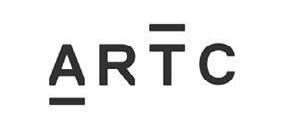
18 & 19 July 2018 Parkes, NSW
REGISTER NOW AT: www.austlogistics.com.au/InlandRail
July 2018 Parkes, NSW REGISTER NOW
www.austlogistics.com.au/InlandRail
18 & 19
AT:

PARKES – THE CENTRE OF AUSTRALIA'S TRANSPORT FUTURE
The Melbourne to Brisbane Inland Rail line will transform freight movement in Australia – and Parkes will be central to this opportunity.
Parkes is located in central New South Wales, and is uniquely positioned at the intersection of the East West rail line, the North South Newell Highway and soon, the new $10 billion Melbourne to Brisbane Inland Rail.
Parkes' central location will be a game changer in the way freight is moved around Australia. It is the only place along the new Inland Rail where it all comes together with major logistics, manufacturing, warehousing, agricultural valueadding and distribution opportunities now being offered.
Parkes is capitalising on its potential to become a major national transport node. Already, more than 80 per cent of Australia’s population can be reached in less than 12 hours from Parkes, creating a valuable competitive advantage for companies looking to develop logistics, distribution and manufacturing operations.
"The hub at Parkes has been in the planning for decades as Parkes is geographically located in the centre of NSW and at the epicentre of the national transport and logistics network. Inland Rail will be a catalyst to change freight movement in Australia,” Parkes Shire Council Mayor, Ken Keith, OAM, said.
“Parkes is at the centre of that change and represents a significant opportunity for business to take advantage of improvements in freight efficiency.”
The Federal Government committed $8.4 billion to the Inland Rail project in the 2017 Federal Budget and tasked the Australian Rail Track Corporation (ARTC) with delivering the project. The first stage of the Inland Rail will be the $300 million upgrade of the rail line between Parkes and Narromine, and the construction of the east-west link at Parkes.
"The announcement by the Federal Government to start construction on Inland Rail has led directly to investment in Parkes, with Pacific National in October 2017 committing an initial $35 million to commence development of the company’s Parkes Logistics Terminal, which is set to be one of the largest private sector investments in freight infrastructure in regional Australia,” Mayor Keith said.
Once fully operational, Pacific National’s Parkes Logistics Terminal will have the capacity to process approximately 450,000 cargo containers each year, including the ability to haul double-stacked containers from Parkes to Perth.
Pacific National’s initial $35 million investment includes $18 million to start developing the terminal site and $17 million to acquire ‘rolling stock’ such as freight wagons.
The Parkes National Logistics Hub, is one of the largest greenfield intermodal sites in NSW and a project of strategic importance to the freight industry.
Parkes Shire Council prides itself on proactively developing
June 2018 // ISSUE 7 www.infrastructuremagazine.com.au 64
RAIL
Inspection of the bridge upgrade works at Goonumbla Bridge

Parkes’ future in logistics. It is strengthening its transport infrastructure, lifting the region’s profile with new strategic marketing campaigns, and working to facilitate collaboration between transport companies and governments.
“Parkes Shire Council is a progressive and innovative organisation that embraces new ideas and has adopted a philosophy of continuous improvement. We are not experts in transport, logistics or manufacturing, but we are experts in collaboration, advocacy and facilitation. Our aim is to connect businesses with opportunity,” Mayor Keith said.
INNOVATION DRIVES PARKES NATIONAL LOGISTICS HUB
With NSW State Government approval, 516 hectares of land was rezoned by council on the western edge of town for the Parkes National Logistics Hub. Another 100 hectares has been reserved for future development.
The Hub has been designed to operate 24/7 as a multimodal transport facility with buffer zones, and has attracted leading logistics companies such as Linfox, Pacific National and SCT Logistics. Other transport, warehousing and manufacturing companies are showing strong interest in the Hub.
The terminal has been a real success for SCT Logistics and they are now in the process of planning for the development of a ‘Logistics City’ to form an integral component of the Parkes National Logistics Hub. With almost 300 hectares of prime land, SCT Logistics can offer a diverse range of investment opportunities for companies looking to leverage from Parkes’ key strategic advantages.
SCT Logistics CEO, Glenn Smith, said, “When the Inland Rail is completed one of the great aspects of Parkes will be the ability to receive trains from Brisbane, Sydney and Melbourne ports and even Adelaide ports – they are all overnight by rail (to Parkes). SCT sees great opportunities for importers, exporters and manufacturers, who have a requirement to move freight efficiently.
“SCT is able to operate the largest intermodal trains in Australia because of Parkes’ unique positioning on the east-west rail corridor and the double-stack capability of its containers.”
CENTRAL LOCATION IS KEY
Parkes National Logistics Hub is central to Australia's transport network, it is central to global markets and central to 80 per cent of the Australian population overnight.
In addition, it offers very competitive warehousing costs, at least 50 per cent lower than in the largest capital cities, which provides options for logistics companies to improve supply chain efficiencies.
Parkes Shire Council General Manager, Kent Boyd, said, “Transport companies can use Parkes as a consolidation point to reconfigure freight and maximise loads as trains cross the country.
“We’re encouraging logistics companies to think differently about Parkes. We intend to become an international bestpractice national transport node that provides a range of options for transport companies to move freight more efficiently and create new business opportunities.”
www.infrastructuremagazine.com.au June 2018 // ISSUE 7 65 RAIL
(L-R) ARTC Inland Rail CEO Richard Wankmuller, ARTC Chairman Warren Truss, ARTC Managing Director John Fullerton, Parkes Shire Mayor Cr Ken Keith OAM inspecting the progress on the bridge upgrade works at Goonumbla Bridge.
Parkes has several rail-freight advantages. It is the first point from Sydney where containers can be double-stacked on rail. B-Double access to Parkes is available on all major routes; road-train/B-Triple access is available from the west; and road-train linkages to the Hub from as far west as Adelaide have been identified.
“The Parkes National Logistics Hub can connect Australian farmers with international markets and create opportunities for companies to export value-added agriculture products and earn higher profit margins,” Mr Boyd said.
“Australian products are seen internationally as ‘clean and green’. We believe that Parkes will play an important role in the ‘food export boom' as we are situated in rich agricultural industry and boast a central location in a national freight network.”
PARKES’ STRONG FOUNDATIONS
Situated in NSW’s rich agricultural heartland, Parkes is ideally suited for the agricultural sector to value add, including processing facilities, centralised storage and distribution point for fertiliser, chemicals and fuel among other commodities and products.
The Parkes National Logistics Hub will offer cheaper, faster and more efficient modal choices, and outstanding employment and investment opportunities for:
♦ Logistics and transport operations
♦ Locomotive and truck industries
♦ National FMCG distributors
♦ Centralised storage and warehousing
♦ Manufacturing
Parkes’ highly skilled, competitive labour force is another asset. Wages are more affordable because Parkes’ median household income is about 30 per cent lower than the NSW median. Transport companies that set up in Parkes have a ready-made workforce and other workers who move there can access cheaper housing options.
Infrastructure upgrades are boosting the area. In addition to the Inland Rail, a bypass of the Newell Highway at Parkes is under investigation which will have direct links into the Hub. The Parkes Airport has had almost $5 million of investment with the runway upgraded and a new terminal. A Business Park subdivision has been approved, and planning for the airport is designed to integrate with the ongoing development of the Hub.
Parkes’ new $72 million hospital and $14 million Police Station add to the town’s infrastructure. Another $100 million is being spent on the construction of new water and sewage treatment plants, as well as an advanced water recycling facility and ring main. Parkes is also seeing millions of dollars being invested in solar farms and mining.
“We are on the verge of something big. The vision is huge, and the opportunity is absolutely immense. Parkes is where professional, creative and energetic people come together. Parkes offers multiple career and lifestyle advantages that all add up to support and grow your business,” Mayor Keith said.
RECENT PROJECT MILESTONES
Parkes Shire Council was recently invited to join Australian Rail Track Corporation (ARTC) Inland Rail CEO, Richard Wankmuller, the new ARTC Chairman, Warren Truss, and ARTC Managing Director, John Fullerton, to inspect the progress
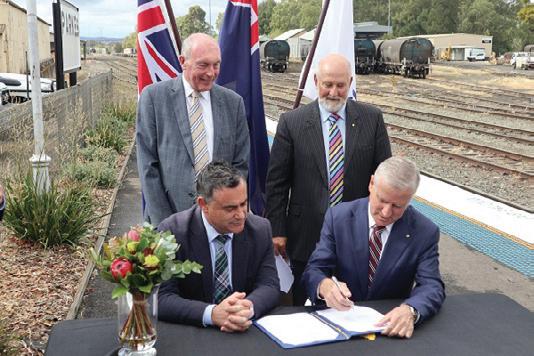
of work activities on the Goonumbla bridge upgrades, near Parkes. The $2 million investment by the ARTC to replace four timber top bridges along the existing rail network will support the delivery of the Inland Rail when construction begins on the Parkes to Narromine section mid-2018.
The bridges, which are nearing the end of their operational life, will be replaced with concrete bridges to bring them up to the Inland Rail’s engineering standards.
In May 2018, the Federal and New South Wales Governments came together in Parkes to sign a landmark Bilateral Agreement, making way for the commencement of works on the multi-billion dollar Inland Rail project in NSW.
Deputy Prime Minister and Minister for Infrastructure The Hon. Michael McCormack, and NSW Deputy Premier and Minister for Regional NSW, John Barilaro, signed the Intergovernmental Agreement – a landmark moment in the delivery of the project.
NSW is the second state to sign up to the nationallysignificant project. The new agreement provides consent for the Australian Rail Track Corporation (ARTC) to deliver Inland Rail in NSW.
Following on from the monumental announcement, the ARTC commenced the next phase of industry engagement with three city-based briefing sessions held in Brisbane, Melbourne and Sydney. The sessions were live streamed to enable regional stakeholders to tune in and be part of the process.
“We are well positioned to benefit from the economic and supply chain development associated with the project, and these sessions detail the opportunities for local industry to be involved in the delivery of the Inland Rail and understand the industry requirements,” Mayor Keith said.
“A report by Regional Development Central West found that around 490 new jobs could be created in our region alone during the construction phase, and we want our local businesses to be ready to take advantage of these opportunities when the time comes.”
June 2018 // ISSUE 7 www.infrastructuremagazine.com.au 66 RAIL
NSW Deputy Premier and Minister for Regional NSW John Barilaro and Deputy Prime Minister and Minister for Infrastructure Michael McCormack sign the Bilateral Agreement at the Parkes Railway Station, as Mayor Ken Keith OAM and ARTC Chairman Warren Truss watch on.
For more information, please visit www.parkes.nsw.gov.au.
LEVEL CROSSING SYSTEMS FOR THE HIGHEST DEMANDS
Phoenix AG has been servicing and installing STRAIL level crossing systems for over 15 years within Australia and New Zealand. STRAIL systems have been installed in the Pilbara, Western Australia, and inland across New South Wales, South Australia, Northern Territory and Victoria, and offer a fast, safe and reliable connection between streets and rails.
KRAIBURG STRAIL (street meets rail) level crossing systems are made from vulcanised rubber compounds. Each system conforms to the highest standards but is always individually composed and customised since every level crossing is different.
From pedestrian crossings to heavy duty traffic, STRAIL systems are as diverse as your requirements and provide the ideal level crossing solution.
All STRAIL systems can be combined and, thanks to the patented lock tight design which prevents the creation of gaps and ensures position stability in case of diagonal traffic, all panel types can be connected to each other.
DIFFERENT SYSTEMS FOR DIFFERENT REQUIREMENTS
STRAIL is suited to the most common usage profiles. It can withstand heavy loads for long periods of time and is quick and easy to install.
The premium version of STRAIL can be chosen for crossings with a high traffic volume and a greater variety of vehicles. It features compact panel units (600 or 1,200mm inner panels

and 1,200mm outer panels) and cost-efficient full track maintenance for major traffic routes.
veloSTRAIL was designed with a special emphasis on accessibility. An interchangeable part, which can be easily replaced without removing the inner panels, closes the flange groove and provides safe crossing for wheelchair users, cyclists and prams.
veloSTRAIL inner panels are available in 600mm and 1,200mm and are designed for train speeds up to 120km/h.
Phoenix has also developed pedeSTRAIL especially for pedestrian crossings, stations, stops, depots and industrial plants. Due to the caverns on the underside of the 900mm panels, they are light and easy to handle despite their size and can be used irrespective of sleeper spacing.
pedeSTRAIL features easy installation and removal, low installation costs and a particularly long service life. It can also be accessed by rescue vehicles in emergencies.

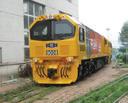
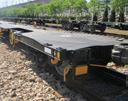
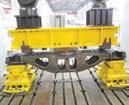

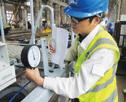

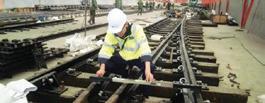
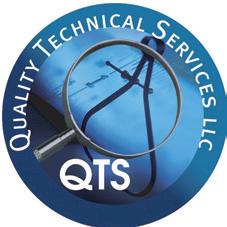
Quality Verification of Railway Locomotives, Wagons, Steel Rails & Track Turn-Outs
• Pre-award audits of manufacturers, subcontractors and suppliers
• Experienced and qualified inspectors
• Verification of manufacturing and testing in accordance with AS standards
• Surveillance inspections throughout the entire manufacturing process
• Individual inspection of completed equipment
• Pre-delivery and ship loading inspections
Quality Technical Services LLC
Shanghai Operations Office
Contact: Frederick Ford Mobile: +86-13501790361 www.qtsinspect.com
www.infrastructuremagazine.com.au June 2018 // ISSUE 7
67 RAIL // PARTNER SOLUTIONS
www.strail.de
For more information, please visit
NATIONAL RAILWAYS BENEFIT FROM INNOVATIVE TECHNOLOGY
With over 100 years of experience in providing complex rail maintenance and construction solutions, Rhomberg Rail Australia — the Australian operating division of the Austrianbased Rhomberg Sersa Rail Group — is an industry specialist. However, it is its reputation as a pioneer and driving force in the development of new processes and systems that has positioned Rhomberg at the forefront of the rail sector.
With core competencies in design, technical advisory and project delivery of rail systems, track construction and maintenance activities, Rhomberg Rail is able to provide tailor-made and cost efficient solutions that focus on high performance and safe delivery.
It has dedicated track construction crews capable of delivering all works associated with new rail infrastructure construction and renewal, as well as multiple crews trained and resourced to carry out periodic maintenance works including continuous welded rail (CWR), track adjustment and welding.
Rhomberg Rail has extensive experience in the construction and repair of rail bridges and structures including replacing transoms, culverts and associated works, with fully qualified demolition supervisors.
During the last decade, Rhomberg Rail has worked extensively with regional rail owners and operators to provide needsbased service delivery on a significant cross section of multi discipline urban
and large-scale national projects.
Driven by its desire to establish a culture of continuous improvement within the rail industry, the company is always finding new ways to optimise its output, while developing new products that are progressive and forward thinking.
Many of these innovations have now become the standard in track renewal and maintenance, and have been employed in projects across Australia, such as the recent Branxton Weighbridge upgrade which was completed in November 2017.
UPGRADING THE BRANXTON WEIGHBRIDGE
The new Branxton Weighbridge, located in the NSW Hunter Valley, incorporates prefabricated slab track and transition modules in a first-of-its-kind in Australia.
Combining these technologies provided an innovative solution to the common issue of excessive track vibration leading to inaccurate data readings.

The Australia Rail Track Corporation (ARTC) wanted to upgrade the existing weighbridge system to include a highspeed weighbridge capable of capturing data from trains running at 60kph.
A ballasted track system was determined to be unsuitable due to the excessive settlement and top issues that occur over time causing the coal wagons to bounce and sway, resulting in inaccurate weighbridge data readings.
Rhomberg Rail Australia was engaged to provide its proprietary IVES and VTRAS system to solve this problem.
IVES (Intelligent, Versatile, Efficient, Solid) is a precast slab track system that can be used for almost any type of permanent way (standard gauge, rapid transit, low or high-speed railway).
The simple design of the prefabricated concrete units, in particular their shape and precise dimensions, allows each component to be specifically adjusted to suit any track configuration and modifications can be made quickly and easily.
The Versatile Transition System (V-TRAS) universal transition module
June 2018 // ISSUE 7 www.infrastructuremagazine.com.au 68
RAIL // PARTNER SOLUTIONS
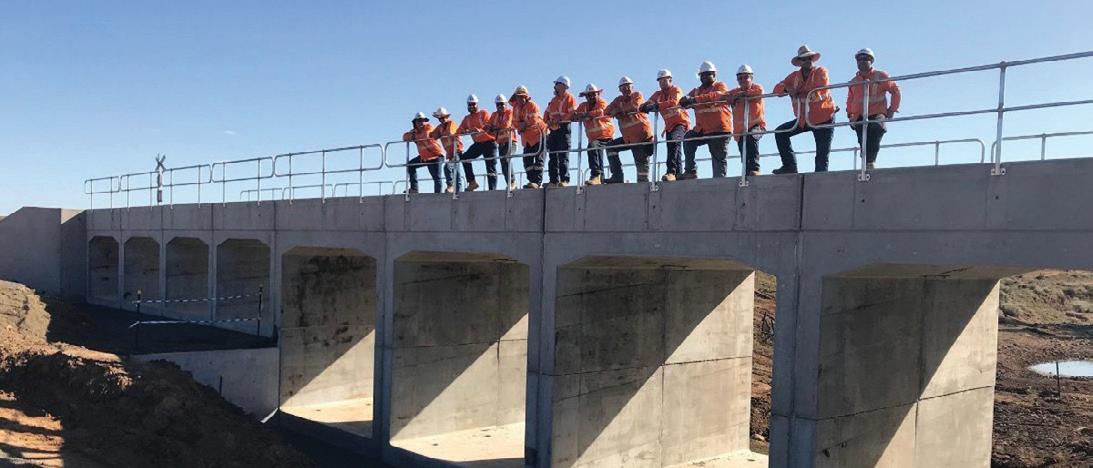

is a prefabricated, robust, ladder-form steel structure that connects different track construction types.
It can be used largely irrespective of whatever types of track construction are involved and is available at different lengths to suit specific project needs.
One side sits on the end of the slab track, while the rest of the module is placed in the ballast roadbed, which provides it with a floating support.
It enables a smooth transition from the flexible ballasted track system to the solid IVES track system which, in the case of the Branxton Weighbridge, ensures a smooth transition and accurate data readings at high speed.
The IVES and VTRAS systems were installed over three consecutive possessions, with work completed seven hours ahead of the final possession deadline.
A TRUSTED INDUSTRY PARTNER
Rhomberg Rail has helped build some of the biggest and most complex rail projects in Australia and overseas, developing a reputation as an innovator

that can get the job done on time and on budget.
While the Branxton Weighbridge is one of its most recent projects, Rhomberg Rail has worked extensively with the ARTC on a number of projects.
Between August 2009 and October 2012, Rhomberg Rail provided major periodic maintenance and construction services for general track work in the Hunter Valley, working across 700km of plain track and 610 turnouts. The works were undertaken during scheduled major track closedowns and aligned maintenance possessions.
Rhomberg Rail was responsible for the project management, safety management, quality assurance and programming. The company also provided experienced supervision, skilled labour, safeworking protection, and plant and equipment.
Rhomberg Rail was also engaged to provide design, installation and resurfacing services to work on the existing track infrastructure on the Main North Line within the Upper Hunter Valley, known as the Upper Hunter
- Gunnedah Basin.
The main aim of this upgrade was to renew the turnouts to enable enhancement of the track capacity in preparation for the running of 30 tonne axle loads.
Rhomberg Rail replaced 25 turnouts, and carried out all associated preparation and track work reconfigurations.
Rhomberg Rail provides for the lifecycle of today’s rail networks through a complete range of innovative, mechanised rail construction and maintenance process solutions.
It has a team of highly-experienced local rail professionals, and aims to encourage and drive a culture of service excellence and develop best practice relationships with its clients.
Rhomberg Rail provides the best of European innovation with local knowhow and Australian knowledge.
www.infrastructuremagazine.com.au June 2018 // ISSUE 7 69
For more information, please visit www.rhombergrail.com.au RAIL // PARTNER SOLUTIONS
Rhombergs team on the Elong Elong bridge upgrade
Upgrades at Goonumbla
FULL STEAM AHEAD FOR SYDNEY’S METRO MILESTONES
As Sydney Metro - Australia’s biggest public transport project - prepares for new rail services to start in the city’s booming north west next year, the next stage of delivering metro rail through Sydney’s central business district is now ramping up. With major construction activity now underway in the heart of the nation’s biggest – and busiest – city, the project team has implemented a number of technologies and measures to mitigate the impact of noise and vibration on the community.
CONSTRUCTING DEEP
BENEATH THE CITY
Demolition work is well underway at the new city metro station sites ahead of tunnelling starting, with the first of five mega tunnel boring machines to be in the ground before the end of this year.
The CBD stations at Barangaroo, Martin Place and Pitt Street will transform how people get around Sydney.
Delivering new underground railway stations in the middle of a busy city presents its own challenges, with innovative techniques used to minimise impacts on key stakeholders from issues like noise and vibration.
The delivery of this 21st century railway has been likened to keyhole surgery, where builders will excavate stations in relatively confined sites and deliver most of the project deep beneath the city; a century ago, the City Circle was built more like open heart surgery where entire streets were excavated for the cut and cover tunnels which have served Sydney for almost 100 years.
CLEARING SPACE ABOVE GROUND
Bringing down tall buildings in a busy city has been a complex task, with the
latest equipment brought in to minimise the impact on surrounding businesses, workers and residents as much as possible.
State-of-the-art pulverisers and concrete shears attached to excavators have been grinding away buildings, with these jaw-like devices significantly cutting the noise levels generated by traditional hydraulic hammering.
At the Pitt Street station northern entry site, the first major CBD demolition work has finished.
Eight buildings were removed, the highest 14 storeys.
Over seven months, crews gradually brought down buildings on Castlereagh, Park and Pitt streets floor by floor, with excavators craned as high as 51m to carry out demolition from the top down.
During demolition, 21,000 tonnes of concrete, 5500 tonnes of bricks and 570 tonnes of steel were all recycled.
REDUCING NOISE
WITH ACOUSTIC SHEDS
Excavation is now taking place up to 20m below the surface with an acoustic shed minimising the impacts of construction noise on surrounding businesses and residents.
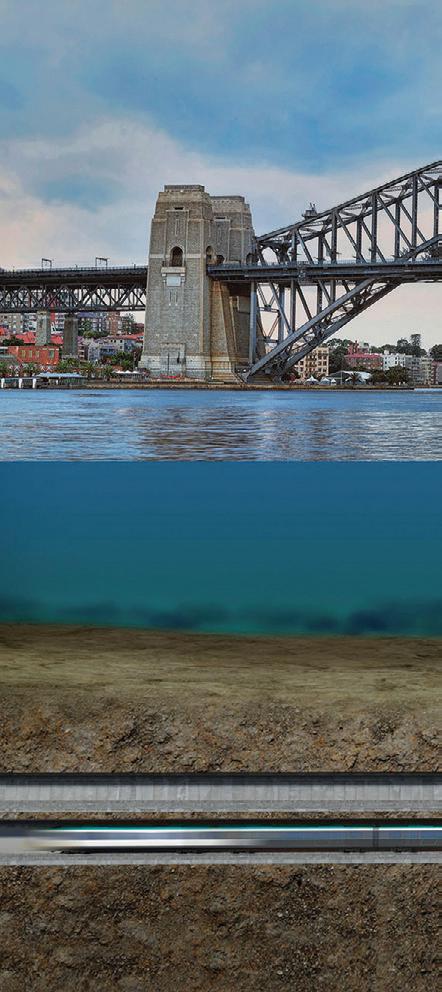
Once the sites are ready, the tunnel boring machines (TBMs) will come through as the twin 15.5km railway tunnels are built between Sydenham and Chatswood, including deep under Sydney Harbour.
The planning approval for the tunnels sets out strict conditions to minimise construction noise and vibration including acoustic sheds and noise barriers that are being installed at all tunnel construction sites.
Generally, people directly above the TBMs will feel slight vibration for a few days while tunnelling takes place below them with the Sydney Metro machines expected to tunnel an average of 120m a week.
Five mega borers will be used – the most ever used at once on an Australian transport infrastructure project –including a specialised TBM for under Sydney Harbour.
This machine will tunnel up to 42m below the harbour surface from Barangaroo, digging for about one kilometre to Blues Point. There, the

70 NOISE AND VIBRATION

TBM will be retrieved and taken back to Barangaroo before being relaunched to build the second tunnel.
Following community feedback during the planning process, barges will be used to remove crushed rock and machinery from Sydney Metro construction sites at Blues Point and Barangaroo, reducing the impact on the community.
The facility means more than 20,000 truck movements will be taken off busy inner-Sydney roads around Barangaroo and North Sydney.
A temporary barging facility has been approved next to the Parramatta River at Clyde and will be operated for about two years in the existing industrial area by tunnel builders John Holland CPB Ghella.
Crushed rock will be transferred to trucks at the facility, and transported to other residential and commercial development projects across wider Sydney, with 100 per cent of excavated material from the tunnels to be reused.
During tunnelling for the Sydney Metro tunnels in the city’s north west,

all crushed rock was recycled back into commercial and residential projects in Greater Western Sydney like an environmental initiative at Prospect Reservoir and the construction of Bunnings Warehouse at Blacktown.
Safety is Sydney Metro’s number one priority, with Transport for NSW launching a new safety campaign for the greater Sydney metropolitan area given the increased amount of construction activity.
The Be Truck Aware campaign encourages pedestrians to take extra care around trucks and to avoid the distraction of mobile devices when crossing the road.
A CITY-SHAPING PROJECT
A $20 billion-plus program of many firsts, Sydney Metro will be Australia’s first fully-automated railway and will deliver technology like platform screen doors to Australia for the first time.
This new generation railway will have the capacity to move more than 40,000 people an hour, almost twice as many as
an existing suburban railway line.
Services start in the first half of 2019 with a train every four minutes at peak times in the city’s north west on the $8.3 billion Sydney Metro Northwest line; eight new metro stations, five existing stations upgraded to metro standards and 4000 new commuter car spaces.
New metro rail will extend from the north west into the CBD and beyond in 2024, when Sydney will have 31 metro stations and a 66km new standalone railway system.
As well, the city-shaping Sydney Metro West line is in the early planning stages and will deliver a new underground link between the Sydney and Parramatta city centres in the second half of the 2020s, doubling rail capacity between these two key regions.
With an ultimate capacity of a train every two minutes in each direction under the city centre, Sydney Metro is the biggest urban rail infrastructure investment in Australian history.
71 NOISE AND VIBRATION
Photo credit: Sydney Metro
THINKING DOMESTICALLY AT OUR PORTS
 by Mike Gallacher, Chief Executive Officer, Ports Australia
by Mike Gallacher, Chief Executive Officer, Ports Australia
June 2018 // ISSUE 7 www.infrastructuremagazine.com.au 72 PORTS

www.infrastructuremagazine.com.au June 2018 // ISSUE 7 73 PORTS

When people look at ports they think international trade, and they wouldn’t be wrong as 98 per cent of everything we bring in and out of this country goes through our ports. But what is missing from this vision is domestic sea freight or coastal shipping — moving goods around our country via the blue highway.
My view and the view of our membership is a simple one, we can improve the efficiency of our country by balancing its supply chain. That means we need to take advantage of our coastal waterways to move freight around the country, which in turn will create regional job opportunities by diversification at these regional centres.
This is not a fight between the modes of transport, it is about being smart, it is about understanding the strengths of each mode and using them appropriately to meet the incoming freight tsunami and tame the geographical vastness that is Australia.
The volume of freight going in and out of the country is going to be the same whether we have coastal shipping or not. However, using the blue highway to its potential brings so many benefits to Australians.
That balance is combining the flexibility of our roads, the connectivity of our railways and the capacity of our ports.
UTILISING THE BLUE HIGHWAY
Governments around the nation are investing billions into road and rail to relieve congestion, improve road safety outcomes, connect inland regional communities directly with capital cities to improve quality of life, freight efficiencies and invest in the nation’s economic growth. The Commonwealth alone is investing $75 billion in the next 10 years, with funding dedicated to road, rail and airports.
The blue highway doesn’t need to be built, expanded or maintained. It is free and it already connects all our major cities and many of our regional centres.
Analysis conducted for the Inquiry into the National Freight and Supply Chain Priorities suggests that while the freight task is projected to double in the next 20 years, even with extra investment, Australian transport infrastructure will be hard pressed to meet this demand without including the ports. Furthermore, the NSW Government estimates that a one per cent increase in freight efficiency could save the national economy $1.5 billion.
This country will continue to grow whether we are prepared or not. State and federal governments are taking steps to understand and lead this growth. My question to them is how can we use the over 70 ports strategically located right around our country to their full potential to the benefit of the country?
The blue highway doesn’t need to be built, expanded or maintained. It is free and it already connects all our major cities and many of our regional centres.
THE ROLE OF PORTS IN DOMESTIC SHIPPING
Which is why Ports Australia has commissioned Deloitte Access Economics to help us understand exactly the role our ports can play in the domestic shipping mix.
There is a freight tsunami heading our way and this country is not yet ready to meet it. Australia has the highest growth rate of any major OECD country growing at a steady 1.6 per cent per annum with our population expanding from 24 million to 30 million. Our capital cities are home to 69.3 per cent of the entire population this number will increase to almost 75 per cent in the next 40 years.
As this population rises so does demand. We know through the government’s National Freight and Supply Chain Priorities Discussion Paper that the total road freight task in all capital cities is forecast to increase by 2.33 per cent per annum, from 40 billion tonne kilometres back in 2008 to 66.60 billion tonne kilometres within the next 12 years.
To put that into perspective, Australia’s shipping container freight movements are expected to grow by 165 per cent over the same period. Non-containerised freight is projected to grow by 138 per cent over the same period.
Most of the containerised freight will be delivered to one of four capital city ports: Melbourne, Port Botany, Brisbane or Fremantle, with Sydney and Melbourne accounting for around 70 per cent of containerised freight.
In 2016, our domestic freight task totalled 738 billion tonne kilometres — 15 per cent of this was moved by sea freight, rail 56 per cent and road 29 per cent. And of those figures, coastal shipping contribution to the domestic freight task has grown over the last 25 years by just one per cent — rail has grown by 210 per cent and road 61 per cent.
OPPORTUNITY FOR WIDER REFORM
Ports are the gateway for over 98 per cent of Australia's imports and exports, yet no strategic focus or funding is allocated towards improving the maritime network of this country to facilitate further economic growth and ensure the sustainability of our cities and regional centres.
Clearly, the impact of the nation’s increased freight task will hamper the long-term benefit of infrastructure investment if we, as a nation fail to think of alternate ways to move freight and increase the longevity of government sector investment.
There is currently a bill in the Senate intended to address some of the challenges in the current legislation. Whilst Ports Australia welcomes these minor adjustments to the current regime, we believe there is an opportunity for wider reform.
It is my firm belief that embracing the use of our nation’s coastal sea routes, the blue highway, we can deliver sustainability of existing cities, grow existing regional towns and cities, while saving billions in the process.
June 2018 // ISSUE 7 www.infrastructuremagazine.com.au 74 PORTS
Mike Gallacher, Chief Executive Officer, Ports Australia


WHAT WILL THE FUTURE OF FREIGHT, LOGISTICS & TRADE LOOK LIKE?
Ports Australia’s Biennial Conference will explore opportunities and challenges impacting the Port sector-Australia’s gateways to the world.
JOIN US IN DARWIN FOR TWO DAYS OF WORLD-CLASS TALKS AND EVENTS, WITH SPREAKERS INCLUDING:
- THE HON MICHAEL McCORMACK MPDeputy Prime Minister & Minister for Infrastructure
- THE HON ANTHONY ALBANESE MPShadow Minister for Infrastructure, Transport, Cities & Regional Development
- DAVID MCLEANCommander, Australian Federal Police
- ADAM HANDLEYSenior Partner MinterEllison
As well as talks from Australian Border Force, Deloitte Access Economics, DFAT, Port of Darwin, Pilbara Ports Authority, Port of Brisbane, Port of Newcastle and plenty more.
PORTSAUSTRALIA.COM.AU SPACES ARE STRICTLY LIMITED! REGISTER NOW AT
OVERCOMING AIRPORT UNDERPASS ENGINEERING CHALLENGES
By Chris Frame

Brisbane Airport has been in the midst of a dramatic transformation for the past six years. Its new runway system, on schedule to open in 2020, will enable the airport to maintain its position as the leading aviation hub for Queensland.
76 AIRPORT
When finished, a new western airfield with a 3.3km long runway and up to 12kms of taxiways will open, doubling the airport’s capacity.
At the core of the project is the vision to grow Brisbane and Queensland’s connectivity to Australia and ultimately the world, providing capacity to allow new flights to new destinations. The project creates an immeasurable number of opportunities

now and into the future through commerce, tourism and jobs.
Delivering such a vision on time and on budget requires teamwork, planning and a synergy of vision that is not easy to cultivate. But Brisbane Airport’s approach of forward planning, combined with an inclusive corporate culture, has allowed this project to meet or exceed each of its delivery milestones.
77 AIRPORT

“The aim is to be operational by September 2020 and we’re tracking a few months ahead of that, so while there’s a long way to go it’s good to know we are in a very good position with the project,” said Paul Coughlan, Brisbane Airport Corporation’s New Runway Project Director.
CROSSING THE ROAD
A key aspect of the project is the Dryandra Road underpass. Dryandra Road has been the only access to the northern part of the airport since it opened in 1988.
This important link connects critical aeromedical services from the Royal Flying Doctor with Brisbane’s motorway network. It also provides public access to Brisbane’s growing general aviation facilities.
However, Dryandra Road presented designers with an engineering challenge. The existing road ran through the planned link taxiways, which will connect the new runway with the existing taxiway system.
“Without an engineering solution to maintain Dryandra Road connectivity, you would literally have to shut down the northern aprons,” Mr Coughlan said.
“Our challenge was to find a costeffective way to ensure access was available throughout the airport for the future, but just as importantly, during construction.”
Rising to the challenge, the team at Brisbane Airport Corporation (BAC) examined a variety of solutions. Settling on an underpass, the design meets the connectivity needs for vehicular traffic,
while providing optimal operational efficiencies for aircraft passing overhead.
“We elected to go with an underpass design because we couldn’t take the taxiways up and over a ground-level road; the incline was just too great for aircraft to manage,” Mr Coughlan said.
“Dryandra Road links the airport to its northern facilities, so it could not be closed off until the new underground road was operational. Diversion works to construct and realign a new road were scheduled to be complete ahead of the runway and airfield works so that access to the north could be maintained during construction of the link taxiways.”
While to the untrained eye, the underpass resembles a tunnel, it is in fact a road under/taxiway over engineering structure that supports four bridges. Two are vehicular road bridges while the other two are large taxiway bridges, capable of accommodating the world’s largest existing aircraft, the A380, as well as any future heavier aircraft up to 710 tonnes.
The works also see the diversion of essential new utilities within the underpass alignment including water, sewage, power, telecommunications and fibre optics; the first such upgrade in 30 years in this area.
THINKING AHEAD
Building the underpass presented the BAC team with a number of challenges. The mangrove region where the airport is located is notorious for its soft soil conditions which presented engineering challenges throughout the New Runway Project.
Such challenges have included an engineered solution to expedite ground settlement during the land reclamation phase. Over 330,000 wick drains were installed across the new runway precinct, making it the largest wick drain project in Australia.
However, while the new runway sits on reclaimed land, the floor of the Dryandra Road underpass is situated below ground, at four and a half metres below mean sea level. The waterlogged soil effectively pushes up on the underpass structure, requiring a dewatering system to keep the site dry during the construction phase.
Ant Halapua is BAC’s Delivery Manager for the Dryandra Road works and his long-term involvement in the project has allowed him to develop a simple and effective analogy to explain the water issue.
“Essentially we are building a ship-like structure, so think of the ground and groundwater as your water which is pushing the whole ship up. There are a number of piles that will anchor it down to bedrock once the structure is commissioned, but while we are building this structure, for access, the contractor is using big pumps and pipes to keep the water under control — like a dry dock,”
Mr Halapua said.
It fell to lead contractor McConnell Dowell to create a system to keep the water at bay.
“To reduce the size of the footprint, which helps reduce the scale of the dewatering required, the contractor opted to use a sheet piling system which made a big difference,” Mr Halapua said.
June 2018 // ISSUE 7 www.infrastructuremagazine.com.au 78 AIRPORT
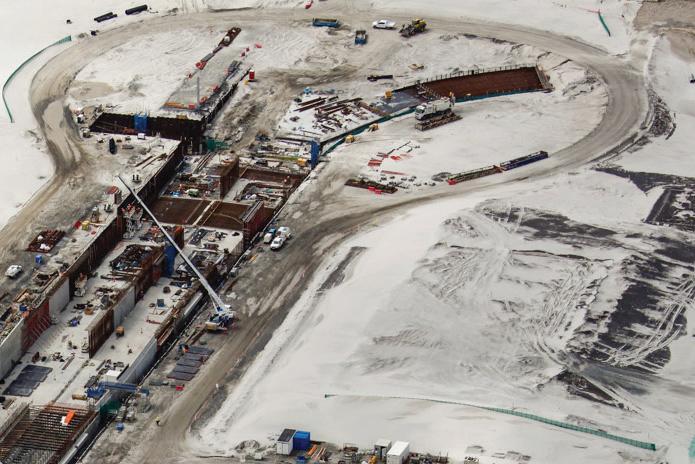
“The sheet piling system gave them better access to the work front and a framework to establish their dewatering system around. To ensure the system would work, they ran a series of deep bores down the centreline of the alignment to manage the water around their worksite.”
THE POWER OF PLANNING
Exhaustive pre planning has been the hallmark of the New Runway Project. BAC prioritised the front end development work, driving the project’s success to date.
Forward planning and exhaustive testing allowed BAC to create a robust tender document, aiding contractors to innovate and overcome challenges well before they become problematic.
This included a detailed ground survey period where BAC thoroughly mapped ground conditions, supporting the selection of construction materials and construction methodology.
Furthermore, BAC’s vision for the airport has driven many decisions throughout the project which has led to the underpass being future-proofed from the start.
“We could have designed the underpass to hold the weight of an A380, but we took it further than that. We looked at detailed analysis of aircraft design evolution to future-proof the underpass design,” Mr Coughlan said.
The analysis reviewed the growth of existing airliners over time, such as the size and weight difference between a 747-100 and 747-8I. This analysis suggested a possible future A380 variant
could be around 20 per cent heavier than the current model.
“As a result, the underpass and taxiway bridges can handle a greater weight than today’s A380 to enable the airport flexibility well into the future.”
SAFETY FIRST
Safety is the number one requirement across BAC’s New Runway Project, and the Dryandra Road underpass is no exception.
Being below the water table and near an operational airfield, it presents a unique challenge. The need for efficiency is balanced with managing FOD (Foreign Object Debris), crane height restrictions and vehicular access near an active runway system.
“All of our contractors have to provide us with a method of work plan. Each of these plans needs to identify safety aspects. It is looking at every construction element and process, and identifying what could go wrong and then create procedures to ensure that doesn’t occur,” Mr Coughlan said.
Coughlan believes that safety starts in design, commenting that “a safe design is only as good as its constructability”. As such, BAC designed an underpass that could be built safely, ensuring that the design did not add unnecessary safety risks to the project.
“We did a lot of risk assessment and analysis at that early stage. We didn’t rush the front end. We didn’t cut costs in the geo-tech and we didn’t rely on assumptions. We did the investigation that was needed,” Mr Coughlan said.
In addition, BAC requires
documentation from each of their contractors to demonstrate their safety record, as well as how they will address safety requirements at the airfield.
This approach, in addition to the airport’s preference to work with mature contractors with a proven safety record, has seen the New Runway Project and Dryandra Road underpass progress with minimal safety concerns.
FUTURE OUTLOOK
As opening day in 2020 comes closer into view, BAC’s meticulous planning and design means the project is not only ahead of schedule but also on budget.
The new runway and its associated taxiways will transform Brisbane Airport’s capacity, further connecting Queensland’s ever-growing population to the regions, the nation and the world.
At the heart of the project, the Dryandra Road underpass will become a permanent fixture; linking the essential northern precinct with the rest of the airfield. The underpass’ success will be measured not in its noticeability, but in its hidden efficacy.
“When people are driving through the underpass, they won’t realise that they are driving under sea level or the engineering that went into making this a reality,” Mr Coughlan said.
And that’s the way it should be; a seamless design, providing its function almost unnoticed. But one thing is for sure; Dryandra Road has left a lasting impression on the team involved in its construction as well as Brisbane Airport’s ability to connect Queensland – and Australia – with the world.
www.infrastructuremagazine.com.au June 2018 // ISSUE 7 79 AIRPORT
FEATURES SCHEDULE
September 2018 Deadline: 27 July 2018
Tunnels When infrastructure intersects
Ports Energy infrastructure
Concrete Cranes & heavy lifting
Culverts Safety and risk management
Freight and logistics Intelligent Transport Systems (ITS)
INTELLIGENT TRANSPORT SYSTEMS (ITS) SUMMIT PORTS AUSTRALIA
INFRAPEOPLE
DISTRIBUTION
March 2019
AUSTRALIAN TUNNELLING CONFERENCE
ASSET MANAGEMENT FOR CRITICAL INFRASTRUCTURE
Deadline: TBA
Bridges Signalling, tracking and control systems
Rail Condition monitoring and maintenance
Urban transport corridors Software, communications and connectivity
Spatial & GIS Building and construction
Public private partnerships Road Surfacing and design
DISTRIBUTION
ADVERTISERS’ INDEX
November 2018 Deadline: 5 October 2018
AusRail IoT & cloud communication
Airports Construction standards and codes
Land access Asset management
Security and critical infrastructure
Landscaping and vegetation management
DISTRIBUTION
June 2019
AUSRAIL AUSTRALIAN AIRPORTS ASSOCIATION CONFERENCE CORROSION AND PREVENTION
Deadline: TBA
Sustainability InfraPeople: Skills & training
Mobility Smart infrastructure VicRoads Earthmoving outlook
Noise and vibration Investment & financing
Asset inspection & drones/UAVS
DISTRIBUTION TBA
80 June 2018 // ISSUE 7 www.infrastructuremagazine.com.au
TBA
AusRail IBC Australasian Structural Engineering Conference...........3 Centre for Pavement Engineering Education...............40 Fraenkische 13 Inland Rail Conference..........................................................63 Insitu Pacific 41 Intelligent Transport Systems 35 Oceania Damage Prevention Conference (ODPC)........39 Phoenix AG 67 Ports Australia 75 Position Partners OBC Quality Technical Services....................................................67 Rhomberg Rail Australia 68–69 Simoco Wireless Solutions 11 Smart Infrastructure Summit 23 Smart Mobility Show 53 Taylors 43 Vacuworx Australia 9 Vermeer IFC–1
Rail – For a Better Future
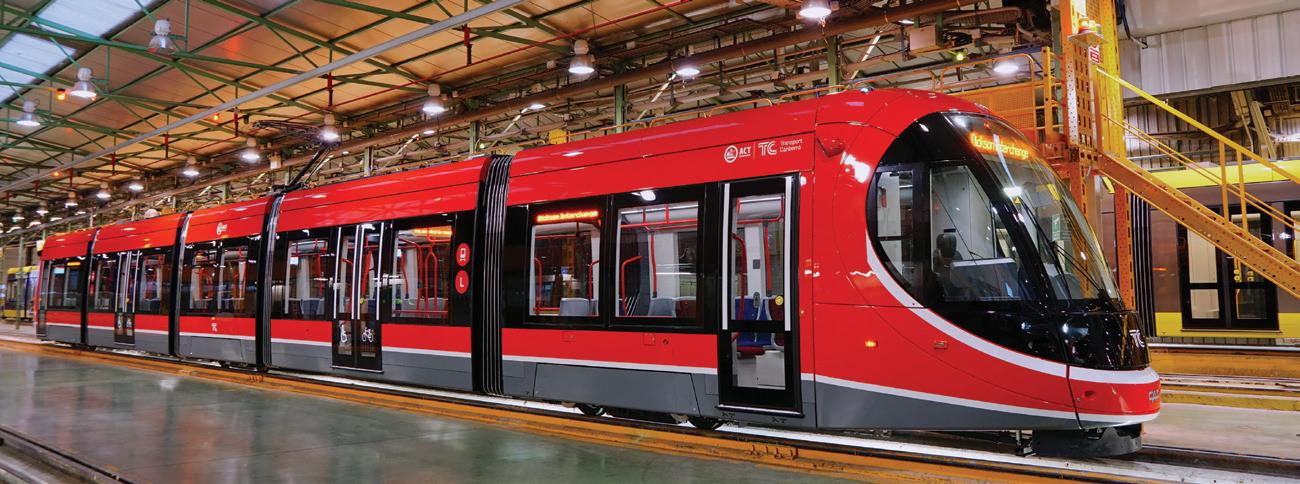
THE LARGEST RAIL EVENT IN AUSTRALASIA RETURNS TO THE NATION’S CAPITAL
WHAT TO EXPECT BESIDES TWO DAYS OF HIGHLY BENEFICIAL ENGAGEMENT WITH YOUR PEERS AND SUPPLIERS....
• 700+ senior rail sector, government and academic leaders participating in the conference
• Plenary and technical streams across 2 days
• 120+ exhibitors from a diverse range of rail organisations
• Social events for you to make the most of your networking (Welcome Reception, Networking Drinks and Gala Dinner)
• NEW FOR 2018 – Networking breakfast session for sponsors and exhibition stand staff
ARE YOU AN ARA MEMBER?
ARA Members receive a 20% discount on conference attendance, sponsorships, exhibitions and Event Guide advertising.
YOUNG RAIL PROFESSIONALS – AUSRAIL SHINES A SPOTLIGHT ON TOMORROW’S LEADERS
• Young Rail Professionals Pitching Competition – Entries NOW OPEN!
• Next Generation Scholarship
• NEW FOR 2018 – Mentor rate discount available for those 30 years and under (conditions apply)
• Visit www.ausrail.com for full information.
To sponsor a function, innovative package, exhibit, advertise within the Official Event Guide and much, much more, email: Deborah.Bocock@informa.com.au
PREMIUM
LANYARD
EXHIBITION NETWORKING DRINKS
PREMIUM PLATINUM & GALA DINNER SPONSOR
GOLD & HERO IMAGE SPONSOR
SPONSOR
SPONSOR
Photo courtesy of CAF
Comprehensive Optical Monitoring Solution
With
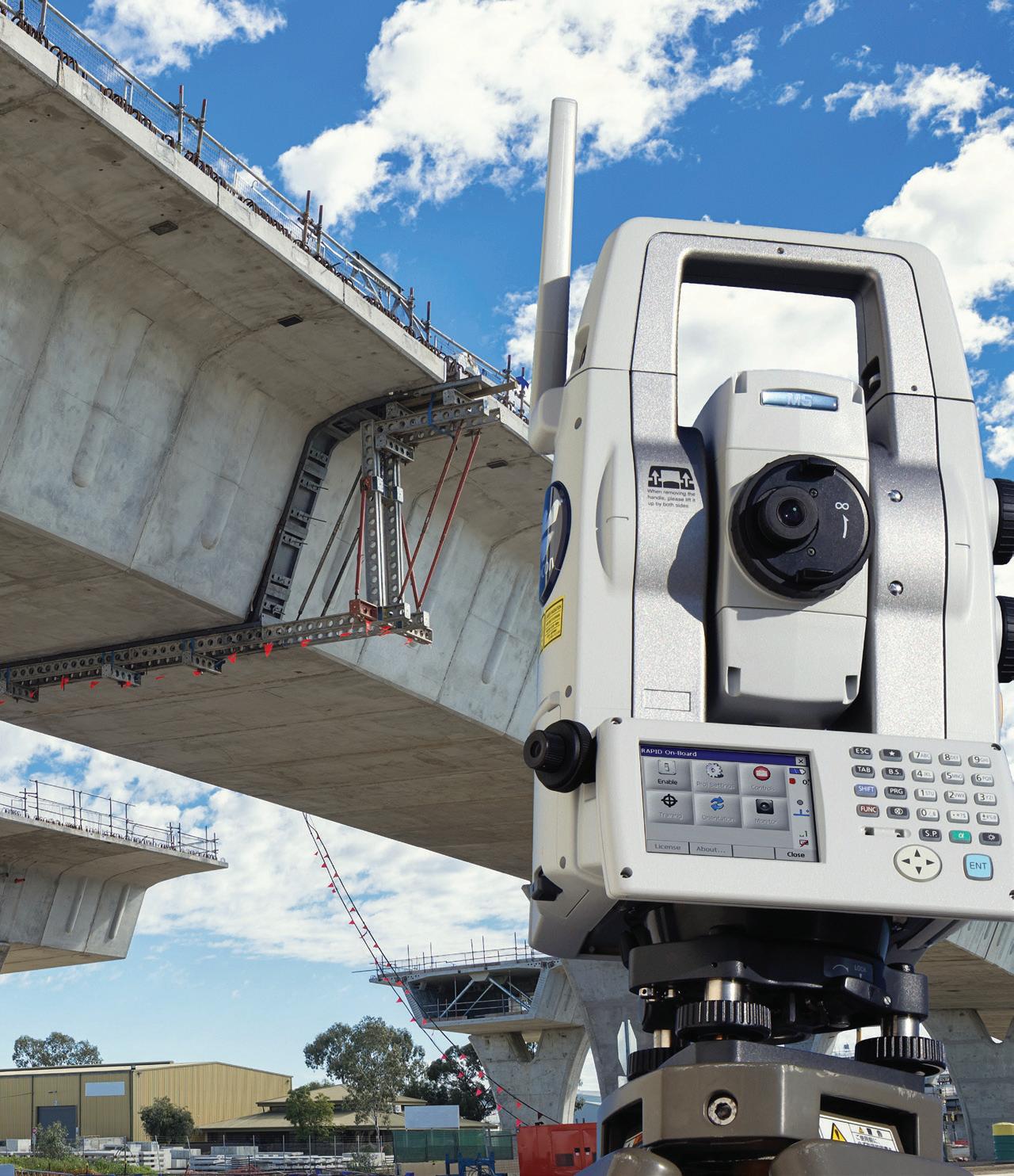
Get in touch today: info@positionpartners.com.au www.positionpartners.com.au Australia • New Zealand • SE Asia 1300 867 266
Topcon Delta, users have a complete workflow solution for all their monitoring needs, including hardware, software and automated alerts. Mitigate risk on your site with this industry-leading platform.






































 Mike Gallacher CEO, Ports Australia
Mike Gallacher CEO, Ports Australia





















































 Aby Sonya Casey, Project Officer – Training, Civil Contractors Federation (CCF)
Aby Sonya Casey, Project Officer – Training, Civil Contractors Federation (CCF)








































































































 by Mike Gallacher, Chief Executive Officer, Ports Australia
by Mike Gallacher, Chief Executive Officer, Ports Australia









